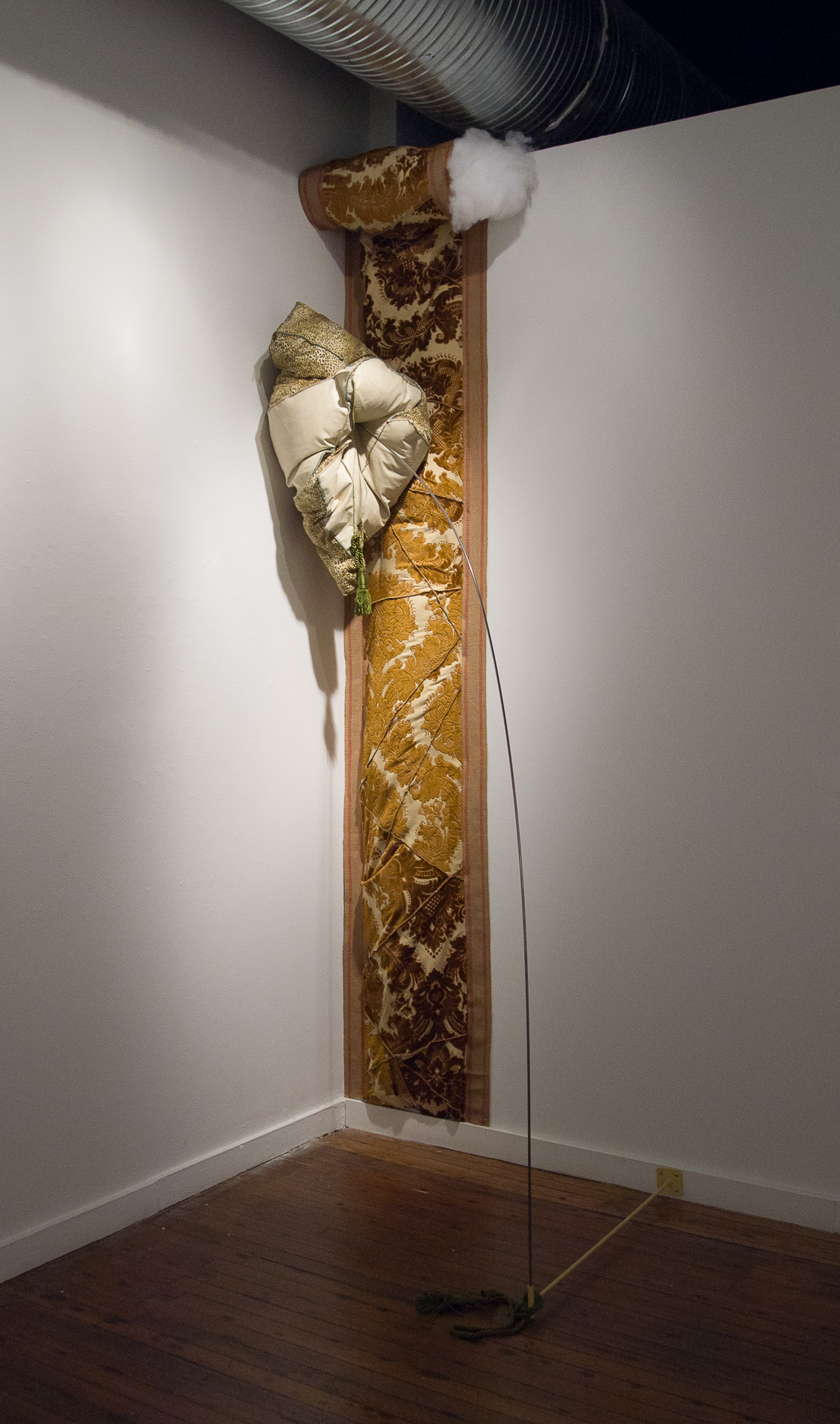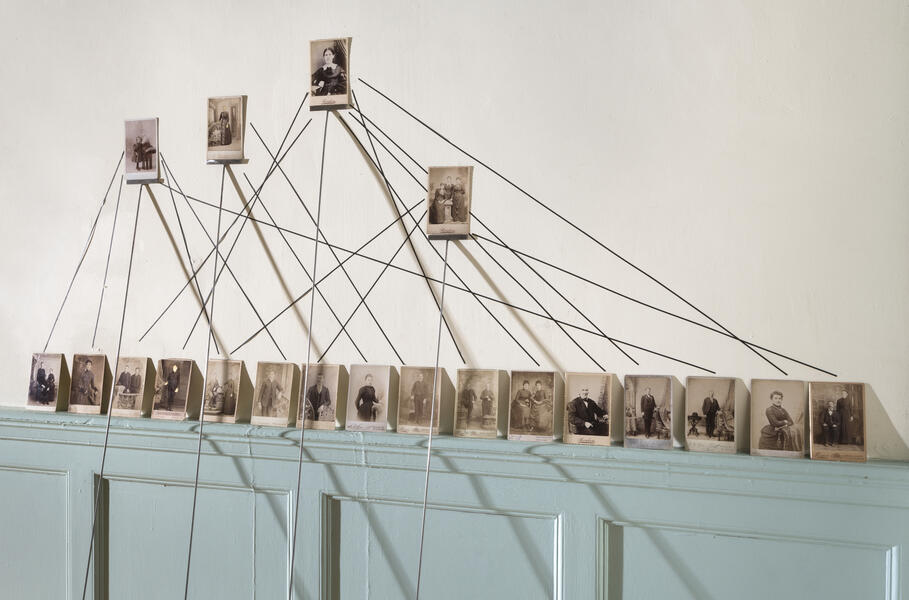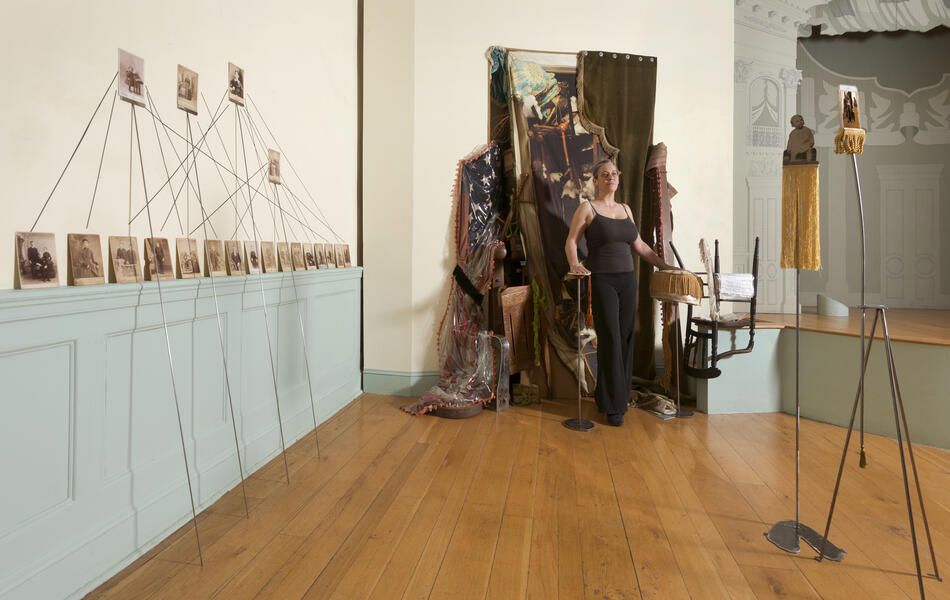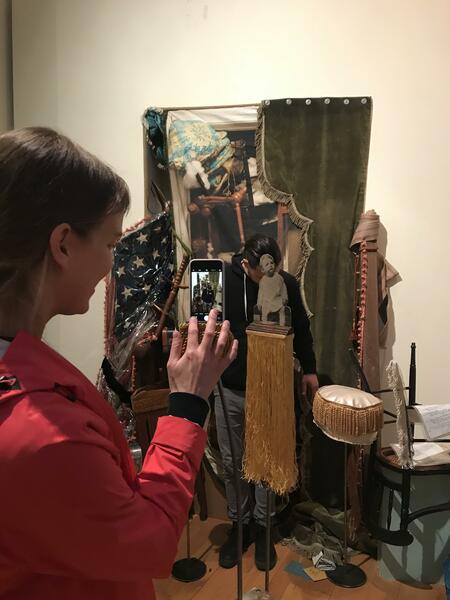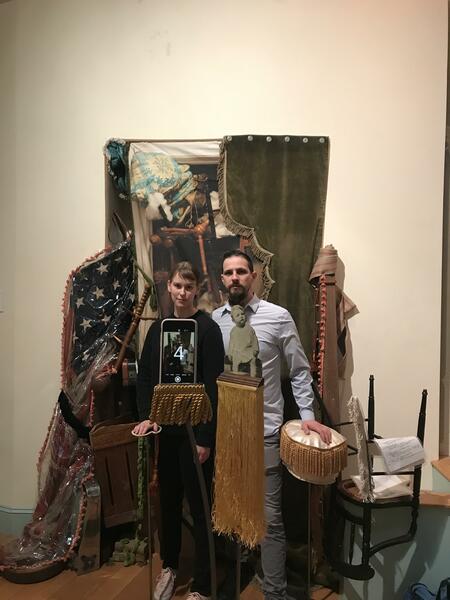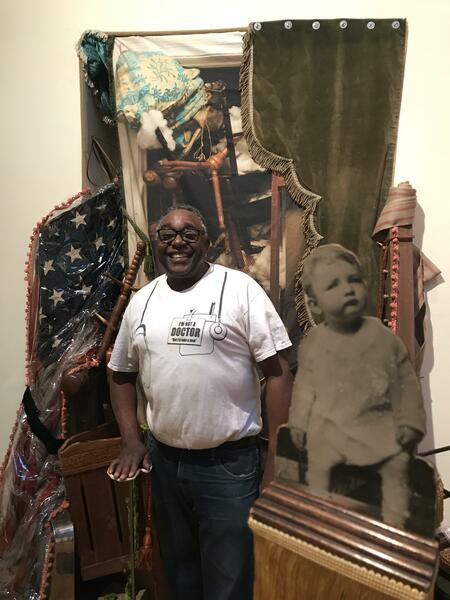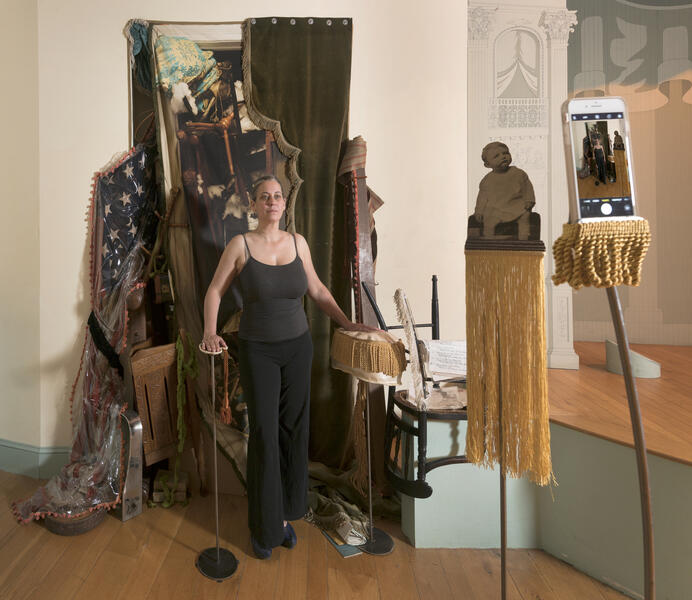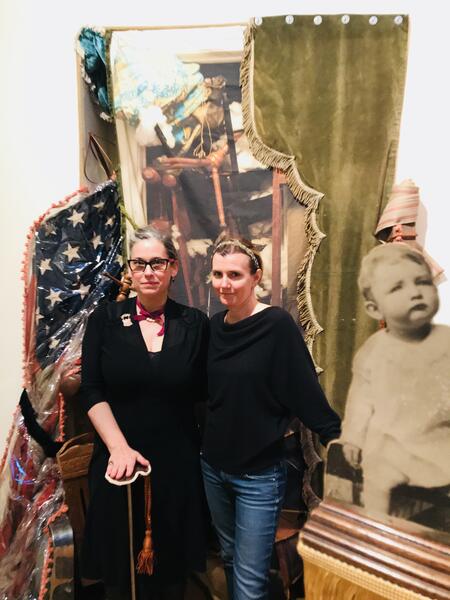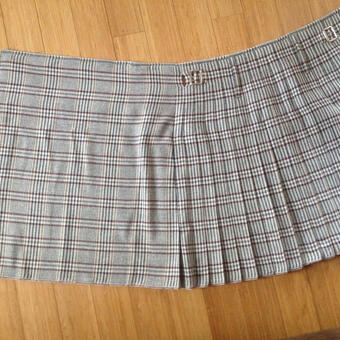Work samples
-
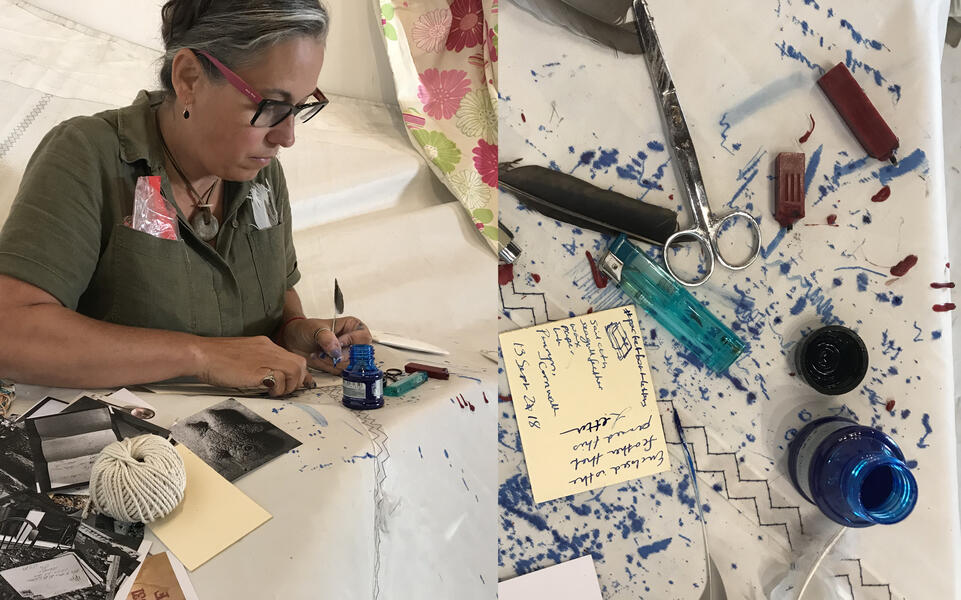 Dear Mom and Pop, We sail todayInvolving a durational performance in Cornwall, UK, noted for international letter carrying boats that sent news around the world for 2 centuries. Envelopes were made with a sail acquired in town, 40 quill pens were made from seagull feathers collected on a walk, and 40 letters were written and sent by land. 2018
Dear Mom and Pop, We sail todayInvolving a durational performance in Cornwall, UK, noted for international letter carrying boats that sent news around the world for 2 centuries. Envelopes were made with a sail acquired in town, 40 quill pens were made from seagull feathers collected on a walk, and 40 letters were written and sent by land. 2018 -
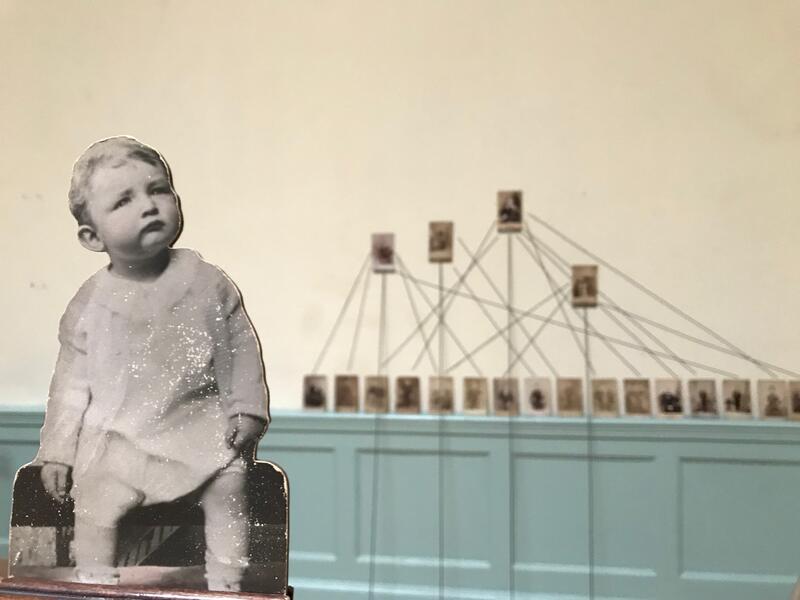 "Alas! how few of us are able to accomplish as much as this apparently senseless oyster, which has actually converted a curse into a blessing, and changed a trial into a treasure!”"Alas! how few of us are able to accomplish as much as this apparently senseless oyster, which has actually converted a curse into a blessing, and changed a trial into a treasure!” detail as I was deinstalling 2018 Title of this work was taken from a family book, Ettie's Leaves from Nature Story-Book 1892 Vol III, by Mrs M A B Kelly #RemarkableSpecimen @stew_artwatson
"Alas! how few of us are able to accomplish as much as this apparently senseless oyster, which has actually converted a curse into a blessing, and changed a trial into a treasure!”"Alas! how few of us are able to accomplish as much as this apparently senseless oyster, which has actually converted a curse into a blessing, and changed a trial into a treasure!” detail as I was deinstalling 2018 Title of this work was taken from a family book, Ettie's Leaves from Nature Story-Book 1892 Vol III, by Mrs M A B Kelly #RemarkableSpecimen @stew_artwatson
About Stewart
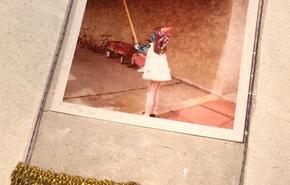
AREA 405 and Oliver Street Studios
AREA 405 and Oliver Street Studios is an ongoing big project to which I have dedicated my life since 2001. It is a 66,000 square foot building of which I am part owner and filled with over 40 artists, a gallery where I am director /sole employee, and where I have built our home.
My first curatorial endeavor was in 1995, working with over 25 artists in a huge space. I was still new to Baltimore, coming here on a whim after traveling around the world for 2 years to begin making art again and the belief that there was space in which to make it.
I didn't know it then, but I now realize the aspect of creating through curating and building community is intrinsically a part of who I am and my way of making.
I feel very strongly about the ability to encourage others to create work and be a catalyst for things to happen. AREA 405 and Oliver Street Studios is the platform I have created where this happens.
I want to thank some very special folks for reminding me that this is part of my practice as much as the sculptures and drawings and installations, for sometimes, when water is all around us, we don't know we are swimming.
AREA 405 is a 7000 square foot artist run space located started in 2003. It is located in a 169 year-old artist-owned warehouse within Baltimore's Station North Arts and Entertainment District where I am committed to showcasing and strengthening the vitality of the arts community within Baltimore and more .
The preserved industrial character of our warehouse provides a particular and distinctive setting for exhibitions as well as extensive studio space for the artists who create here (Oliver Street Studios) and The Station North Tool Library.
AREA 405's mission continues to be to produce, present and promote arts and cultural programming by offering a space for experimentation and collaboration with artists from Baltimore and beyond. AREA 405 also collaborates with scores of cultural and community organizations, raising awareness about and funds for many causes, groups and individuals throughout the region and from around the world since opening its doors in 2003.
Area 405 is an Artist Run space and I'm grateful for being able to have the autonomy to craft a space that is so big and yet incredibly nimble.
-
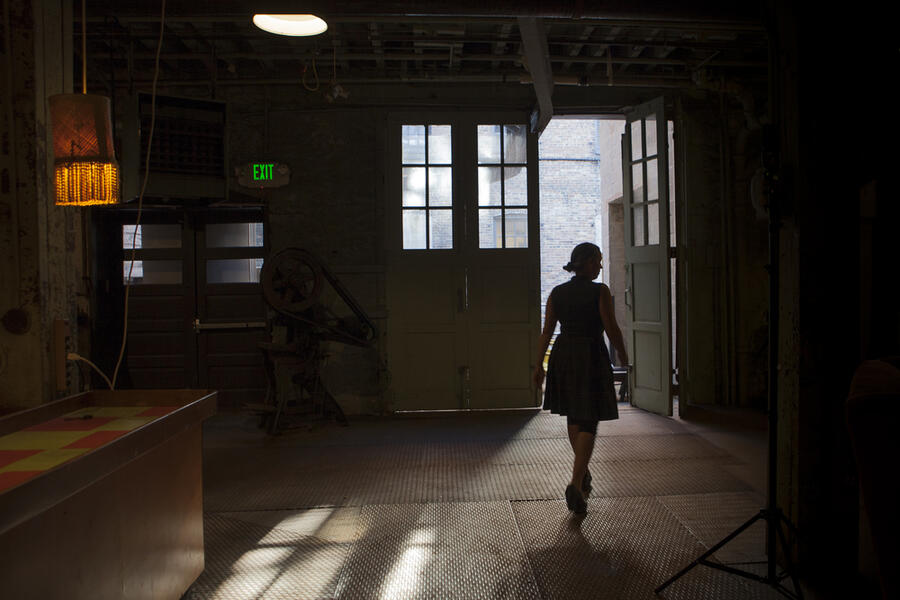 AREA 405 and Oliver Street StudiosPhoto by Elena Volkova interior of AREA 405
AREA 405 and Oliver Street StudiosPhoto by Elena Volkova interior of AREA 405 -
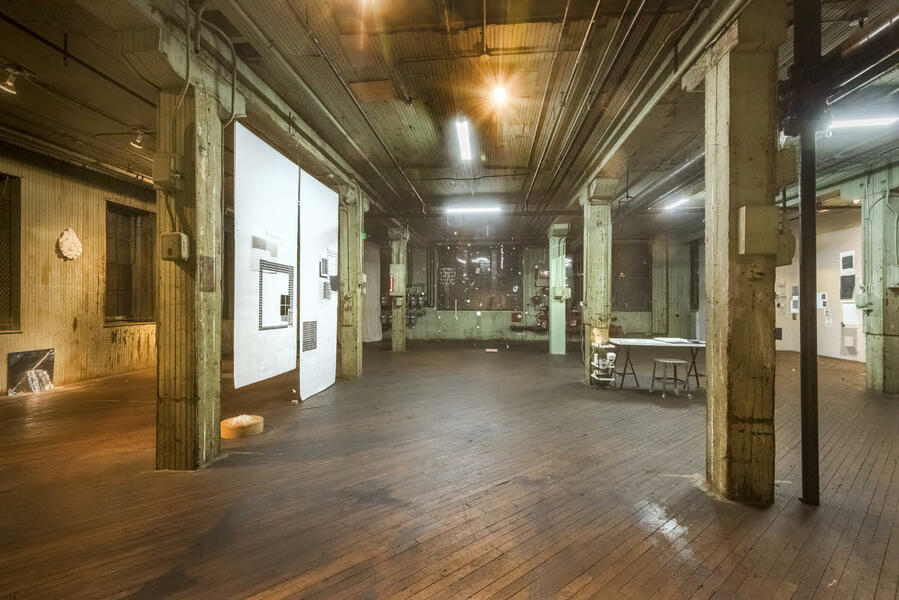 Retreat/ William Lamson/ Lu ZhangRetreat/William Lamson/ Lu Zhang Lu Zhang "Headspace" image courtesy Lu Zhang and Joseph Hyde Winter 2017 Exhibition curated by Stewart Watson A curatorial essay. AREA 405 is approaching the 15th year as an artist run exhibition space, and I have been at this a long time. Early in 2016, I had asked Lu Zhang if she would consider creating new work in AREA 405 for the first in a series I had been considering. I wanted the gallery to be a place of experimentation, connection and balance again. I felt I had lost focus at some point along the way and that AREA 405 should be hosting experimental installations and exhibitions with a tighter lens on just two or three artists with a longer lead time in which they could work to create and connect, being sure to reach farther than the Baltimore region to bring people together. I wasn’t sure who the other artist would be, but I knew I would find the right person eventually, it could not be rushed. On December 2nd, 2016 at 6 am, my friend Nancy hopped on a plane, a change of clothes in our purses, and headed to Miami for a 30-hour long whirl wind trip to ArtBasel. The day had been good to us, - whizzing around, seeing art, bumping into friends, and serendipitously being introduced to William Lamson and his work at Untitled. I was immediately drawn in and imagined Will’s work in AREA 405 and in relation to how Lu works- site responsively, immersive, and with an eye to the natural world, materials varying with each project. I woke up to a message that there had been a tragic fire at an artist warehouse known as Ghost Ship, people were trapped and many lives were lost. It was in Oakland, California, and even as I was in Miami, I knew this tragedy would send shockwaves across the country, to Baltimore, to Station North, to our community. Artists living in Bell Foundry were evicted just 24 hours later. As an owner of a building that serves as a safe space to create, think and experiment, I knew that even considering the work we have done here to be as safe as possible, it wouldn’t be all “fire marshal code safe”. What we have done to protect the people here would not be enough in their eyes. The last 16 years have kept me up at night, makes for hard days, and keep me from relaxing during holidays. I sometimes don’t know what I’m doing this for, when or if it will ever be enough. Then, I find I can present two artists like Lu and Will who are creating compelling work that shares the intention of why this space necessary and why it is relevant to experiment in the safety of a space that falls outside of the ivory towers and not for profits and museums in the first place and I remember.
Retreat/ William Lamson/ Lu ZhangRetreat/William Lamson/ Lu Zhang Lu Zhang "Headspace" image courtesy Lu Zhang and Joseph Hyde Winter 2017 Exhibition curated by Stewart Watson A curatorial essay. AREA 405 is approaching the 15th year as an artist run exhibition space, and I have been at this a long time. Early in 2016, I had asked Lu Zhang if she would consider creating new work in AREA 405 for the first in a series I had been considering. I wanted the gallery to be a place of experimentation, connection and balance again. I felt I had lost focus at some point along the way and that AREA 405 should be hosting experimental installations and exhibitions with a tighter lens on just two or three artists with a longer lead time in which they could work to create and connect, being sure to reach farther than the Baltimore region to bring people together. I wasn’t sure who the other artist would be, but I knew I would find the right person eventually, it could not be rushed. On December 2nd, 2016 at 6 am, my friend Nancy hopped on a plane, a change of clothes in our purses, and headed to Miami for a 30-hour long whirl wind trip to ArtBasel. The day had been good to us, - whizzing around, seeing art, bumping into friends, and serendipitously being introduced to William Lamson and his work at Untitled. I was immediately drawn in and imagined Will’s work in AREA 405 and in relation to how Lu works- site responsively, immersive, and with an eye to the natural world, materials varying with each project. I woke up to a message that there had been a tragic fire at an artist warehouse known as Ghost Ship, people were trapped and many lives were lost. It was in Oakland, California, and even as I was in Miami, I knew this tragedy would send shockwaves across the country, to Baltimore, to Station North, to our community. Artists living in Bell Foundry were evicted just 24 hours later. As an owner of a building that serves as a safe space to create, think and experiment, I knew that even considering the work we have done here to be as safe as possible, it wouldn’t be all “fire marshal code safe”. What we have done to protect the people here would not be enough in their eyes. The last 16 years have kept me up at night, makes for hard days, and keep me from relaxing during holidays. I sometimes don’t know what I’m doing this for, when or if it will ever be enough. Then, I find I can present two artists like Lu and Will who are creating compelling work that shares the intention of why this space necessary and why it is relevant to experiment in the safety of a space that falls outside of the ivory towers and not for profits and museums in the first place and I remember. -
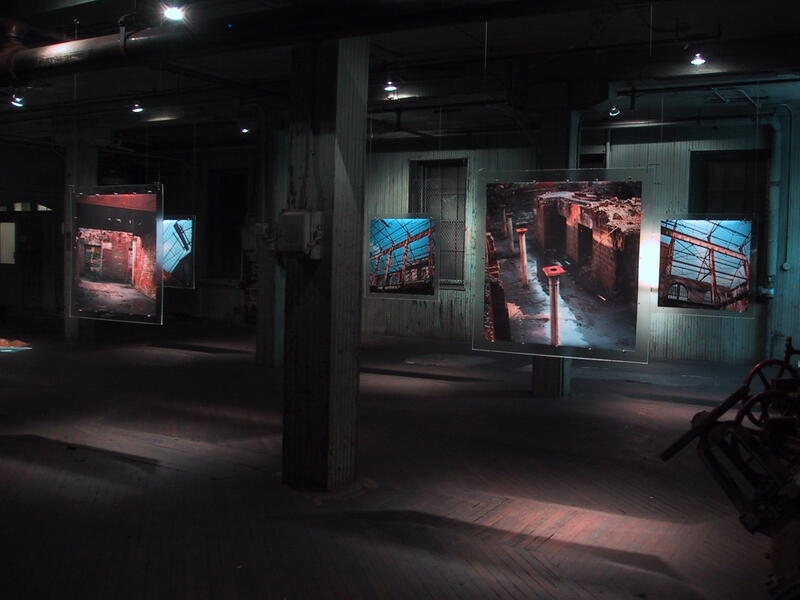 The Flat Earthdigital photographs from the exhibition, The Flat Earth images from Julia Pearson 2004, an early exhibition at AREA 405, co-curated by me and Daniel Sullivan
The Flat Earthdigital photographs from the exhibition, The Flat Earth images from Julia Pearson 2004, an early exhibition at AREA 405, co-curated by me and Daniel Sullivan -
Conventions: roycrosse and Ruth Pettusroycrosse 2011 curator of this exhibition held in 2011 roycrosse and Ruth Pettus are two seasoned, valuable artistic and cultural assets to the fabric of this city. In 2014, we lost Roy to cancer. I am so proud to have been able to curate this exhibition and share the work of these prolific and amazing artists.
-
CASA, The Art of Caringan annual benefit for Baltimore City Children in foster care curator, team lead,exhibition designer, this year, 2018, will be the 8th annual event, raising awareness and hundreds of thousands of dollars for our most at risk city youth.
-
CASA, The Art of CaringThis is an annual benefit for Court Appointed Special Advocates for Children in Foster Care for Baltimore City. (CASA Baltimore City) I am curator, team lead,exhibition designer, this year will be the 8th annual event, raising awareness and hundreds of thousands of dollars for our most at risk city youth. We are able to bring together hundreds of people from throughout the city to support this event. Artists from around the region donate their work to this incredible cause and I curate, exhibition design, and hang upwards of 125 works of art each year for this event.
-
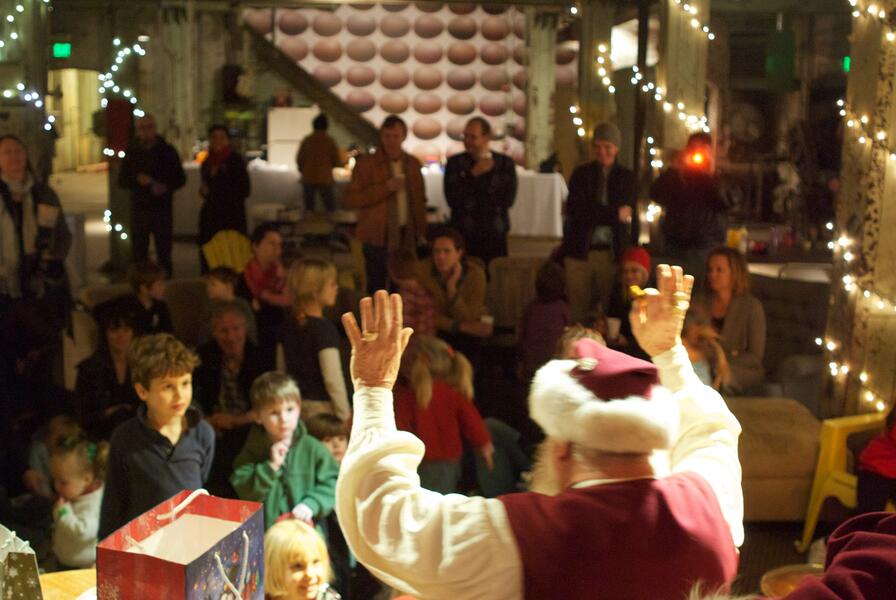 Santa Bobfor a few years, Santa Bob came to share the holiday spirit at 405, and we made it festive, also while raising funds for children in need
Santa Bobfor a few years, Santa Bob came to share the holiday spirit at 405, and we made it festive, also while raising funds for children in need -
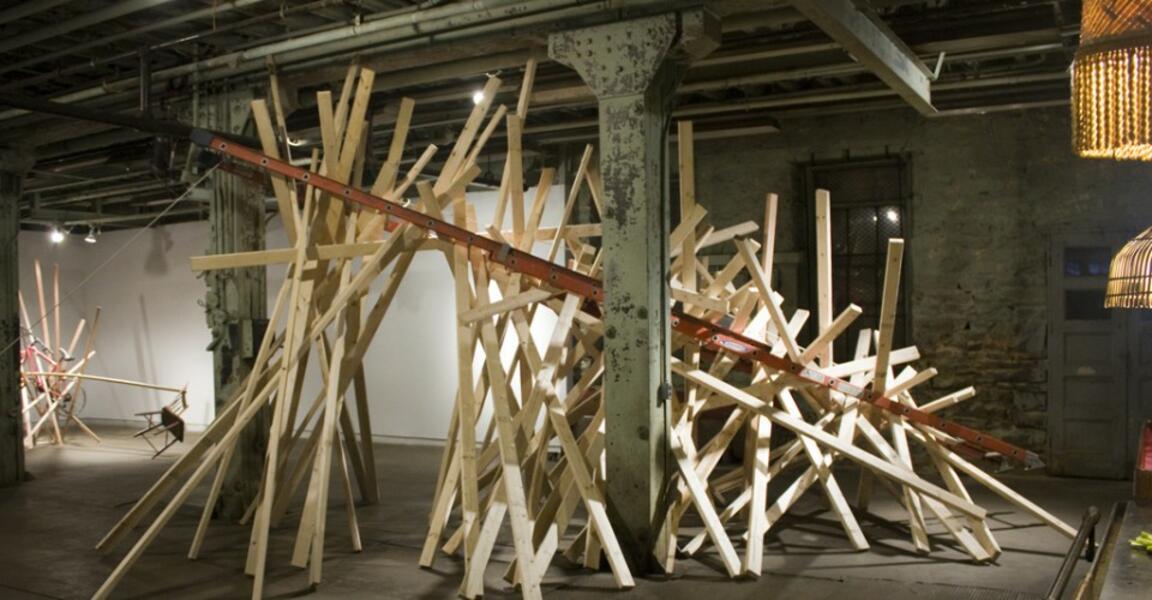 Indirect EffectChristian Benefiel Lacking Code 2015 wood,ladder I co-curated this two person exibition. We hosted a Community Passover Seder in conjunction with the Charm City Tribe while this work was featured
Indirect EffectChristian Benefiel Lacking Code 2015 wood,ladder I co-curated this two person exibition. We hosted a Community Passover Seder in conjunction with the Charm City Tribe while this work was featured -
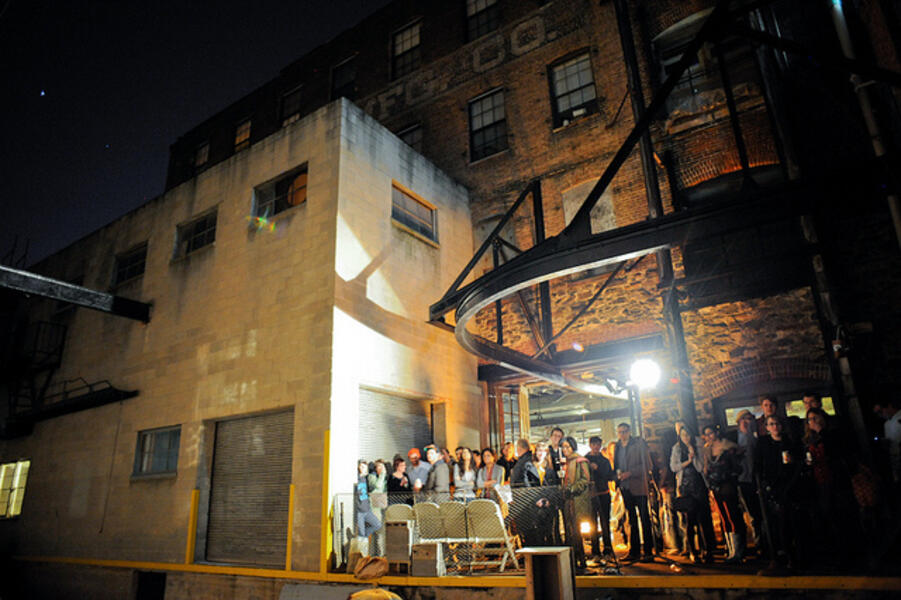 AREA 405 and Oliver Street Studioscommunity is a huge part of AREA 405 and Oliver Street Studios- with over 40 artists and the gallery here, we have so much to be grateful for in creating connections
AREA 405 and Oliver Street Studioscommunity is a huge part of AREA 405 and Oliver Street Studios- with over 40 artists and the gallery here, we have so much to be grateful for in creating connections -
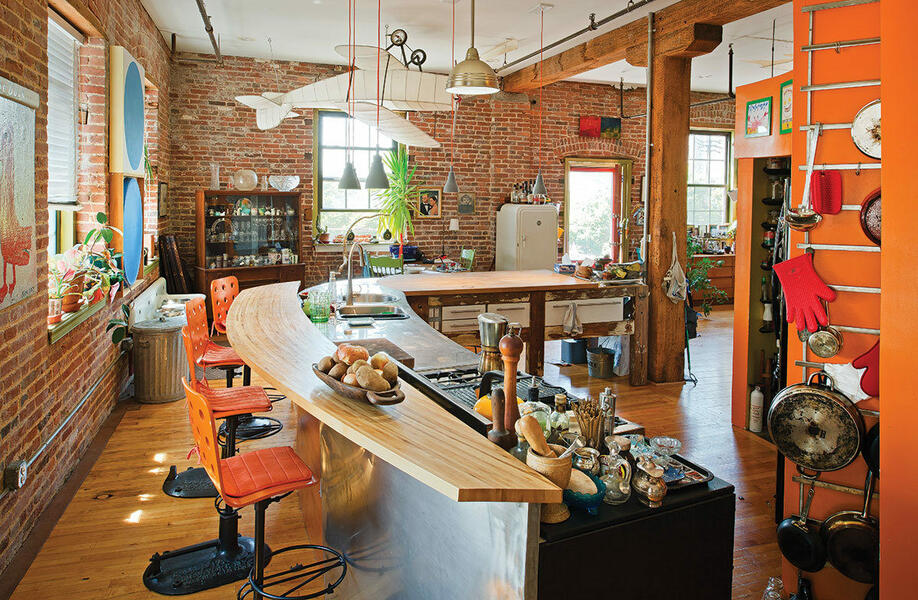 Our Home at Oliver StreetWe have designed and built our space and made it a home - floors, walls ceilings, plumbing, electric, drywall, all of it - from emptying the debris to knocking out the concrete block from the windows and building the kitchen. photograph courtesy Vince Lupo
Our Home at Oliver StreetWe have designed and built our space and made it a home - floors, walls ceilings, plumbing, electric, drywall, all of it - from emptying the debris to knocking out the concrete block from the windows and building the kitchen. photograph courtesy Vince Lupo
Intimate Installations
Each title is found by searching through books -some of which are over 200 years old- that were written in and were owned by my ancestors.
-
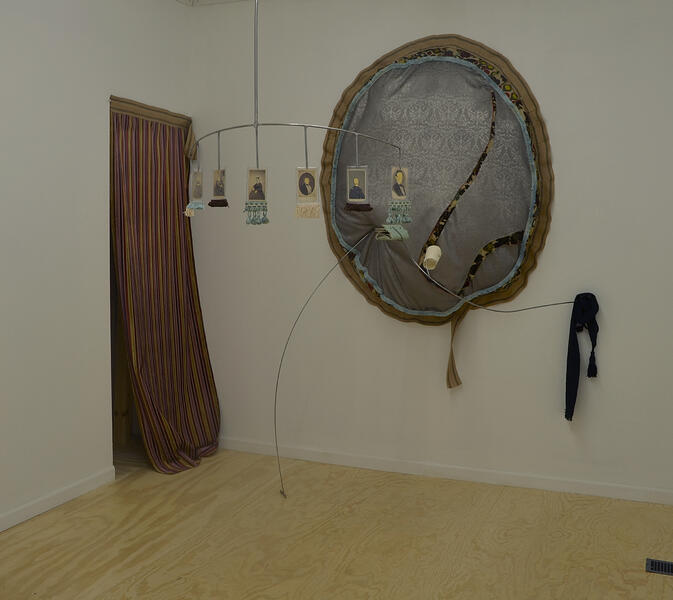 O, thought he, what if I should die like the others? how unprepared!vinyl, upholstery fabric, polyfil, steel, aluminum, graphite, a few of the family photographs and cartes de visites carried by my great great grandfather Watson during The Civil War, 23k gold leaf, his starched cuff, the deed, mourning fabric, thread, gimp, jute, staples, glue, hardware DESCRIPTION: These cartes de visites and photographs were found in my family things and notated that they were carried by my great great grandfather during the Civil War. Noting that each had “DEAD” written on the back next to their names, Lincoln’s portrait which was intertwined with General Burnsides and Mrs Deiffenbacher, one of my more distant relatives, all dead. I appreciate both the humor and thoroughness the hand which had written the word on each of these cards was. We are all, famous or anonymous, subject to the same fate. This piece was not just an opportunity to ponder death and how we memorialize what is important, rather, in placing the faces out but covered with 23k gold, I was staging a portrait session and I thinking about what the subjects meant for the images to capture, and what they may have been able to impart as well. 108”x 122” x 100”
O, thought he, what if I should die like the others? how unprepared!vinyl, upholstery fabric, polyfil, steel, aluminum, graphite, a few of the family photographs and cartes de visites carried by my great great grandfather Watson during The Civil War, 23k gold leaf, his starched cuff, the deed, mourning fabric, thread, gimp, jute, staples, glue, hardware DESCRIPTION: These cartes de visites and photographs were found in my family things and notated that they were carried by my great great grandfather during the Civil War. Noting that each had “DEAD” written on the back next to their names, Lincoln’s portrait which was intertwined with General Burnsides and Mrs Deiffenbacher, one of my more distant relatives, all dead. I appreciate both the humor and thoroughness the hand which had written the word on each of these cards was. We are all, famous or anonymous, subject to the same fate. This piece was not just an opportunity to ponder death and how we memorialize what is important, rather, in placing the faces out but covered with 23k gold, I was staging a portrait session and I thinking about what the subjects meant for the images to capture, and what they may have been able to impart as well. 108”x 122” x 100” -
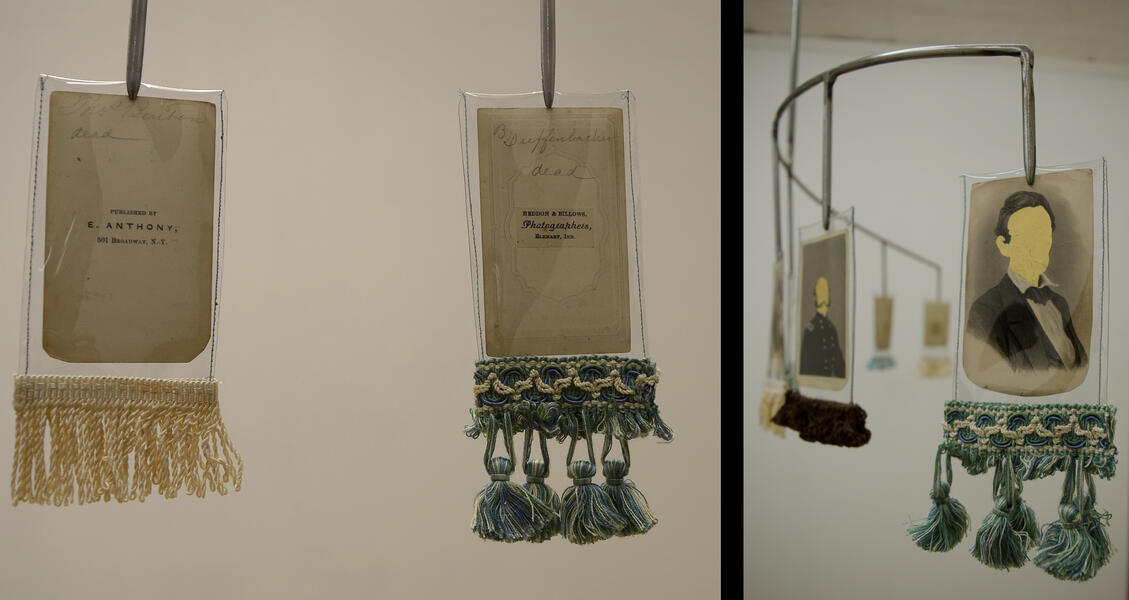 O, thought he, what if I should die like the others? how unprepared! (detail)the carte de visites my great great grandfather carried through the civil war, with 23 karat gold defacing or immortalizing each photograph. "Dead" written on each of the cards by my ancestor
O, thought he, what if I should die like the others? how unprepared! (detail)the carte de visites my great great grandfather carried through the civil war, with 23 karat gold defacing or immortalizing each photograph. "Dead" written on each of the cards by my ancestor -
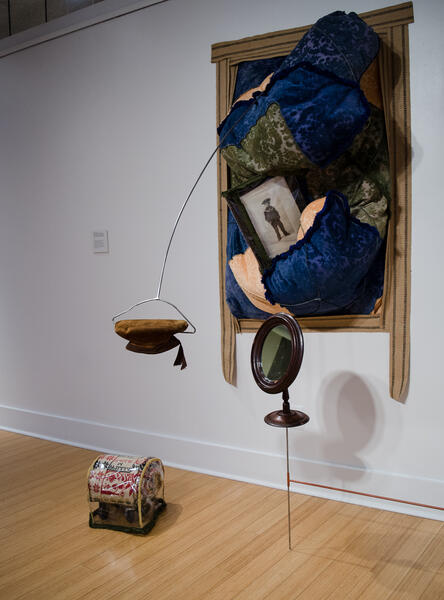 But the lit-tle ba-by man was al-so wise and wit-ty, and he called him-self Od-dy Wad-dle, af-ter a fun-ny lit-tle fel-low that lived in the look-ing-glass.framed photograph of grandfather Bruce Bastress Watson circa 1903, his suede hat, great great grandfather Watson's shaving mirror circa 1860, great great great grandfather Nagle's cotton woven coverlet dated 1841, hand dyed upholstery fabric, polyfil, jute strapping, gimp, vinyl, steel, casters, hardware, magic,glue, thread, pins 108" x 70" x 80" variable
But the lit-tle ba-by man was al-so wise and wit-ty, and he called him-self Od-dy Wad-dle, af-ter a fun-ny lit-tle fel-low that lived in the look-ing-glass.framed photograph of grandfather Bruce Bastress Watson circa 1903, his suede hat, great great grandfather Watson's shaving mirror circa 1860, great great great grandfather Nagle's cotton woven coverlet dated 1841, hand dyed upholstery fabric, polyfil, jute strapping, gimp, vinyl, steel, casters, hardware, magic,glue, thread, pins 108" x 70" x 80" variable -
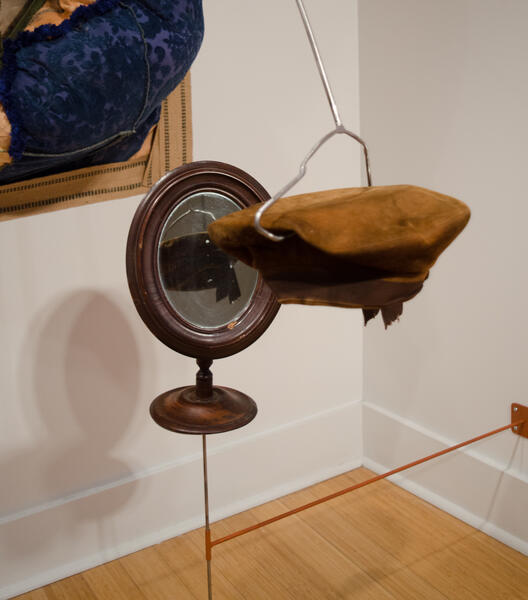 But the lit-tle ba-by man was al-so wise and wit-ty, and he called him-self Od-dy Wad-dle, af-ter a fun-ny lit-tle fel-low that lived in the look-ing-glass. (detail)my grandfather's hat and the mirror
But the lit-tle ba-by man was al-so wise and wit-ty, and he called him-self Od-dy Wad-dle, af-ter a fun-ny lit-tle fel-low that lived in the look-ing-glass. (detail)my grandfather's hat and the mirror -
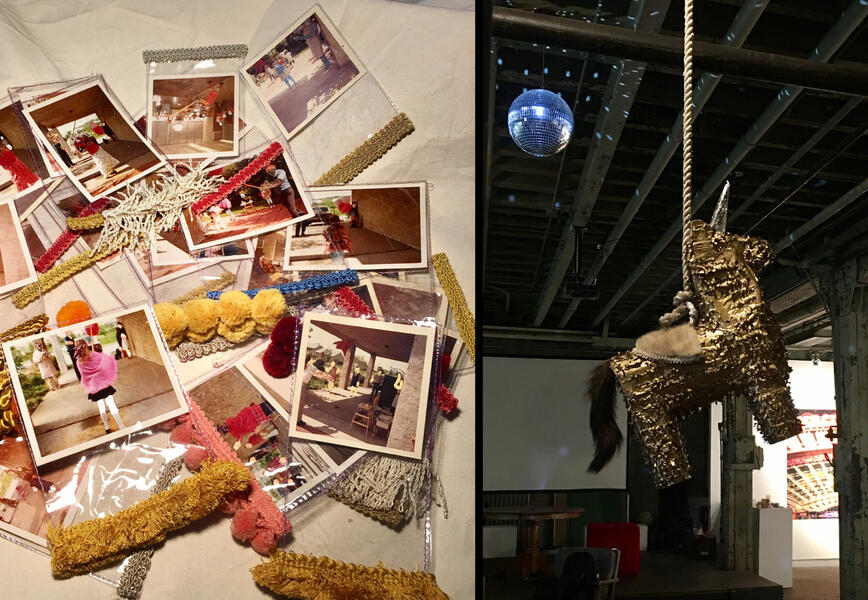 When One of them came in driving a little old mule hitched to a cart and the mule began kicking things to pieces the children squealed with delightWhen One of them came in driving a little old mule hitched to a cart, and the mule began kicking things to pieces, the children squealed with delight 2017 Cardboard Piñata, family photographs (1971-1973), vintage champagne mink & mink tail,23k gold leaf, sterling silver leaf, copper leaf, vinyl, gimp, tassels, glue, thread, spray paint performance ( June 30th, 2017) DESCRIPTION: This piece was for an exhibition that celebrated and critiqued the idea of the art prize, each of us in the exhibition was a finalist for a large regional prize, it seemed fitting to make artwork that spoke to that moment when you swing your hardest at something and miss, or you hit it and realize what’s inside is not what you expected. Upon looking through old family albums, we had many images of our birthday parties hitting piñatas, I made one celebration award object for each artist in the exhibition, and placed it in the golden unicorn. Patrons had a choice as to whether it was just a potential object, or could be broken, finally, children decided they wanted to break it open hoping for candy. To my surprise, they were even more enamored with the art prizes that came out. (stills from performance)
When One of them came in driving a little old mule hitched to a cart and the mule began kicking things to pieces the children squealed with delightWhen One of them came in driving a little old mule hitched to a cart, and the mule began kicking things to pieces, the children squealed with delight 2017 Cardboard Piñata, family photographs (1971-1973), vintage champagne mink & mink tail,23k gold leaf, sterling silver leaf, copper leaf, vinyl, gimp, tassels, glue, thread, spray paint performance ( June 30th, 2017) DESCRIPTION: This piece was for an exhibition that celebrated and critiqued the idea of the art prize, each of us in the exhibition was a finalist for a large regional prize, it seemed fitting to make artwork that spoke to that moment when you swing your hardest at something and miss, or you hit it and realize what’s inside is not what you expected. Upon looking through old family albums, we had many images of our birthday parties hitting piñatas, I made one celebration award object for each artist in the exhibition, and placed it in the golden unicorn. Patrons had a choice as to whether it was just a potential object, or could be broken, finally, children decided they wanted to break it open hoping for candy. To my surprise, they were even more enamored with the art prizes that came out. (stills from performance) -
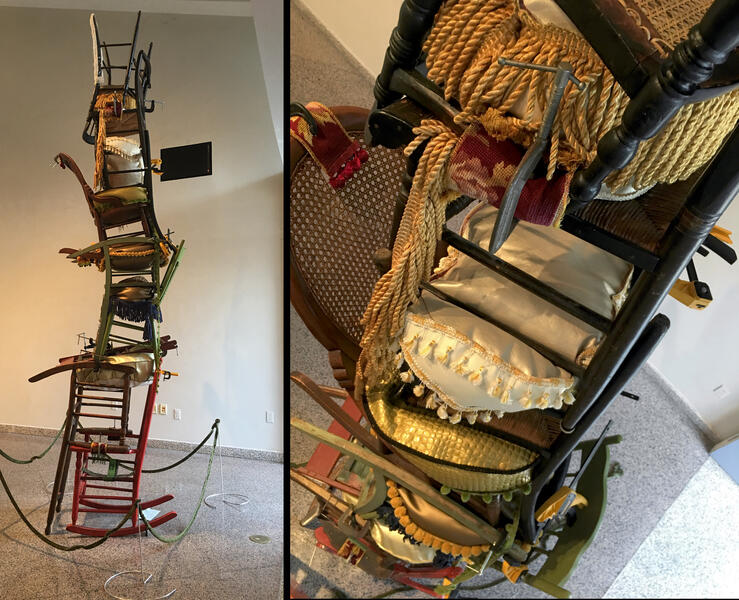 How strange that we should be so eager for the trifles of earth when there are eternal treasures to be securedchairs, (9) The 2 rocking chairs, the folding chair, and dining chair from the cottage ( circa 1900), great grandmother Smith's favourite rocking chair, the important rocker (circa 1880), the 2 Nagle family Hitchcock chairs ( circa 1840), the Watson high chair (circa 1870), the financial reports from 1914 – 1929, vinyl, polyfil, clamps, needlepoint, gimp, tassels, glue thread 180” x 38” x 30” ( approximately) DESCRIPTION: this piece had been on my mind for some time. It is a self-portrait, specifically relating to my spine. The poufs were representative of the degenerated discs in my back, that have been collapsing for the last 15 years, and, the clamps are representative of the actual hardware that is bolting me together from several surgeries, holding me together. I continually look for comfortable places to sit, yet the irony is having all these family chairs that are not necessarily pleasurable to sit in and feeling some compulsion to keep them anyway. These chairs have been stacked upon one another for years in basements and attics and moved around the country for well over a century, it seems only fitting to pay homage with this monolith. (the title of this piece is taken from Triumph of Faith, 1840, a book owned by my great great great great grandmother, Elizabeth Follmer) 2017
How strange that we should be so eager for the trifles of earth when there are eternal treasures to be securedchairs, (9) The 2 rocking chairs, the folding chair, and dining chair from the cottage ( circa 1900), great grandmother Smith's favourite rocking chair, the important rocker (circa 1880), the 2 Nagle family Hitchcock chairs ( circa 1840), the Watson high chair (circa 1870), the financial reports from 1914 – 1929, vinyl, polyfil, clamps, needlepoint, gimp, tassels, glue thread 180” x 38” x 30” ( approximately) DESCRIPTION: this piece had been on my mind for some time. It is a self-portrait, specifically relating to my spine. The poufs were representative of the degenerated discs in my back, that have been collapsing for the last 15 years, and, the clamps are representative of the actual hardware that is bolting me together from several surgeries, holding me together. I continually look for comfortable places to sit, yet the irony is having all these family chairs that are not necessarily pleasurable to sit in and feeling some compulsion to keep them anyway. These chairs have been stacked upon one another for years in basements and attics and moved around the country for well over a century, it seems only fitting to pay homage with this monolith. (the title of this piece is taken from Triumph of Faith, 1840, a book owned by my great great great great grandmother, Elizabeth Follmer) 2017 -
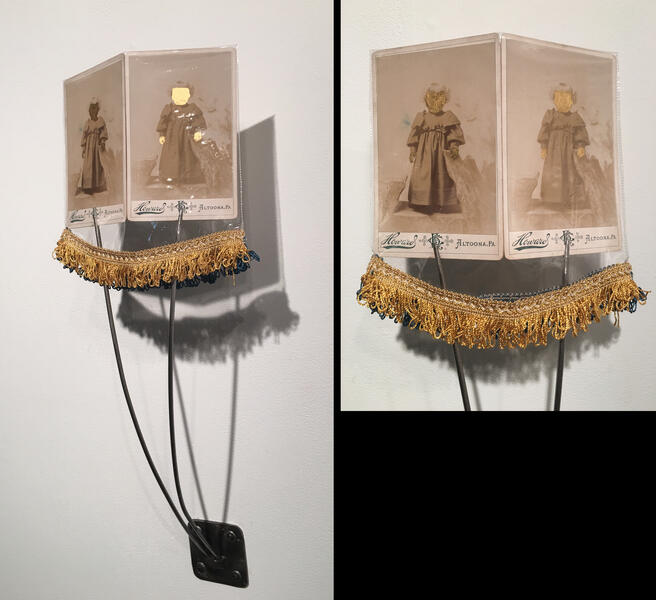 " I wish I could wear my pretty clothes all the time mama! O, I wish I could!"2016 Two identical original photographs of my grandmother, 1895, (age 3), 23k gold leaf, steel, vinyl, thread, gimp 20" x11" x 5”
" I wish I could wear my pretty clothes all the time mama! O, I wish I could!"2016 Two identical original photographs of my grandmother, 1895, (age 3), 23k gold leaf, steel, vinyl, thread, gimp 20" x11" x 5” -
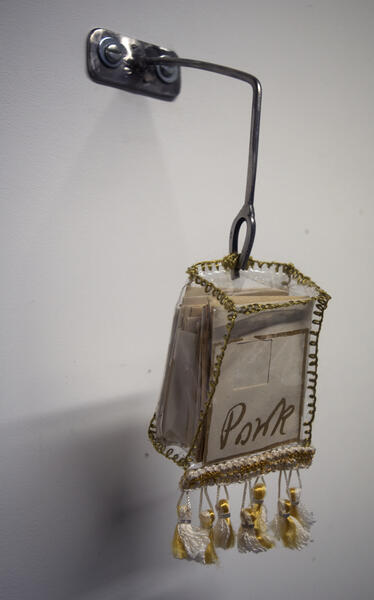 redacted giltMy father and I have written POWK in our letters to one another for as long as I can remember, he wrote it to his father, but until I began to read other family corresponences, I didn't know how far it went back- now 5 generations. I removed the word from these letters from my great grandfather to my grandfather after reading them 1919-1926, vinyl, 23k gold leaf, silk , tassels, steel 13" x 3" x 4" 2015
redacted giltMy father and I have written POWK in our letters to one another for as long as I can remember, he wrote it to his father, but until I began to read other family corresponences, I didn't know how far it went back- now 5 generations. I removed the word from these letters from my great grandfather to my grandfather after reading them 1919-1926, vinyl, 23k gold leaf, silk , tassels, steel 13" x 3" x 4" 2015 -
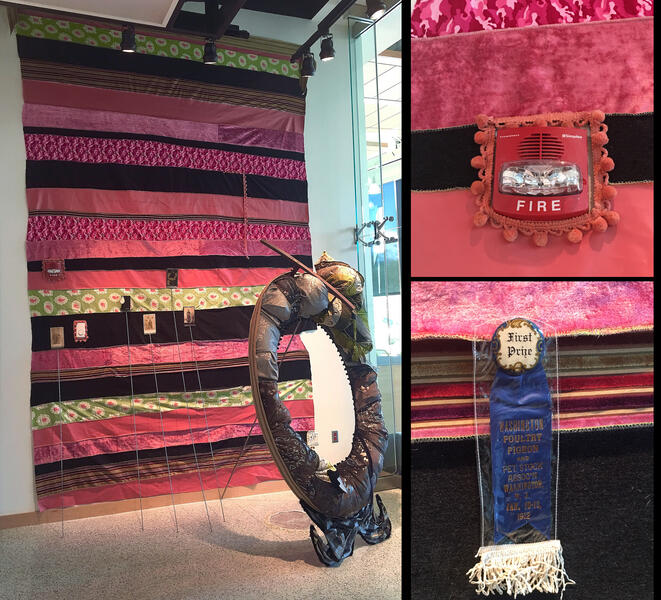 To understand these things completely, one must know of chemistry and vegetable anatomy*, - which we do not propose here to teach.2016 Upholstery fabric, vinyl, part of Watson family chair (circa 1865), Watson ancestral photographs (circa 1870), 23k gold leaf, Little death notice, great grandfather's Blue ribbon, grandfather Watson's unwritten notepad (1932), velvet mourning ribbon,wood, steel, gimp, jute, tassels, glue, staples, thread 160” x 90” x 120” variable
To understand these things completely, one must know of chemistry and vegetable anatomy*, - which we do not propose here to teach.2016 Upholstery fabric, vinyl, part of Watson family chair (circa 1865), Watson ancestral photographs (circa 1870), 23k gold leaf, Little death notice, great grandfather's Blue ribbon, grandfather Watson's unwritten notepad (1932), velvet mourning ribbon,wood, steel, gimp, jute, tassels, glue, staples, thread 160” x 90” x 120” variable -
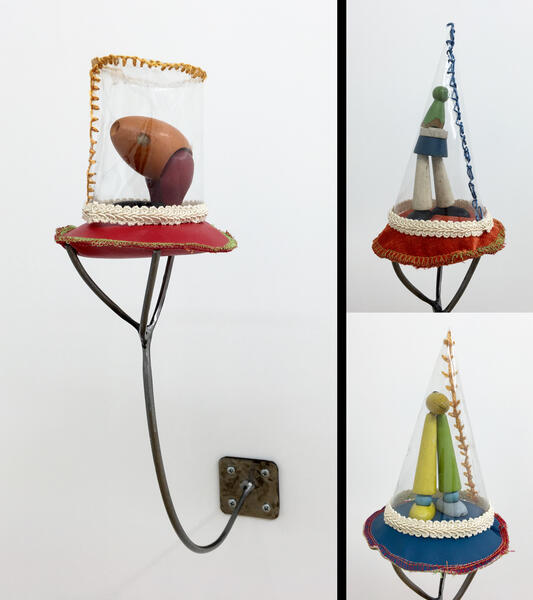 They usually try to escape by running very fastredesigned wooden toys that had been my father's (1935), vinyl,steel,polyfil,velvet, silk, wax 19"x 4" x 4" approximately the steel armatures are made to the proportionate size of my arm 2015
They usually try to escape by running very fastredesigned wooden toys that had been my father's (1935), vinyl,steel,polyfil,velvet, silk, wax 19"x 4" x 4" approximately the steel armatures are made to the proportionate size of my arm 2015
Centennial of The Everyday ( collaborative project with Lauren Frances Adams)
Centennial of the Everyday is a year long collaborative project by artists Stewart Watson and Lauren Frances Adams. 7 people connected to Gadsby’s Tavern Museum were found and interviewed, with a special emphasis on working with women and people of color. Their personal stories of place and family history connect to broader themes of belonging, work, identity, and genealogy. Each interview resulted in creating a sculptural installation in the ballroom.
In 1917, the Metropolitan Museum of Art in New York purchased this room’s decorative woodwork and installed it in their American Wing. Here, the artists acknowledge the centennial of its acquisition by using furniture borrowed from the interviewees. The room is staged similar to how The Met uses the “Alexandria Ballroom” as a staged backdrop for fine domestic furnishings of the Federal period.
A Particular Provenance is a reference to the provenance, or origin and record of ownership, of museum objects. Often, museums lack the details about the individual who owned or made the object because of the absence of historical documentation. By actively including living, everyday people, the viewer is invited to investigate these sculptural storytelling portraits for visual clues related to each individual’s identity (such as their favorite flora, their profession, or their hobbies) and their personal connection to Gadsby’s Tavern Museum.
Lauren Frances Adams and Stewart Watson's collaborative immersive work was featured throughout Gadsby's Tavern Museum in Alexandria, VA from May 2017- September 2017.
Images courtesy Vince Lupo
-
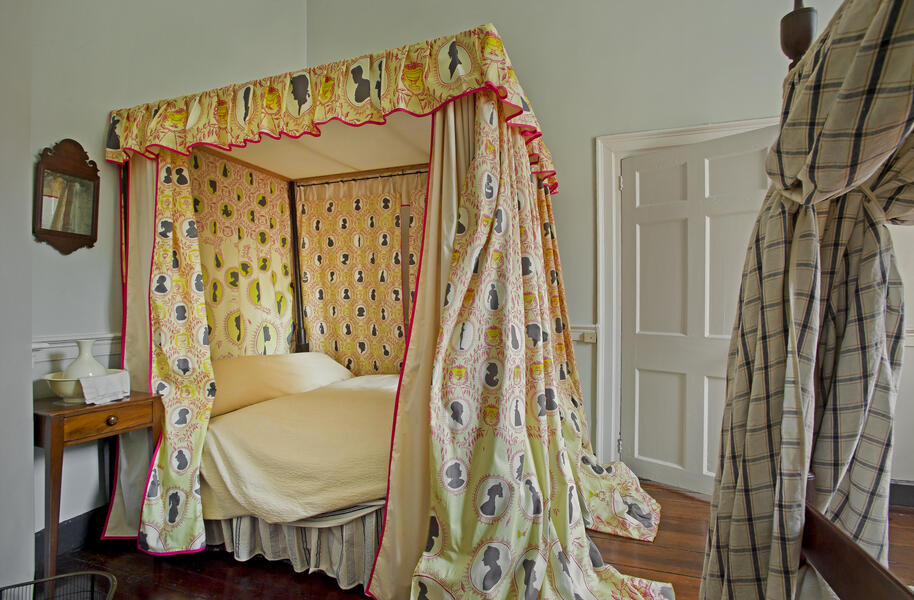 Not on ViewNot on View Custom designed textile on historic canopy bed The Female Stranger is a local legend passed down over 100 years. While the details change depending upon who you ask, it revolves around a gravely ill woman who arrived at this hotel in 1816 and passed away. The only evidence remaining is a tombstone in St. Paul’s Episcopal Church Cemetery “To the Memory of a Female Stranger.” In the spirit of the Female Stranger’s shifting biography, this textile pattern features silhouettes of anonymous women, many found within the Metropolitan Museum of Art’s collection: · Slave belonging to Mrs. Oyley · Peruvian woman · Young Girl of African Descent by Powell · Madame X by Sargent · Woman, left profile, by Walker Evans · Slave belonging to Mr. Dalman · Girl with Dog · Silhouette image of a Kabuki actor · Relief of a head of woman in ivory · Archaic Greek terracotta woman 5th c. BC · 19th c. German Ornament with Profile Portrait · Young Woman Praying by Henner · Profile of a woman with necrosis of the nose by Bisson · Woman in White by Picasso · From the Girls and Children series promoting Our Little Beauties Cigarettes for Allen & Ginter brand tobacco products The textile’s pattern is inspired by a historic George Washington centennial pattern from 1876 in the Met Museum’s collection. Fabrication assistance by Amber Whitehead
Not on ViewNot on View Custom designed textile on historic canopy bed The Female Stranger is a local legend passed down over 100 years. While the details change depending upon who you ask, it revolves around a gravely ill woman who arrived at this hotel in 1816 and passed away. The only evidence remaining is a tombstone in St. Paul’s Episcopal Church Cemetery “To the Memory of a Female Stranger.” In the spirit of the Female Stranger’s shifting biography, this textile pattern features silhouettes of anonymous women, many found within the Metropolitan Museum of Art’s collection: · Slave belonging to Mrs. Oyley · Peruvian woman · Young Girl of African Descent by Powell · Madame X by Sargent · Woman, left profile, by Walker Evans · Slave belonging to Mr. Dalman · Girl with Dog · Silhouette image of a Kabuki actor · Relief of a head of woman in ivory · Archaic Greek terracotta woman 5th c. BC · 19th c. German Ornament with Profile Portrait · Young Woman Praying by Henner · Profile of a woman with necrosis of the nose by Bisson · Woman in White by Picasso · From the Girls and Children series promoting Our Little Beauties Cigarettes for Allen & Ginter brand tobacco products The textile’s pattern is inspired by a historic George Washington centennial pattern from 1876 in the Met Museum’s collection. Fabrication assistance by Amber Whitehead -
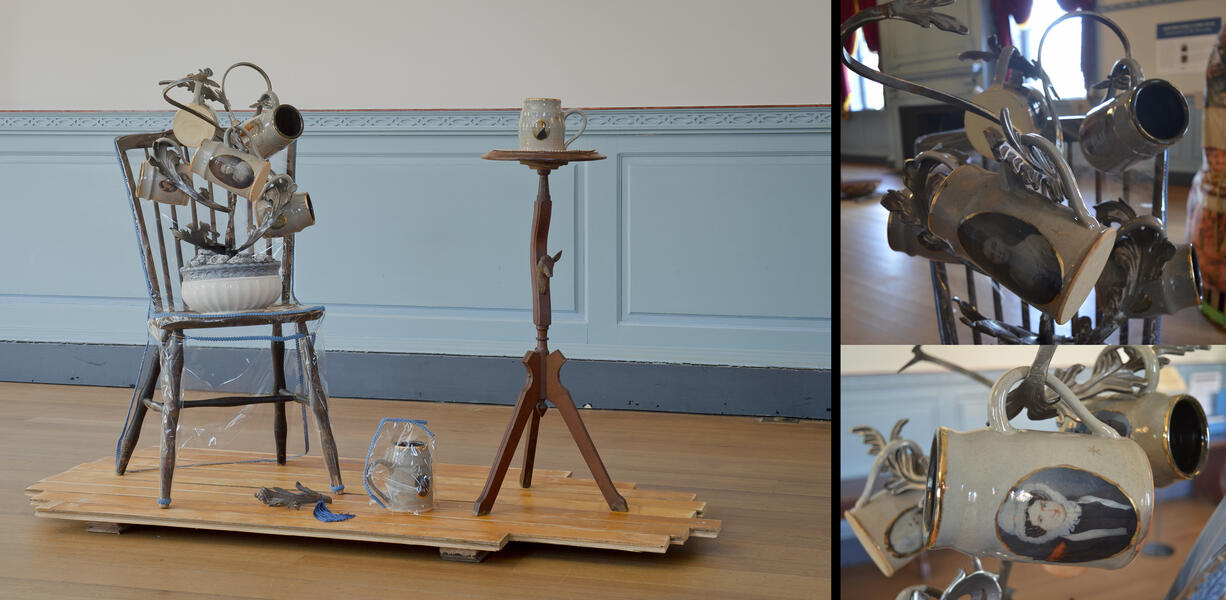 A Particular Provenance: Joan SereyskyJoan Sereysky, Scarsdale, New York Early 20th century spindle back chair Joan is the 3x great granddaughter of Provey Norris and John Gadsby. She has always known of her relationship to the Gadsbys, being brought up with the knowledge of a long legacy and ultimately becoming the caretaker of family objects. Some of these family portraits can be found on the tankards -- a humorous play on the mugs and ornaments with famous politicians from American history for sale in many museum gift shops. She is a volunteer clown, a cow enthusiast, a mother, a genealogist and a curator of family things. Her favorite flora is the acanthus. Gadsby & Norris family ancestral portrait stoneware tankards (fabricated by Jani Hileman), steel, Eastlake plant stand on loan from the artists, vinyl, ceramic, gimp, thread, stones, tassels Centennial of the Everyday is a collaboration of Lauren Frances Adams and Stewart Watson images courtesy Vince Lupo
A Particular Provenance: Joan SereyskyJoan Sereysky, Scarsdale, New York Early 20th century spindle back chair Joan is the 3x great granddaughter of Provey Norris and John Gadsby. She has always known of her relationship to the Gadsbys, being brought up with the knowledge of a long legacy and ultimately becoming the caretaker of family objects. Some of these family portraits can be found on the tankards -- a humorous play on the mugs and ornaments with famous politicians from American history for sale in many museum gift shops. She is a volunteer clown, a cow enthusiast, a mother, a genealogist and a curator of family things. Her favorite flora is the acanthus. Gadsby & Norris family ancestral portrait stoneware tankards (fabricated by Jani Hileman), steel, Eastlake plant stand on loan from the artists, vinyl, ceramic, gimp, thread, stones, tassels Centennial of the Everyday is a collaboration of Lauren Frances Adams and Stewart Watson images courtesy Vince Lupo -
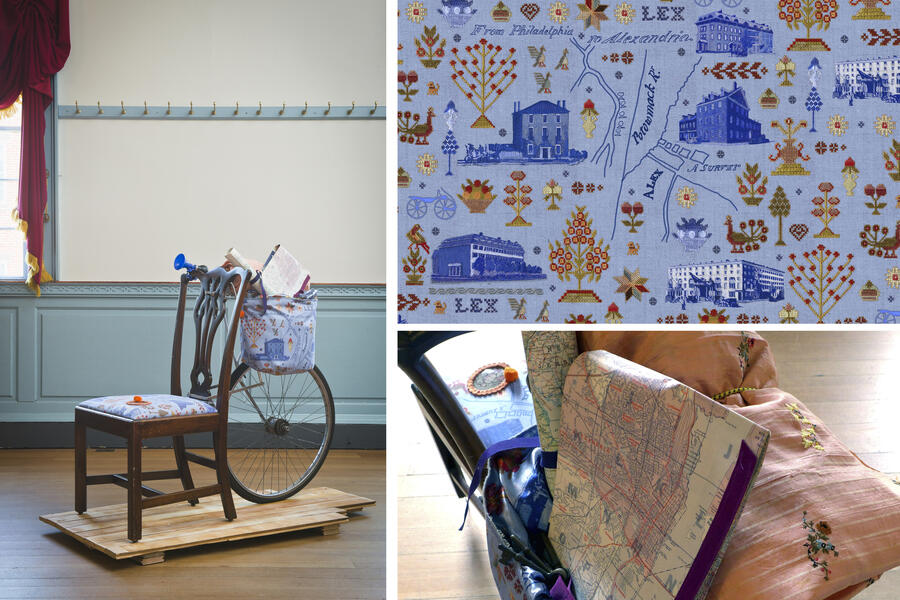 A Particular Provenance :Lex PowersLex Powers, Philadelphia, Pennsylvania Mid 20th century Chippendale chair Lex is the 5x great grandson of Provey Norris and John Gadsby, but did not know this until the artists contacted him. He is a city planner who is committed to traffic calming and urban design that is pedestrian-forward. The sculpture resembles a bicycle and is outfitted with patterns representing the numerous buildings owned and occupied by John Gadsby, a nod to Lex’s professional commitment to urban design. His grandmother, to whom this chair belonged, used to encourage committing poems to memory. He can still remember and recite them. He is engaged to be married. His favorite flora is forsythia, which is a golden hue that complements his favorite color, blue. Custom designed fabrics, early 19th century silk with embroidery gifted by other Gadsby descendant, steel, bicycle rack, hardware, horn, antique compasses, maps, keys, wheel, vinyl, gimp Centennial of the Everyday is a collaboration of Lauren Frances Adams and Stewart Watson images courtesy Vince Lupo
A Particular Provenance :Lex PowersLex Powers, Philadelphia, Pennsylvania Mid 20th century Chippendale chair Lex is the 5x great grandson of Provey Norris and John Gadsby, but did not know this until the artists contacted him. He is a city planner who is committed to traffic calming and urban design that is pedestrian-forward. The sculpture resembles a bicycle and is outfitted with patterns representing the numerous buildings owned and occupied by John Gadsby, a nod to Lex’s professional commitment to urban design. His grandmother, to whom this chair belonged, used to encourage committing poems to memory. He can still remember and recite them. He is engaged to be married. His favorite flora is forsythia, which is a golden hue that complements his favorite color, blue. Custom designed fabrics, early 19th century silk with embroidery gifted by other Gadsby descendant, steel, bicycle rack, hardware, horn, antique compasses, maps, keys, wheel, vinyl, gimp Centennial of the Everyday is a collaboration of Lauren Frances Adams and Stewart Watson images courtesy Vince Lupo -
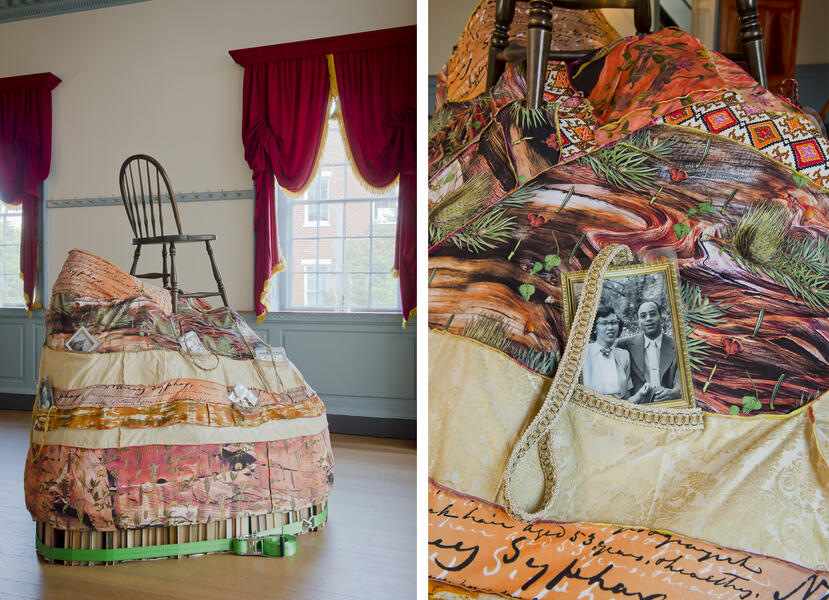 A Particular Provenance: Stephen HammondStephen Hammond, Sterling, Virginia Mid 20th century Windsor chair Stephen is the 3x great grandson of Nancy Syphax, who was enslaved by Provey Norris and John Gadsby. He is a retired geologist after a 40-year career with the U.S Geological Survey, a father, and a passionate family genealogist. He was born and raised in Denver, Colorado, and moving to Virginia has heightened his genealogical explorations, which he also travels to New Orleans to conduct. This sculpture visually connects genealogy to geology -- the form references layers of rock in the shape of a mountain peak. The bedrock of books illustrates the importance of education in Stephen’s family, grounded by his grandmother, Zipporah, who was the first black valedictorian in a Denver high school, and kindled by his cousin Estrelda. Stephen grew up a voracious reader. His favorite flora are the vinca flower, as well as the Bristlecone pine, one of the oldest living organisms on the planet and is found in one of his favorite National Parks, Great Basin in Nevada. Custom designed fabrics, steel, books, fabrics, foam, polyfil, thread, gimp, tassels, hardware, ratcheting strap, and family ephemera/photos Centennial of the Everyday is a collaboration of Lauren Frances Adams and Stewart Watson images courtesy Vince Lupo
A Particular Provenance: Stephen HammondStephen Hammond, Sterling, Virginia Mid 20th century Windsor chair Stephen is the 3x great grandson of Nancy Syphax, who was enslaved by Provey Norris and John Gadsby. He is a retired geologist after a 40-year career with the U.S Geological Survey, a father, and a passionate family genealogist. He was born and raised in Denver, Colorado, and moving to Virginia has heightened his genealogical explorations, which he also travels to New Orleans to conduct. This sculpture visually connects genealogy to geology -- the form references layers of rock in the shape of a mountain peak. The bedrock of books illustrates the importance of education in Stephen’s family, grounded by his grandmother, Zipporah, who was the first black valedictorian in a Denver high school, and kindled by his cousin Estrelda. Stephen grew up a voracious reader. His favorite flora are the vinca flower, as well as the Bristlecone pine, one of the oldest living organisms on the planet and is found in one of his favorite National Parks, Great Basin in Nevada. Custom designed fabrics, steel, books, fabrics, foam, polyfil, thread, gimp, tassels, hardware, ratcheting strap, and family ephemera/photos Centennial of the Everyday is a collaboration of Lauren Frances Adams and Stewart Watson images courtesy Vince Lupo -
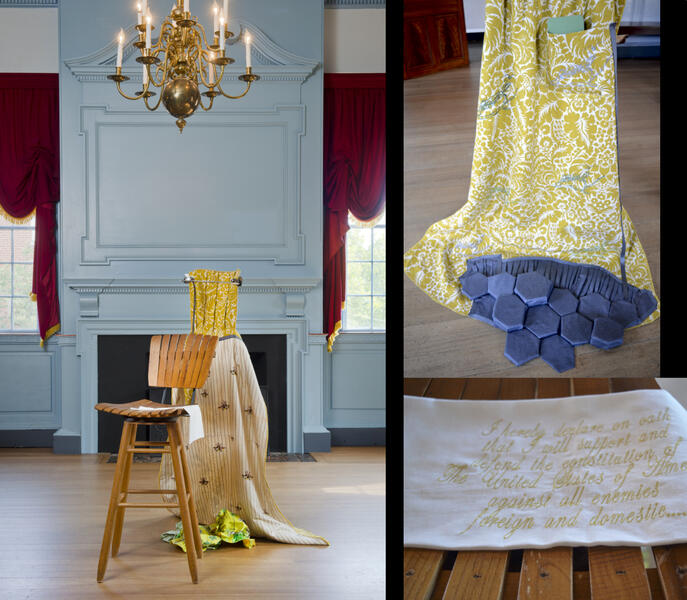 A Particular Provenance :Tracy LoughlinTracy Loughlin, Alexandria, Virginia Late 20th century kitchen perch Tracy is an Irish born American immigrant and a 20 year employee of Gadsby’s Tavern Restaurant. She is a mother of two, a co-worker, a manager at the restaurant, a gardener, a once Dolly Madison reenactor, and a leader. Her favorite natural site is the Giant’s Causeway (represented in images on the bar maid’s hat and as columnar basalt forms on her fabric apron), where she spends time when she returns to Ireland to visit relatives. Her favorite flora can be found in her domestic garden and her favorite animal is a praying mantis. Vintage screen printed linen, digital embroidery, custom designed cotton fabric, steel, foam, glue, notions, thread, 18th century silk with hand embroidery gifted by Gadsby descendent, hardware ( Tracy has since taken the oath and become a US Citizen and is expecting another daughter in early 2018, we are so thrilled for her) Centennial of the Everyday is a collaboration of Lauren Frances Adams and Stewart Watson images courtesy Vince Lupo
A Particular Provenance :Tracy LoughlinTracy Loughlin, Alexandria, Virginia Late 20th century kitchen perch Tracy is an Irish born American immigrant and a 20 year employee of Gadsby’s Tavern Restaurant. She is a mother of two, a co-worker, a manager at the restaurant, a gardener, a once Dolly Madison reenactor, and a leader. Her favorite natural site is the Giant’s Causeway (represented in images on the bar maid’s hat and as columnar basalt forms on her fabric apron), where she spends time when she returns to Ireland to visit relatives. Her favorite flora can be found in her domestic garden and her favorite animal is a praying mantis. Vintage screen printed linen, digital embroidery, custom designed cotton fabric, steel, foam, glue, notions, thread, 18th century silk with hand embroidery gifted by Gadsby descendent, hardware ( Tracy has since taken the oath and become a US Citizen and is expecting another daughter in early 2018, we are so thrilled for her) Centennial of the Everyday is a collaboration of Lauren Frances Adams and Stewart Watson images courtesy Vince Lupo -
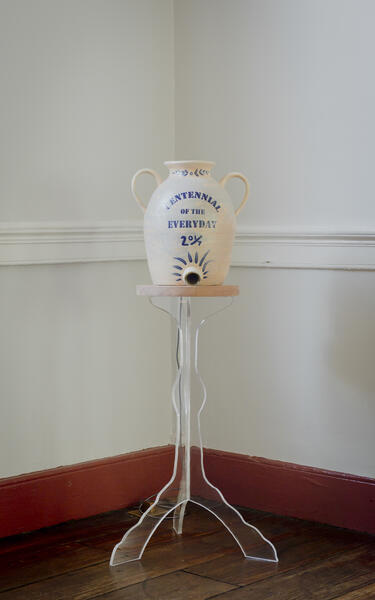 Vestige Vessels: Centennial of the EverydayVestige Vessels: Centennial of the Everyday and Peace, Plenty and Independence Soda fired stoneware, looping video, plexiglass, walnut Stoneware made in collaboration with Jani Hileman and Mat Karas at the Maryland Institute College of Art Ceramics Department, Baltimore Videos produced in collaboration with Jonathan Monaghan In the Centennial of the Everyday vessel, an 18th century coconut sherd from the Alexandria Archaeology collection is shown as a spinning animation. This sherd represents the wide variety of goods and people brought to Alexandria’s shores as an active port city. Project collaborators Char McCargo Bah and Stephen Hammond read 3 poems that they chose: “The Negro Speaks of Rivers” (by Langston Hughes), “That Man is a Success” (by Robert Louis Stevenson), and “Caged Bird” (by Maya Angelou). Centennial of the Everyday is a collaboration of Lauren Frances Adams and Stewart Watson images courtesy Vince Lupo
Vestige Vessels: Centennial of the EverydayVestige Vessels: Centennial of the Everyday and Peace, Plenty and Independence Soda fired stoneware, looping video, plexiglass, walnut Stoneware made in collaboration with Jani Hileman and Mat Karas at the Maryland Institute College of Art Ceramics Department, Baltimore Videos produced in collaboration with Jonathan Monaghan In the Centennial of the Everyday vessel, an 18th century coconut sherd from the Alexandria Archaeology collection is shown as a spinning animation. This sherd represents the wide variety of goods and people brought to Alexandria’s shores as an active port city. Project collaborators Char McCargo Bah and Stephen Hammond read 3 poems that they chose: “The Negro Speaks of Rivers” (by Langston Hughes), “That Man is a Success” (by Robert Louis Stevenson), and “Caged Bird” (by Maya Angelou). Centennial of the Everyday is a collaboration of Lauren Frances Adams and Stewart Watson images courtesy Vince Lupo -
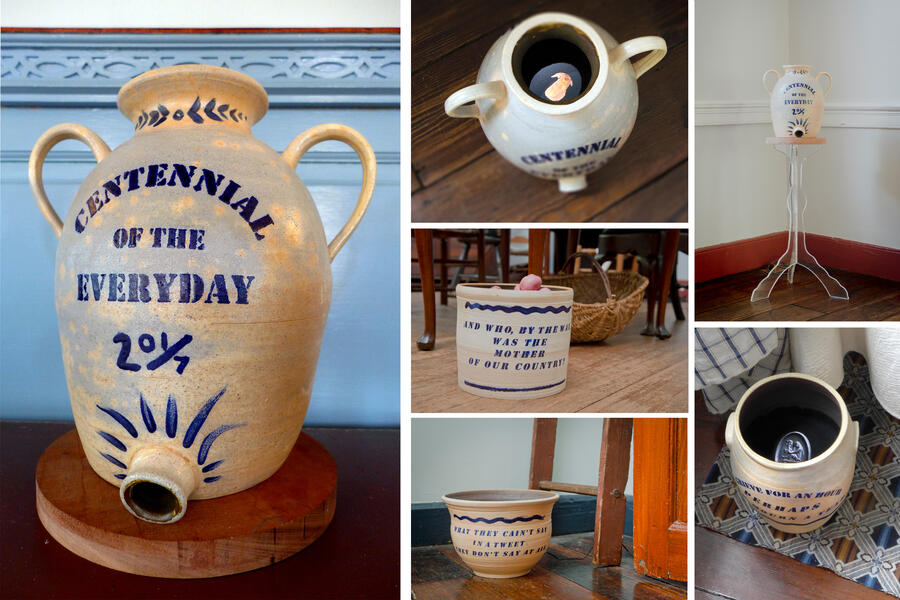 Vestige Vessels:Vestige Vessels: Centennial of the Everyday and Peace, Plenty and Independence Soda fired stoneware, looping video, plexiglass, walnut Stoneware made in collaboration with Jani Hileman and Mat Karas at the Maryland Institute College of Art Ceramics Department, Baltimore Videos produced in collaboration with Jonathan Monaghan In the Centennial of the Everyday vessel, an 18th century coconut sherd from the Alexandria Archaeology collection is shown as a spinning animation. This sherd represents the wide variety of goods and people brought to Alexandria’s shores as an active port city. Project collaborators Char McCargo Bah and Stephen Hammond read 3 poems that they chose: “The Negro Speaks of Rivers” (by Langston Hughes), “That Man is a Success” (by Robert Louis Stevenson), and “Caged Bird” (by Maya Angelou). In the Peace, Plenty and Independence vessel, a portrait miniature of Provey Norris (Gadsby’s 3rd wife, painted in 1829 by Anson Dickinson) is animated and paired with audio of Tracy Loughlin reading two recipes connected to Gadsby’s Tavern, one from the 19th century (egg nog from a Gadsby descendant’s recipe box) and one from the present (Sally Lunn bread from the Gadsby’s Tavern Restaurant). Grieve for an hour perhaps then mourn a year The vessels’ exterior text hints to what is revealed inside – the grief of an anonymous woman. The cobalt glazed text is a line from the Alexander Pope poem, “Elegy to the Memory of an Unfortunate Lady.” A portion of this poem is inscribed on the grave of the Female Stranger in St. Paul’s Episcopal Church Cemetery in Alexandria. Inside this vessel, a female figure found on the original iron coal grate in the ballroom is moved to tears. Vestige Vessels: What they cain’t say in a tweet they don’t say at all In this vessel you will see a slideshow that compiles photographs from the artists’ site visits and other finds during the process of researching and constructing the artworks on view throughout the museum. Centennial of the Everyday is a collaboration of Lauren Frances Adams and Stewart Watson images courtesy Vince Lupo
Vestige Vessels:Vestige Vessels: Centennial of the Everyday and Peace, Plenty and Independence Soda fired stoneware, looping video, plexiglass, walnut Stoneware made in collaboration with Jani Hileman and Mat Karas at the Maryland Institute College of Art Ceramics Department, Baltimore Videos produced in collaboration with Jonathan Monaghan In the Centennial of the Everyday vessel, an 18th century coconut sherd from the Alexandria Archaeology collection is shown as a spinning animation. This sherd represents the wide variety of goods and people brought to Alexandria’s shores as an active port city. Project collaborators Char McCargo Bah and Stephen Hammond read 3 poems that they chose: “The Negro Speaks of Rivers” (by Langston Hughes), “That Man is a Success” (by Robert Louis Stevenson), and “Caged Bird” (by Maya Angelou). In the Peace, Plenty and Independence vessel, a portrait miniature of Provey Norris (Gadsby’s 3rd wife, painted in 1829 by Anson Dickinson) is animated and paired with audio of Tracy Loughlin reading two recipes connected to Gadsby’s Tavern, one from the 19th century (egg nog from a Gadsby descendant’s recipe box) and one from the present (Sally Lunn bread from the Gadsby’s Tavern Restaurant). Grieve for an hour perhaps then mourn a year The vessels’ exterior text hints to what is revealed inside – the grief of an anonymous woman. The cobalt glazed text is a line from the Alexander Pope poem, “Elegy to the Memory of an Unfortunate Lady.” A portion of this poem is inscribed on the grave of the Female Stranger in St. Paul’s Episcopal Church Cemetery in Alexandria. Inside this vessel, a female figure found on the original iron coal grate in the ballroom is moved to tears. Vestige Vessels: What they cain’t say in a tweet they don’t say at all In this vessel you will see a slideshow that compiles photographs from the artists’ site visits and other finds during the process of researching and constructing the artworks on view throughout the museum. Centennial of the Everyday is a collaboration of Lauren Frances Adams and Stewart Watson images courtesy Vince Lupo -
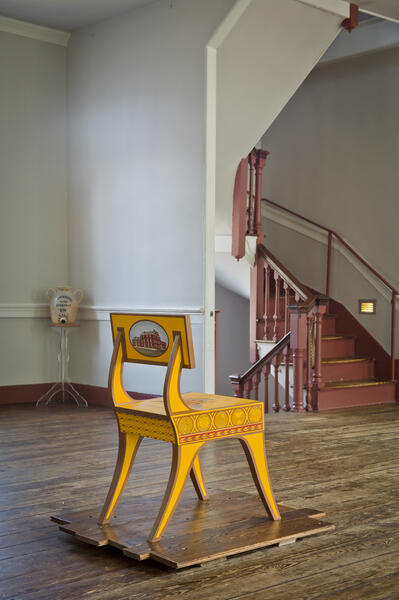 Big Data / Small FindsBig Data / Small Finds Custom designed CNC routed birch wood, painted in the Etruscan color range Made in collaboration with artists and fabricator Kevin Cook This chair is a reinterpretation of the American Empire style Klismos designed by Benjamin Henry Latrobe - for James & Dolley Madison’s White House (Latrobe also designed the city hall clock tower visible through the window). The surface designs reflect the historical research surrounding Centennial of the Everyday, from the borders that mimic the woodwork at Gadsby’s, to Martha Washington’s shell embroidery pattern. Other images include the DAR wheel, architectural schematics from Gadsby's, the Female Stranger's tomb, abolitionist and masonic historical imagery, and a Google Drive folder which held hundreds of documents shared collaboratively between the artists. Finally, the image on the seat is a mixture of early American eagle and shield crests. The eagle is clasping a two pronged fork, a spoon, and a pencil reflecting the tools of the historic tavern and the artists themselves. Centennial of the Everyday is a collaboration of Lauren Frances Adams and Stewart Watson images courtesy Vince Lupo
Big Data / Small FindsBig Data / Small Finds Custom designed CNC routed birch wood, painted in the Etruscan color range Made in collaboration with artists and fabricator Kevin Cook This chair is a reinterpretation of the American Empire style Klismos designed by Benjamin Henry Latrobe - for James & Dolley Madison’s White House (Latrobe also designed the city hall clock tower visible through the window). The surface designs reflect the historical research surrounding Centennial of the Everyday, from the borders that mimic the woodwork at Gadsby’s, to Martha Washington’s shell embroidery pattern. Other images include the DAR wheel, architectural schematics from Gadsby's, the Female Stranger's tomb, abolitionist and masonic historical imagery, and a Google Drive folder which held hundreds of documents shared collaboratively between the artists. Finally, the image on the seat is a mixture of early American eagle and shield crests. The eagle is clasping a two pronged fork, a spoon, and a pencil reflecting the tools of the historic tavern and the artists themselves. Centennial of the Everyday is a collaboration of Lauren Frances Adams and Stewart Watson images courtesy Vince Lupo -
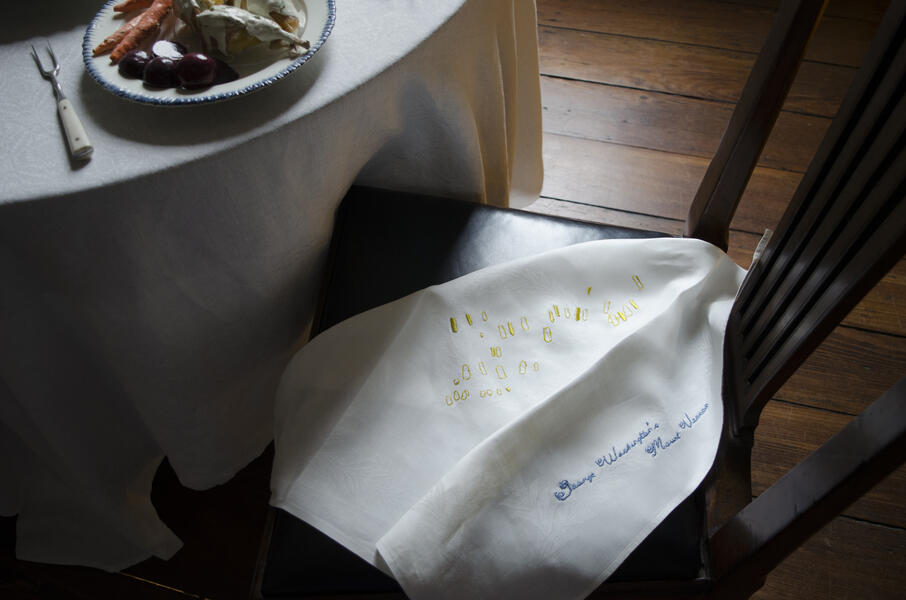 Labor to keep alive in your breast that little spark of celestial fire called conscienceAntique linen napkin with digital embroidery This napkin traces the recent archeological surveys of unmarked graves of the ‘negro burying ground’ at George Washington’s Mount Vernon. The artists visited the site and consulted with the Archeology Lab at Mount Vernon, learning about the burial practices of the peoples who were enslaved at Mount Vernon in the 18th and 19th centuries, as well as the layered histories of the site, from pre-historic Native American hunting ground to sacred 21st century meaning. The title is a reference to the 110th rule in a 110 Rules of Civility & Decent Behavior in Company and Conversation, which George Washington copied out by hand at age 16. Centennial of the Everyday is a collaboration of Lauren Frances Adams and Stewart Watson images courtesy Vince Lupo
Labor to keep alive in your breast that little spark of celestial fire called conscienceAntique linen napkin with digital embroidery This napkin traces the recent archeological surveys of unmarked graves of the ‘negro burying ground’ at George Washington’s Mount Vernon. The artists visited the site and consulted with the Archeology Lab at Mount Vernon, learning about the burial practices of the peoples who were enslaved at Mount Vernon in the 18th and 19th centuries, as well as the layered histories of the site, from pre-historic Native American hunting ground to sacred 21st century meaning. The title is a reference to the 110th rule in a 110 Rules of Civility & Decent Behavior in Company and Conversation, which George Washington copied out by hand at age 16. Centennial of the Everyday is a collaboration of Lauren Frances Adams and Stewart Watson images courtesy Vince Lupo -
 Obtained without VandalismObtained without Vandalism Custom designed cotton fabric upholstered onto Queen Anne reproduction chairs belonging to Gadsby Tavern Museum This trompe l'oeil pattern features historic clippings intermingled together from 19th and 20th century newspapers. These all share a connection to John Gadsby and the Alexandria region. Centennial of the Everyday is a collaboration of Lauren Frances Adams and Stewart Watson images courtesy Vince Lupo
Obtained without VandalismObtained without Vandalism Custom designed cotton fabric upholstered onto Queen Anne reproduction chairs belonging to Gadsby Tavern Museum This trompe l'oeil pattern features historic clippings intermingled together from 19th and 20th century newspapers. These all share a connection to John Gadsby and the Alexandria region. Centennial of the Everyday is a collaboration of Lauren Frances Adams and Stewart Watson images courtesy Vince Lupo
Reading is Comfort
"3Story Stories" and "GoodNight MoonLight NightLight" are two projects that have been part of my ongoing commitment to literacy and the citizens of Baltimore City.
3Story Stories resides on The Wonderground, a series of 8 vacant lots I adopted through the Adopt-A-Lot program for our community several years ago. The installation is a set of three padded, seats created to look like oversized marble steps, and a rotating library created as three row houses each has books for a certain group, children, young adult and adults, and are curated to be a diverse selection of readings representative of our neighborhood and encouraging intergenerational reading.
To date, through 3 Story Stories, we have been able to encourage multiple community readings, dozens of impromptu readings and I have been able to distribute over 1300 meaningful books thus far into our community. This project is made possible by Lots Alive, a grant program of the Baltimore Office of Promotion & The Arts and the Baltimore Office of Sustainability .
Goodnight MoonLight NightLight was created for a weekend installation in Baltimore's inner harbor during the Baltimore Book Festival. The tent was called the Story Share and was a project of the Baltimore Office of Promotion and the Arts. It featured a giant moon night light whose LED lights would morph and change and peaceful reading space created with dozens of stripes of fabric meant to evoke spines of a book. There were beanbags and pillows and poufs and rugs, all in an otherwise ordinary tent. Books were donated, shared and swapped as well as several scheduled readings were organized throughout the weekend. this will be an annual project.
2016-current
-
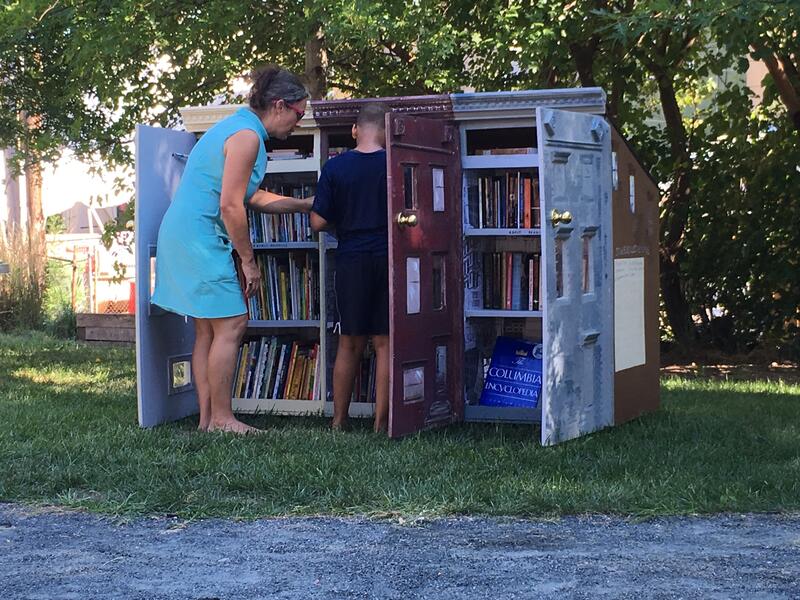 3 Story Stories3 Story Stories a curated collection of age appropriate books given freely and open all the time in our community for children, youth and adults To date over 2500 diverse and thoughtful books have been circulated for the library to encourage literacy and intergenerational connectivity in our neighborhood. 2016- current
3 Story Stories3 Story Stories a curated collection of age appropriate books given freely and open all the time in our community for children, youth and adults To date over 2500 diverse and thoughtful books have been circulated for the library to encourage literacy and intergenerational connectivity in our neighborhood. 2016- current -
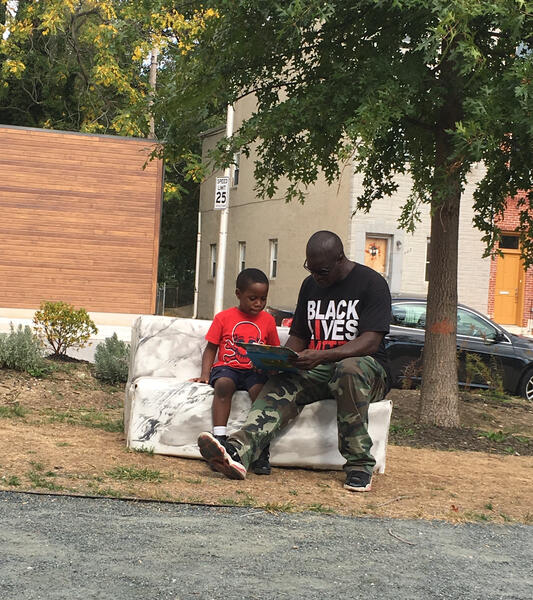 3 Story Storiescommunity reading time on the soft stoops
3 Story Storiescommunity reading time on the soft stoops -
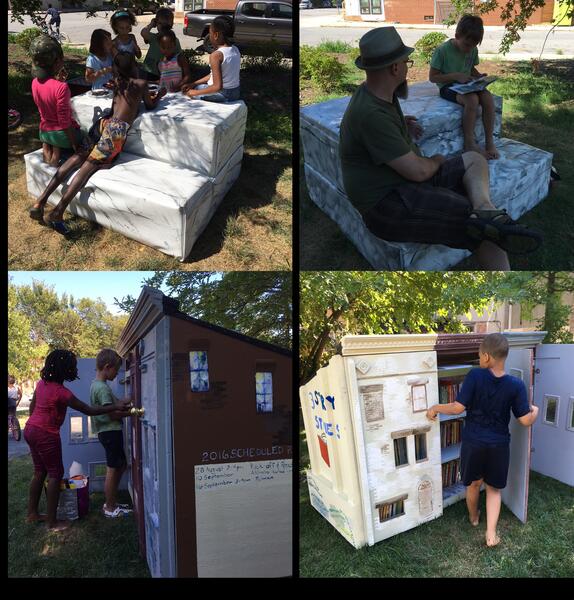 3 Story Stories3 Story Stories the library and the oversized soft marble stoops for sitting to encourage reading 2016-ongoing in Greenmount West on the Wonderground a literacy and intergenerational community project
3 Story Stories3 Story Stories the library and the oversized soft marble stoops for sitting to encourage reading 2016-ongoing in Greenmount West on the Wonderground a literacy and intergenerational community project -
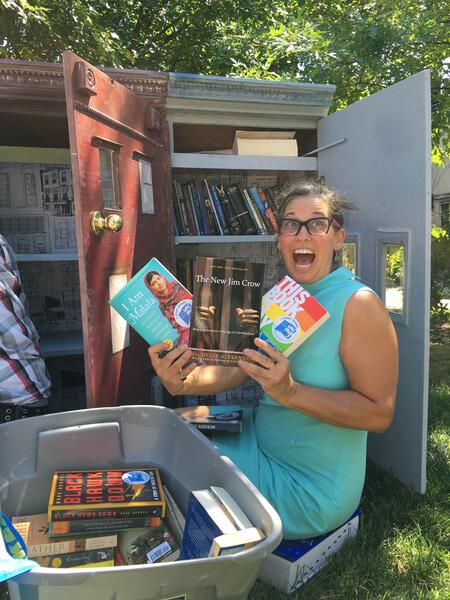 3 Story StoriesEvery book has a sticker on it 3Story Stories describing the project and denoting that it is a Free Book and THIS BOOK BELONGS TO EVERYONE! over 2500 books and counting! Malala, books on gender, African American history and authors, LGBTQ, Native American authors, Women Authors - I loved curating this collection! and receiving books to share!
3 Story StoriesEvery book has a sticker on it 3Story Stories describing the project and denoting that it is a Free Book and THIS BOOK BELONGS TO EVERYONE! over 2500 books and counting! Malala, books on gender, African American history and authors, LGBTQ, Native American authors, Women Authors - I loved curating this collection! and receiving books to share! -
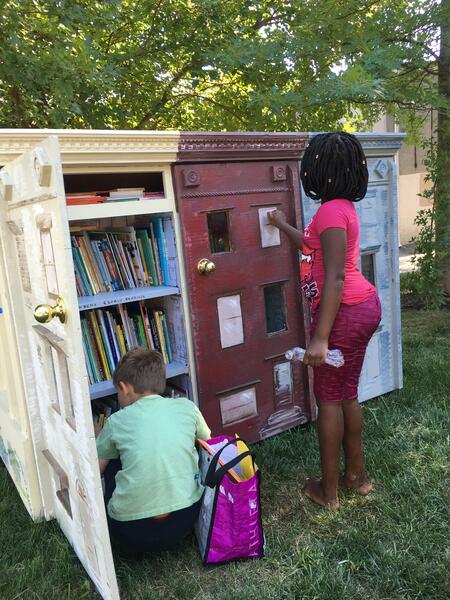 3 Storie StoriesChildren choosing books!
3 Storie StoriesChildren choosing books! -
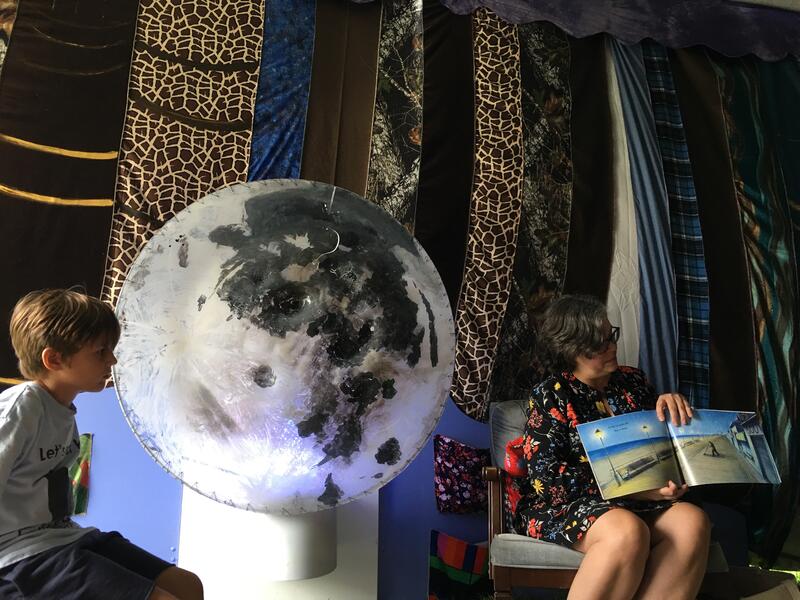 GoodNight MoonLight NightLight"Goodnight MoonLight NightLight" was created for a weekend installation in Baltimore's inner harbor during the Baltimore Book Festival. The tent was called the Story Share. It featured an oversized moon nightlight and peaceful reading space I created in an otherwise ordinary tent. Books were donated, shared and swapped as well as several scheduled readings were organized throughout the weekend. this will be an annual project 2016, ongoing.
GoodNight MoonLight NightLight"Goodnight MoonLight NightLight" was created for a weekend installation in Baltimore's inner harbor during the Baltimore Book Festival. The tent was called the Story Share. It featured an oversized moon nightlight and peaceful reading space I created in an otherwise ordinary tent. Books were donated, shared and swapped as well as several scheduled readings were organized throughout the weekend. this will be an annual project 2016, ongoing. -
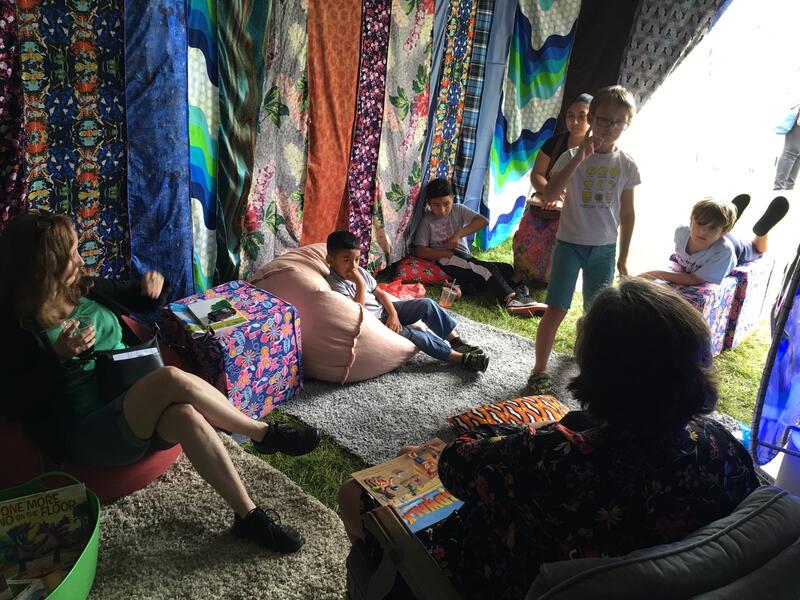 GoodNight MoonLight NightLight"Goodnight MoonLight NightLight" was created for a weekend installation in Baltimore's inner harbor during the Baltimore Book Festival. The tent was called the Story Share and was a project of the Baltimore Office of Promotion and the Arts. It featured a giant moon night light whose LED lights would morph and change and peaceful reading space created with dozens of stripes of fabric meant to evoke spines of a book. There were beanbags and pillows and poufs and rugs, all in an otherwise ordinary tent. Books were donated, shared and swapped as well as several scheduled readings were organized throughout the weekend. this will be an annual project. 2016, ongoing. Fabric, Acrylic, color changing LEDs, wood, foam, poufs, books, readings
GoodNight MoonLight NightLight"Goodnight MoonLight NightLight" was created for a weekend installation in Baltimore's inner harbor during the Baltimore Book Festival. The tent was called the Story Share and was a project of the Baltimore Office of Promotion and the Arts. It featured a giant moon night light whose LED lights would morph and change and peaceful reading space created with dozens of stripes of fabric meant to evoke spines of a book. There were beanbags and pillows and poufs and rugs, all in an otherwise ordinary tent. Books were donated, shared and swapped as well as several scheduled readings were organized throughout the weekend. this will be an annual project. 2016, ongoing. Fabric, Acrylic, color changing LEDs, wood, foam, poufs, books, readings -
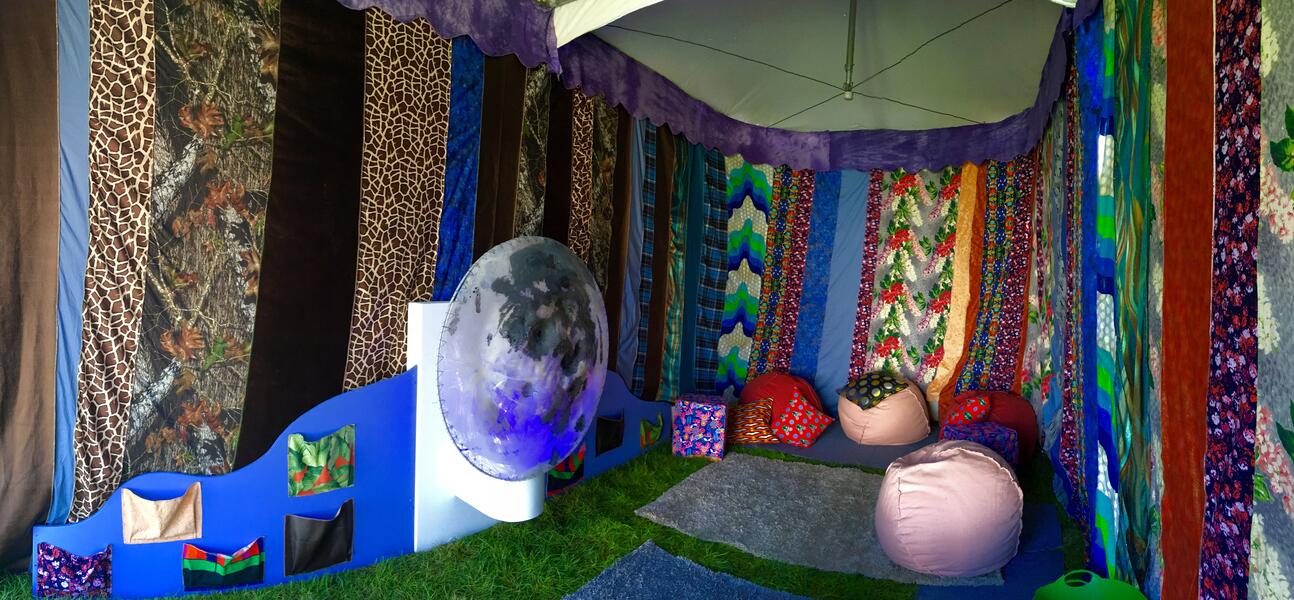 GoodNight MoonLight NightLight"Goodnight MoonLight NightLight" was created for a weekend installation in Baltimore's inner harbor during the Baltimore Book Festival. The tent was called the Story Share and was a project of the Baltimore Office of Promotion and the Arts. It featured a giant moon night light whose LED lights would morph and change and peaceful reading space created with dozens of stripes of fabric meant to evoke spines of a book. There were beanbags and pillows and poufs and rugs, all in an otherwise ordinary tent. Books were donated, shared and swapped as well as several scheduled readings were organized throughout the weekend. this will be an annual project. 2016, ongoing. Fabric, Acrylic, color changing LEDs, wood, foam, poufs, books, readings
GoodNight MoonLight NightLight"Goodnight MoonLight NightLight" was created for a weekend installation in Baltimore's inner harbor during the Baltimore Book Festival. The tent was called the Story Share and was a project of the Baltimore Office of Promotion and the Arts. It featured a giant moon night light whose LED lights would morph and change and peaceful reading space created with dozens of stripes of fabric meant to evoke spines of a book. There were beanbags and pillows and poufs and rugs, all in an otherwise ordinary tent. Books were donated, shared and swapped as well as several scheduled readings were organized throughout the weekend. this will be an annual project. 2016, ongoing. Fabric, Acrylic, color changing LEDs, wood, foam, poufs, books, readings -
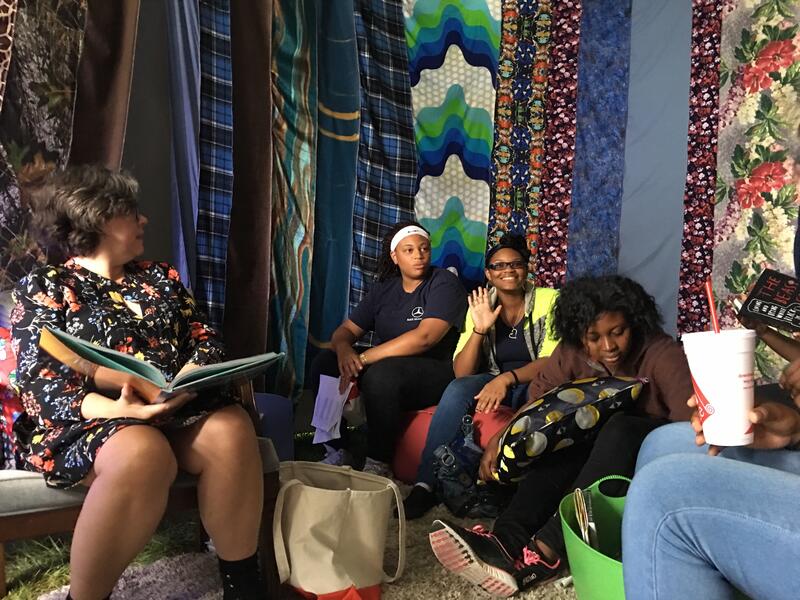 GoodNight MoonLight NightLight"Goodnight MoonLight NightLight" was created for a weekend installation in Baltimore's inner harbor during the Baltimore Book Festival. The tent was called the Story Share and was a project of the Baltimore Office of Promotion and the Arts. It featured a giant moon night light whose LED lights would morph and change and peaceful reading space created with dozens of stripes of fabric meant to evoke spines of a book. There were beanbags and pillows and poufs and rugs, all in an otherwise ordinary tent. Books were donated, shared and swapped as well as several scheduled readings were organized throughout the weekend. this will be an annual project. 2016, ongoing. Reading by Kelly Ramsdell Fabric, Acrylic, color changing LEDs, wood, foam, poufs, books, readings
GoodNight MoonLight NightLight"Goodnight MoonLight NightLight" was created for a weekend installation in Baltimore's inner harbor during the Baltimore Book Festival. The tent was called the Story Share and was a project of the Baltimore Office of Promotion and the Arts. It featured a giant moon night light whose LED lights would morph and change and peaceful reading space created with dozens of stripes of fabric meant to evoke spines of a book. There were beanbags and pillows and poufs and rugs, all in an otherwise ordinary tent. Books were donated, shared and swapped as well as several scheduled readings were organized throughout the weekend. this will be an annual project. 2016, ongoing. Reading by Kelly Ramsdell Fabric, Acrylic, color changing LEDs, wood, foam, poufs, books, readings -
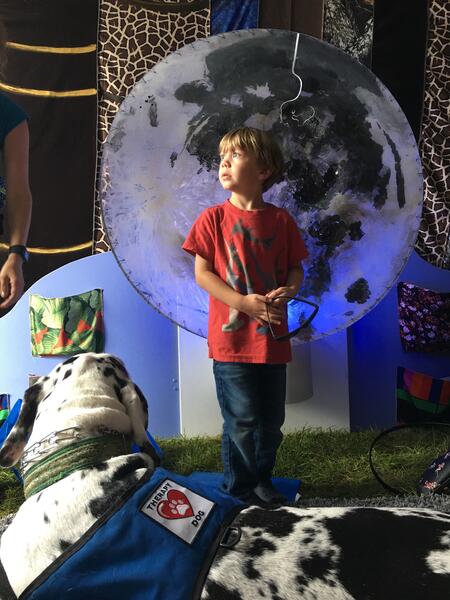 GoodNight MoonLight NightLight"Goodnight MoonLight NightLight" was created for a weekend installation in Baltimore's inner harbor during the Baltimore Book Festival. The tent was called the Story Share and was a project of the Baltimore Office of Promotion and the Arts. It featured a giant moon night light whose LED lights would morph and change and peaceful reading space created with dozens of stripes of fabric meant to evoke spines of a book. There were beanbags and pillows and poufs and rugs, all in an otherwise ordinary tent. Books were donated, shared and swapped as well as several scheduled readings were organized throughout the weekend. this will be an annual project. 2016, ongoing. Fabric, Acrylic, color changing LEDs, wood, foam, poufs, books, readings
GoodNight MoonLight NightLight"Goodnight MoonLight NightLight" was created for a weekend installation in Baltimore's inner harbor during the Baltimore Book Festival. The tent was called the Story Share and was a project of the Baltimore Office of Promotion and the Arts. It featured a giant moon night light whose LED lights would morph and change and peaceful reading space created with dozens of stripes of fabric meant to evoke spines of a book. There were beanbags and pillows and poufs and rugs, all in an otherwise ordinary tent. Books were donated, shared and swapped as well as several scheduled readings were organized throughout the weekend. this will be an annual project. 2016, ongoing. Fabric, Acrylic, color changing LEDs, wood, foam, poufs, books, readings
follmers fourth defluxion
The title of each of the works in "follmers fourth defluxion" is derived from passages in books that have been entrusted to me, each having been written in by its owners, my ancestors.
Arthur's New Juvenile Library, Maggy's Baby, 1852, first belonged to Alfred
The Golden Gift , A Wreath of Gems, 1849 first belonged to Mary
Who is My Neighbor, or The Wilson Family, 1852 first belonged to Alfred
Pictures for Our Darlings, 1876, first belonged to Willie
Philadelphia Cookbook, A Manual of Home Economies 1886, first belonged to Mary
The Poetical Works of Robert Burns, 1883, first belonged to Aunt Edith
The School Dictionary; or Expositor of the English Language, 1812 first belonged to Elizabeth
Truth is subjective and I have uncovered a future tale of what this stuff can mean. I hope as I continue to understand how to make room for history and my own genetic predisposition to possession while I make work that consumes the underwhelming historical artifacts my family painstakingly preserved to keep itself remembered I am honoring it.
Investigating the ordinary, or an indefatigable search for comfort.
follmers fourth defluxion is a story, an installation, my collective unconscious past and an opportunity to delve into the way I investigate before and find room for it in my next.
title:“You see before you.” said the old man to him, “ the Way of Life and the Road to Destruction. Choose, now, which you will walk in.”
media:
5 knives steel & bone,
great grandfather William N Watson's chicken cup,
Portrait of Curtis Bruce Watson, my great great grandfather, (b 1839 d 1872),
Portrait of Mary Nagle Watson, my great great grandmother, (b 1842 d 1929),
silver plated fork 1866- a wedding gift MEW, that was rather chewed ( the other 5 are currently in use at the Watson/Vose household, 4 steel & bone forks, the copy of the list 1862,
great great grandmother Watson's 11 linen luncheon napkins 1866 given for her wedding - used by me often - 1 ruined by HE washing machine 2013.
spiny lacy antimacassar handmade,
The Feather Stitched “W” (red),
great great grandparents ledgers 1860-1880 don't you wish you could read them?,
great grandfather's winning pullet cup 1912,
great grandmother Mary Louise Bastress's napkin ring ( b 1867 d 1947),
Wilhelm Friedrich Nagle's chair 1820,
My great great great great grandfather's mother of pearl cane topper circa 1820, tassel,
receipts for moving c 1860,
fabric, polyfill, thread, steel, vinyl, gimp, magic, jute strapping, staples, glue, hardware
size of the wall construction : 120” x 245”x 70” variable
title: The Pudding of Long Ago
media:
great great grandfather Bastress' (b 1838 d 1915) trunk, BBW's Army Uniforms wool 1919, silk day dress worn by great great grandmother Watson 1866, great great grandfather's velvet wedding vests 1866,
3 of my grandfather's cotton shirts 1948, 5 of my father's Korean War era US Lieutenant uniforms, my high school graduation dress 1986, CB's gold & enamel cuff links, various bonnets, silks, gloves, lace, bloomers, and other random stuff circa 1870, vinyl, leather, thread, tassels, casters
size 30" x 30" x 50"
title: “Set a chair, Jenny, for the gentlemen” said she to the child.
the valuable walnut chair from Milton that my grandmother( b 1892, d 1991) gave to me six times between 1982 and 1985,
ratcheting straps, steel, fabric, polyfill, vinyl, gimp, bedazzlings, tacks
15 feet 11 feet 11 feet approximately
title: Has your gran-ma's pock-et Bunch o' keys and mo-ney? Spool o' thread and thim-ble? Can-dy made o' ho-ney?
media:
EZ teether rubber 1931, vinyl, tassel, thread
Willie's toddler glass 1868
Watson family chair parts circa 1880
horn mustache comb circa 1850
an important shooter 1895, glass
eyebrow comb circa 1880
civil war hymn book book that weathered the 1889 flood
Altered photographs of my great grandparents, great uncle, and great great uncle, great great grandparents, 23karat gold leaf
book given to Mary E Nagle in 1852, then annotated for young ladies 1922 by her before she died
dirt from 1300 20th Ave, gathered, 1986, 23 karat gold
casters from family furniture that I might still own
Photographs of the family furniture I have deconstructed and some that were saved from the axe
oh and my great grandfather's saw i used to cut up the chairs
and a few other things I've not yet described here but you may just want to look for
144" x 252" x 160" variable
title: SIR, oe'r a gill I gat your card
media:
parts of the Nagle leather trunk from 1876 I cherished, correspondence between family members 1862-1978, random legal documents that I am keeping safe for something, for now, vinyl, gimp, polyfil, glue, thread
24" x 22" x 22"
title: Turn it over, and see how comical it looks; everything appears to have lost its gravity.
media:
My great, great, great, grandfather's chair with writing on the bottom "Nagle 184-",
paint made from burning one of my great, great grandfather's chairs along with ancestral letters, receipts & documents
acrylic matte medium, steel, felt, hardware
wall painted with paint made from burned chair and letters is 144" x 112", wooden chair is about the size of an upside down chair at a jaunty angle
title: The little knot of which he was the head and front, wherein he was supreme
media:
My great great grandfather's bow-tie 1871,
my great great great grandmother's mirror 1852,
fabric from the wedding dresses of grandmother 1926, my great, great, grandmother 1866, Me 1999,
steel, poly-fil, thread, vinyl, tassels, hardware
33" x 5" x 65"
you can see the bowtie on your neck in the hand mirror, but you cannot see your face.
As to the addition of mirror, I felt this was a way to place yourself within the timeline of the work. Either you look in the mirror as just a mirror, check your teeth and miss the point, or you find the object that relates to the time and you connect with that, and then you no longer can see yourself in the mirror and only see the object "worn" on you.
my bio if you wish to read it...
Stewart Watson was born in Pennsylvania in 1968. She received her BFA in sculpture from the Pennsylvania State University in 1991. For the two years after graduation, she worked and traveled in Greece, Egypt, Kenya, and throughout East and Southeast Asia, returning to the United States, choosing Baltimore as her home. She returned to school in 2007 to The University of Maryland where she became a first time parent, was an Anne Truitt Scholar, Daniel Nicholson Olkhe Award winner, a teacher, and received her MFA in 2010.
She has received individual artist grants from the Maryland State Arts Council in 2011, 2007, and 2001, two 2016 individual artist grants from the Baltimore Office of Promotion and the Arts, a 2016-2017 grant from Alexandria Office of Arts, Alexandria, VA, and is the winner of the 2010 Sadat Art for Peace Prize. Recent exhibitions include the 2014 Janet & Walter Sondheim Prize Finalists at The Walters Art Museum, Marian Boesky Gallery, (New York, NY), UNCP A.D. Gallery, (Pembroke, NC), and solo exhibitions at The Contemporary, (Baltimore, MD) and McDaniel College, (Westminster, MD), artist panels at the Kreeger Museum and The Baltimore Museum of Art and a residency at the Digital Fabrication Residency (Easton, MD). She teaches at The Maryland Institute College of Art.
Her work has been featured in publications including the inaugural print magazine BmoreArt a Journal of Art + Ideas (2015), Baltimore Magazine ( October 2016), OutPost Journal (2012), Citypaper, The Washington Post, The Baltimore Sun, and blogs ArtFCity, BmoreArt and HaHa Magazine.
Watson is an artist, a parent, a partner, a curator, an educator, a volunteer, and community advocate, serving on several regional boards and organizations. She is the Executive Director and curator of AREA 405, a 7000 square foot exhibition and event space she co-founded in 2003. She is co-owner, founder, and president of Oliver Street Studios, established in 2002, a 66,000 square foot warehouse in the heart of Baltimore City. Oliver Street Studios has grown from a vacant building into an artistic and community anchor for the Station North Arts & Entertainment District. It now serves as studios for 45 artists, a gallery, a tool library, and home to Watson, her artist husband, their dogs, cat, and son.
The degeneration of Watson's spine has lead to years of surgeries, procedures, metal rods, chronic pain and a perpetual longing for relief. This genetic quirk or hereditary flaw could be a repercussion of family possessions and the weight of obsession leading to the need to balance, lift, prop, strap, truss, buffer, embellish, stuff, cushion and pad objects and spaces - ever searching for that perfect place to settle.
Through luxurious fabrics, chosen to evoke the perception of a well-appointed living rooms and the memories rarely enjoyed, Watson manifests the uncomfortable perfection of the nineteenth century lifestyle through remnants of her kin's obsession with the past. Drawn into anonymous portraiture and reliquaries that immortalize and elevate the relationships she has with deceased members of her family, elevated to levels of tumultuous reverence. With over two centuries of objects that have been kept in boxes and passed down without regard for usefulness or beauty yet marked with names and dates and data only for posterity’s sake, the value has been affixed and the value has been bestowed from the family connection rather than practicality, market worth, or even demand from existing family members as there are few left to fight over the mountainous remains.
Her family furnishings and preserved relics have been kept as vital artifacts that inform her as she researches the generations of genealogical data and grapples with ancestral acquaintances and the contemporary conundrum of acquisition through each new work she makes. Now, nostalgia, humor and this delicate interdependence are critical aspects of what she makes and through which, she consumes her own history.
-
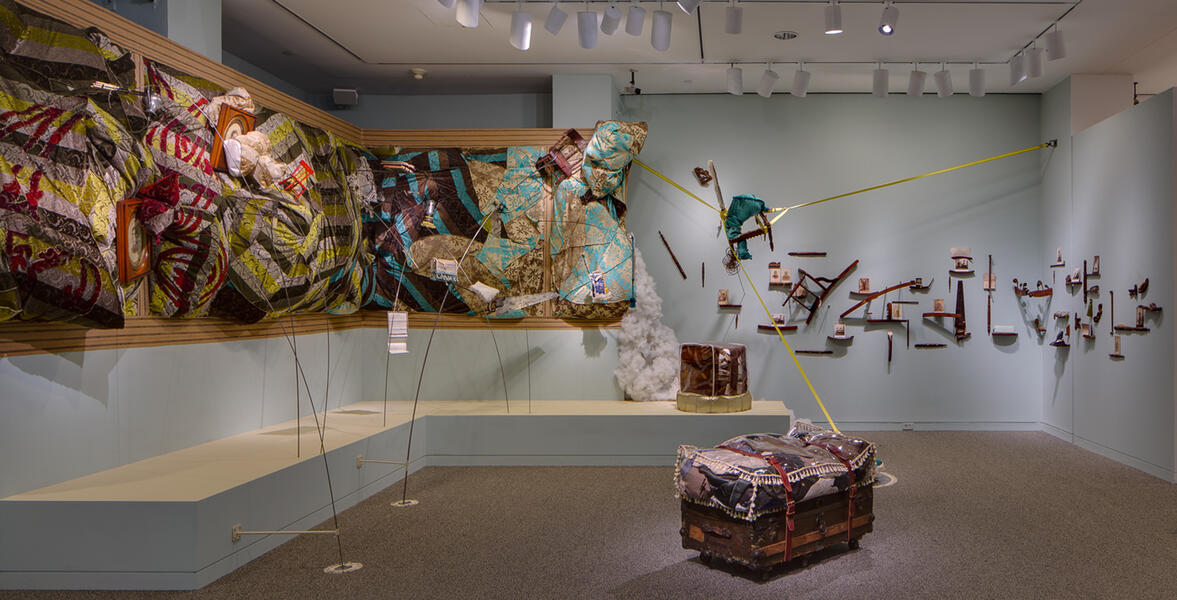 follmers fourth defluxion200 years of Watson family furnishings, clothing, objects, photographs, drawings, linens, furniture, utensils, ephemera ratcheting straps, letters, documents, fabric, , polyfill, thread, steel, vinyl, gimp, magic, jute strapping, staples, glue, hardware 120” x 378”x 450” (variable room dimensions) DESCRIPTION: follmers fourth defluxion was a site-specific installation made for an exhibition at The Walters Art Museum in Baltimore, MD. It was new work made during six weeks and part of a continuing series of works derived from my family's artifacts, furnishings and remnants accumulated and subsequently left in my care from the past 200 years. Honoring my family as I continue to understand how to make room for history and my own genetic predisposition to possession while I make work that consumes the overwhelming number of seemingly underwhelming historical artifacts my family painstakingly preserved to keep itself remembered full room installation at The Walters Art Museum, 2014
follmers fourth defluxion200 years of Watson family furnishings, clothing, objects, photographs, drawings, linens, furniture, utensils, ephemera ratcheting straps, letters, documents, fabric, , polyfill, thread, steel, vinyl, gimp, magic, jute strapping, staples, glue, hardware 120” x 378”x 450” (variable room dimensions) DESCRIPTION: follmers fourth defluxion was a site-specific installation made for an exhibition at The Walters Art Museum in Baltimore, MD. It was new work made during six weeks and part of a continuing series of works derived from my family's artifacts, furnishings and remnants accumulated and subsequently left in my care from the past 200 years. Honoring my family as I continue to understand how to make room for history and my own genetic predisposition to possession while I make work that consumes the overwhelming number of seemingly underwhelming historical artifacts my family painstakingly preserved to keep itself remembered full room installation at The Walters Art Museum, 2014 -
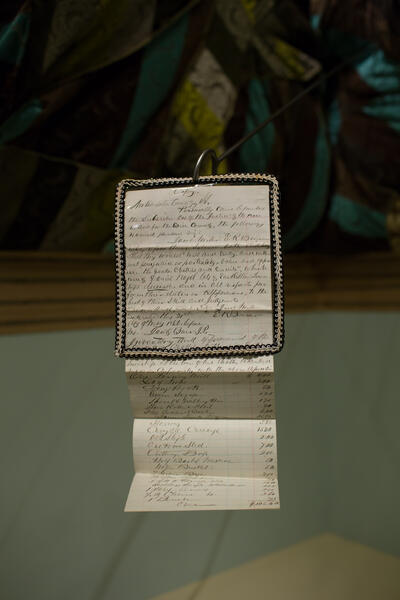 “You see before you.” said the old man to him, “ the Way of Life and the Road to Destruction. Choose, now, which you will walk in.” (detail)the copy of the list 1862, vinyl, gimp, steel Things that were kept, a list of things to be kept and sold, that we kept... and some things on the list that were kept that I have, still.
“You see before you.” said the old man to him, “ the Way of Life and the Road to Destruction. Choose, now, which you will walk in.” (detail)the copy of the list 1862, vinyl, gimp, steel Things that were kept, a list of things to be kept and sold, that we kept... and some things on the list that were kept that I have, still. -
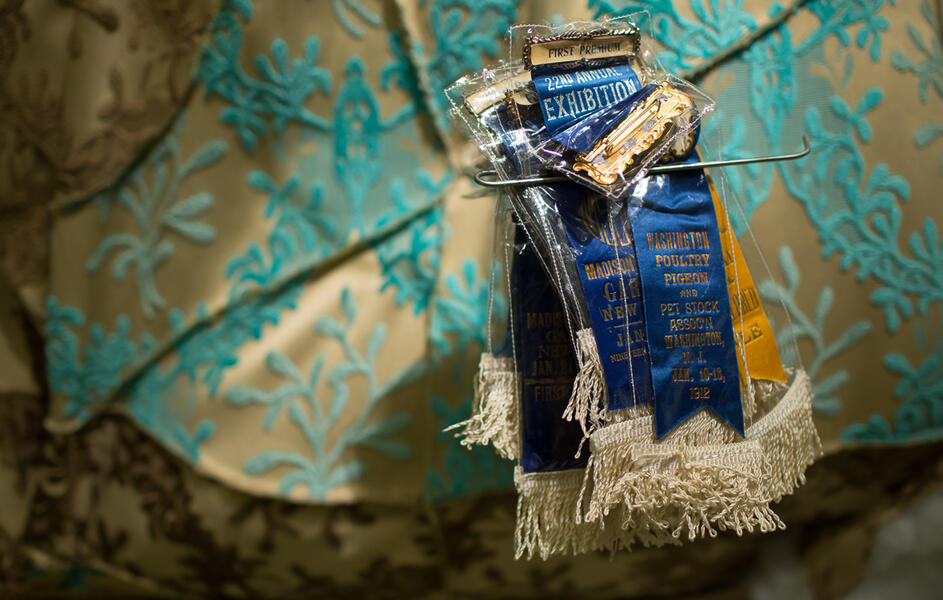 “You see before you.” said the old man to him, “ the Way of Life and the Road to Destruction. Choose, now, which you will walk in.” (detail)My great grandfather's 1910-1932 Pullet ribbons encased in vinyl and tassels for posterity, fabric, steel, polyfil, thread, etc
“You see before you.” said the old man to him, “ the Way of Life and the Road to Destruction. Choose, now, which you will walk in.” (detail)My great grandfather's 1910-1932 Pullet ribbons encased in vinyl and tassels for posterity, fabric, steel, polyfil, thread, etc -
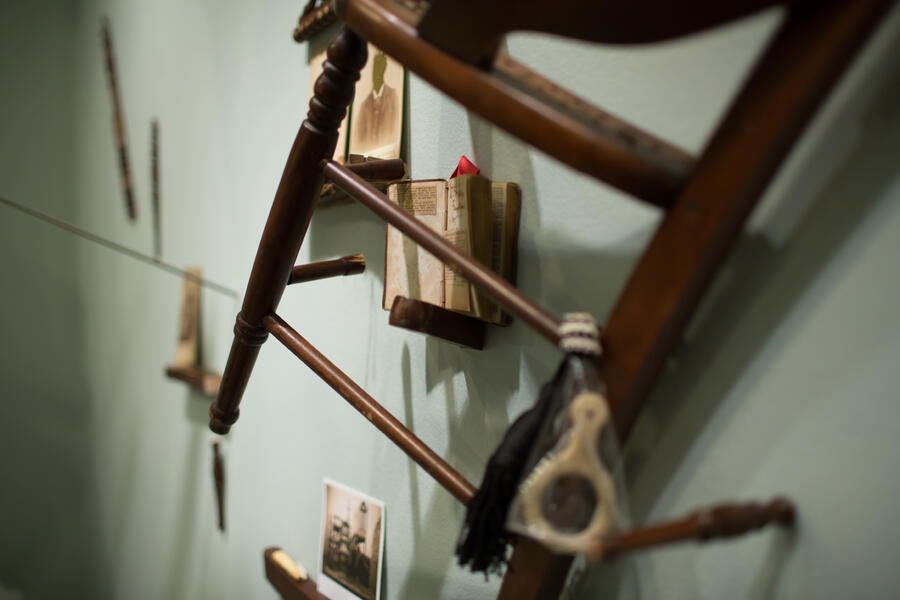 Has your gran-ma's pock-et Bunch o' keys and mo-ney? Spool o' thread and thim-ble? Can-dy made o' ho-ney? (detail)EZ teether rubber 1931, vinyl, tassel, thread Willie's toddler glass 1868 Watson family chair parts and the saw that cut them, both circa 1880 horn mustache comb circa 1850 an important shooter 1895, glass eyebrow comb circa 1880 civil war hymn book book that weathered the 1889 flood Altered photographs of my great grandparents, great uncle, and great great uncle, great great grandparents, 23karat gold leaf book given to Mary E Nagle in 1852, then annotated for young ladies 1922 by her before she died dirt from 1300 20th Ave, gathered, 1986, 23 karat gold casters from family furniture that I might still own Photographs of the family furniture I have deconstructed and some that were saved from the axe and a few other things I've not yet described here but you may just want to look for 120” x 252” x 8” DESCRIPTION: This piece builds on my genealogical tree. Each "shelf" and riser is built from apiece of one of the chair parts that were owned by my family. The photographs are my ancestors, faces forever protected, and preserved with 23 karat gold because the memory of them became more powerful than the knowledge of who they really were. Each item on the shelves is also from the family hoard and represents a particular family members, all leading to one object, the important shooter.
Has your gran-ma's pock-et Bunch o' keys and mo-ney? Spool o' thread and thim-ble? Can-dy made o' ho-ney? (detail)EZ teether rubber 1931, vinyl, tassel, thread Willie's toddler glass 1868 Watson family chair parts and the saw that cut them, both circa 1880 horn mustache comb circa 1850 an important shooter 1895, glass eyebrow comb circa 1880 civil war hymn book book that weathered the 1889 flood Altered photographs of my great grandparents, great uncle, and great great uncle, great great grandparents, 23karat gold leaf book given to Mary E Nagle in 1852, then annotated for young ladies 1922 by her before she died dirt from 1300 20th Ave, gathered, 1986, 23 karat gold casters from family furniture that I might still own Photographs of the family furniture I have deconstructed and some that were saved from the axe and a few other things I've not yet described here but you may just want to look for 120” x 252” x 8” DESCRIPTION: This piece builds on my genealogical tree. Each "shelf" and riser is built from apiece of one of the chair parts that were owned by my family. The photographs are my ancestors, faces forever protected, and preserved with 23 karat gold because the memory of them became more powerful than the knowledge of who they really were. Each item on the shelves is also from the family hoard and represents a particular family members, all leading to one object, the important shooter. -
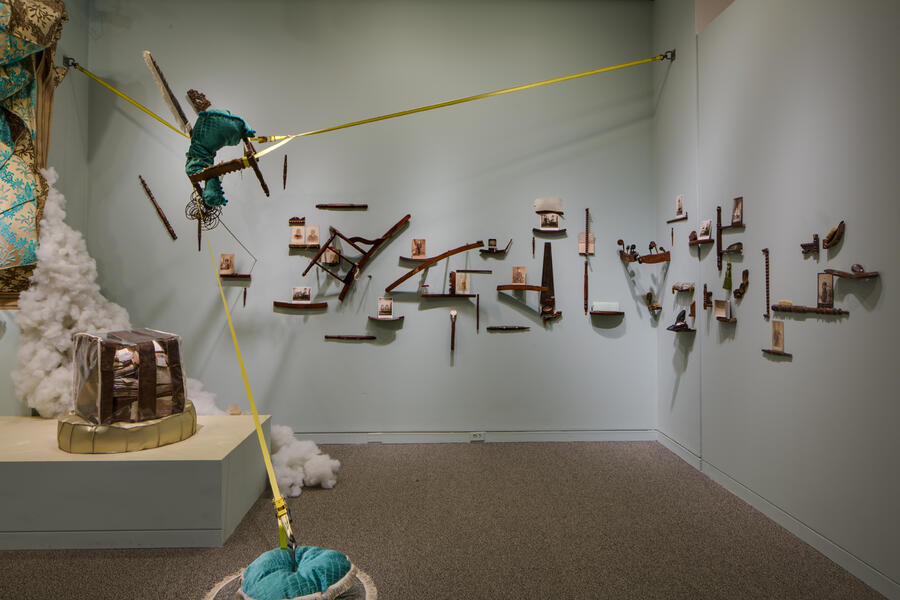 Has your gran-ma's pock-et Bunch o' keys and mo-ney? Spool o' thread and thim-ble? Can-dy made o' ho-ney? (detail)DESCRIPTION: This piece builds on my genealogical tree. Each "shelf" and riser is built from apiece of one of the chair parts that were owned by my family. The photographs are my ancestors, faces forever protected, and preserved with 23 karat gold because the memory of them became more powerful than the knowledge of who they really were. Each item on the shelves is also from the family hoard and represents a particular family members, all leading to one object, the important shooter.
Has your gran-ma's pock-et Bunch o' keys and mo-ney? Spool o' thread and thim-ble? Can-dy made o' ho-ney? (detail)DESCRIPTION: This piece builds on my genealogical tree. Each "shelf" and riser is built from apiece of one of the chair parts that were owned by my family. The photographs are my ancestors, faces forever protected, and preserved with 23 karat gold because the memory of them became more powerful than the knowledge of who they really were. Each item on the shelves is also from the family hoard and represents a particular family members, all leading to one object, the important shooter. -
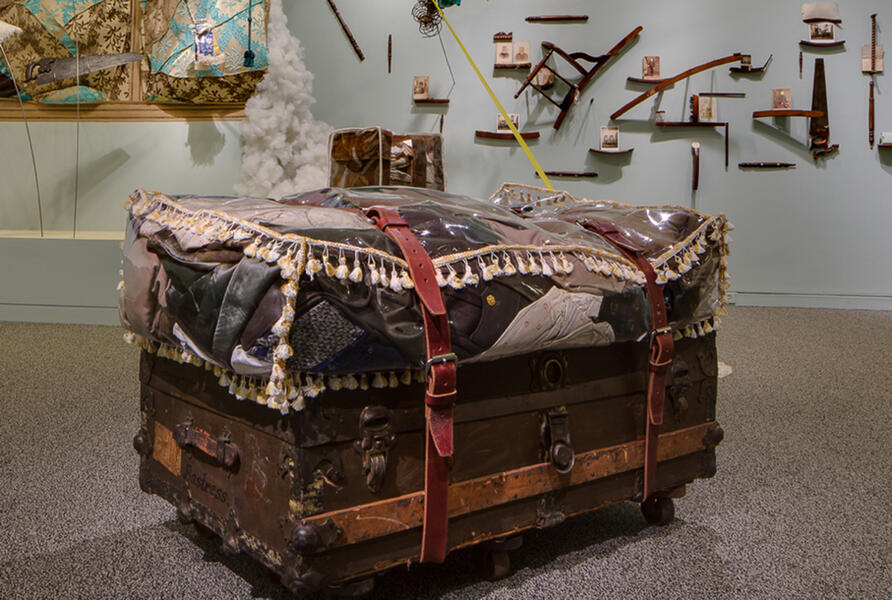 The Pudding of Long Agogreat great grandfather Bastress' (b 1838 d 1915) trunk, BBW's Army Uniforms wool 1919, silk day dress worn by great great grandmother Watson 1866, great great grandfather's velvet wedding vests 1866, 3 of my grandfather's cotton shirts 1948, 5 of my father's Korean War era US Lieutenant uniforms, my high school graduation dress 1986, CB's gold & enamel cuff links, various bonnets, silks, gloves, lace, bloomers, and other random family stuff circa 1870, vinyl, leather, thread, tassels, casters 30” x 30”x 50” DESCRIPTION: Museums often have benches for visitors to rest upon centrally located within the gallery space. This was meant as a bench like object, also something that would also be able to move, but absurdly. I wanted to upend the idea of what was is often in trunks, preserved, but forgotten. Also, using the vinyl here, and in my other works to showcase and “protect” the items from spills or misuse as in the precious sofa in the living room
The Pudding of Long Agogreat great grandfather Bastress' (b 1838 d 1915) trunk, BBW's Army Uniforms wool 1919, silk day dress worn by great great grandmother Watson 1866, great great grandfather's velvet wedding vests 1866, 3 of my grandfather's cotton shirts 1948, 5 of my father's Korean War era US Lieutenant uniforms, my high school graduation dress 1986, CB's gold & enamel cuff links, various bonnets, silks, gloves, lace, bloomers, and other random family stuff circa 1870, vinyl, leather, thread, tassels, casters 30” x 30”x 50” DESCRIPTION: Museums often have benches for visitors to rest upon centrally located within the gallery space. This was meant as a bench like object, also something that would also be able to move, but absurdly. I wanted to upend the idea of what was is often in trunks, preserved, but forgotten. Also, using the vinyl here, and in my other works to showcase and “protect” the items from spills or misuse as in the precious sofa in the living room -
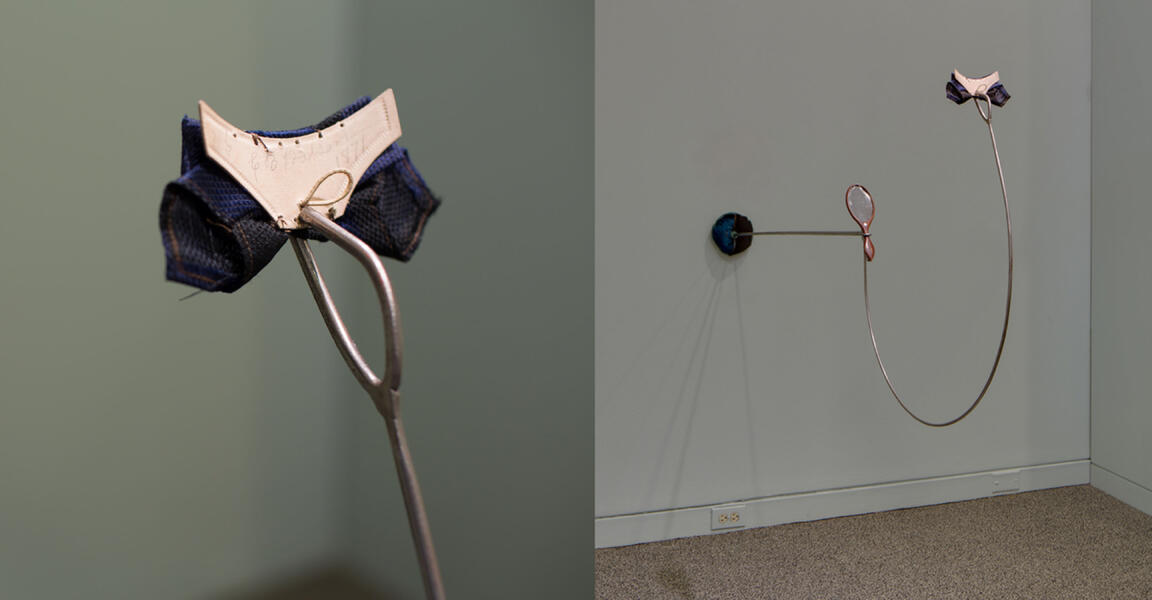 The little knot of which he was the head and front, wherein he was supremeMy great great grandfather's bow-tie 1871, my great great great grandmother's mirror 1852, fabric from the wedding dresses of my grandmother (1926), my great, great, grandmother(1866), and me (1999) steel, poly-fill, thread, hardware 33” x 5” x 65”
The little knot of which he was the head and front, wherein he was supremeMy great great grandfather's bow-tie 1871, my great great great grandmother's mirror 1852, fabric from the wedding dresses of my grandmother (1926), my great, great, grandmother(1866), and me (1999) steel, poly-fill, thread, hardware 33” x 5” x 65” -
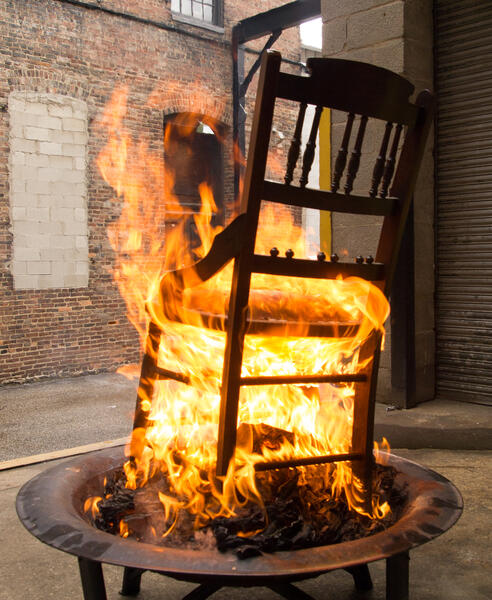 burning the chair to make the paint ( for Turn it over)burning one of my great, grandfather's chairs along with ancestral letters, receipts & documents to mix with acrylic matte medium DESCRIPTION: Chairs have been integral to the work I make, they are representative of the body, place holders for action, as well this armature creates an opportunity to poke at “the museum” as a way to represent special objects. This chair is just a chair, yet my family believes it to be special because of the writing on its underside. It has since been returned to my parents’ apartment and is used frequently as a chair should.
burning the chair to make the paint ( for Turn it over)burning one of my great, grandfather's chairs along with ancestral letters, receipts & documents to mix with acrylic matte medium DESCRIPTION: Chairs have been integral to the work I make, they are representative of the body, place holders for action, as well this armature creates an opportunity to poke at “the museum” as a way to represent special objects. This chair is just a chair, yet my family believes it to be special because of the writing on its underside. It has since been returned to my parents’ apartment and is used frequently as a chair should. -
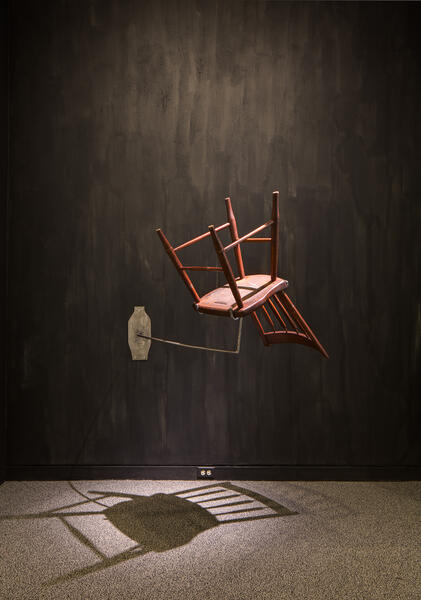 Turn it over, and see how comical it looks; everything appears to have lost its gravity.My great, great, great, grandfather's chair with writing on the bottom "Nagle 184-", paint made from burning one of my great, grandfather's chairs along with ancestral letters, receipts & documents, acrylic matte medium, steel, felt, hardware wall painted with paint made from the burned chair and letters 144" x 112", wood chair is about the size of an upside-down chair at a jaunty angle DESCRIPTION: Chairs have been integral to the work I make, they are representative of the body, place holders for action, as well this armature creates an opportunity to poke at “the museum” as a way to represent special objects. This chair is just a chair, yet my family believes it to be special because of the writing on its underside. It has since been returned to my parents’ apartment and is used frequently as a chair should. 144” x 112” x 50”
Turn it over, and see how comical it looks; everything appears to have lost its gravity.My great, great, great, grandfather's chair with writing on the bottom "Nagle 184-", paint made from burning one of my great, grandfather's chairs along with ancestral letters, receipts & documents, acrylic matte medium, steel, felt, hardware wall painted with paint made from the burned chair and letters 144" x 112", wood chair is about the size of an upside-down chair at a jaunty angle DESCRIPTION: Chairs have been integral to the work I make, they are representative of the body, place holders for action, as well this armature creates an opportunity to poke at “the museum” as a way to represent special objects. This chair is just a chair, yet my family believes it to be special because of the writing on its underside. It has since been returned to my parents’ apartment and is used frequently as a chair should. 144” x 112” x 50” -
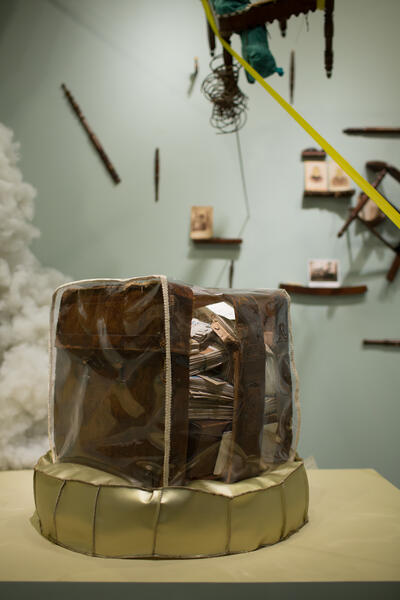 SIR oe'r a gill I gat your cardthe remaining parts of the Nagle family centennial leather trunk (1876) I cherished and subsequently cut up, correspondence letters between my family members 1862-1978, random family legal documents (circa1850-1890) that I am keeping safe for something and for now, vinyl, gimp, polyfil, glue, thread 24” x 22” x 22”
SIR oe'r a gill I gat your cardthe remaining parts of the Nagle family centennial leather trunk (1876) I cherished and subsequently cut up, correspondence letters between my family members 1862-1978, random family legal documents (circa1850-1890) that I am keeping safe for something and for now, vinyl, gimp, polyfil, glue, thread 24” x 22” x 22”
possessions & acquisition of poise
-
 "Alas! how few of us are able to accomplish as much as this apparently senseless oyster, which has actually converted a curse into a blessing, and changed a trial into a treasure!”"Alas! how few of us are able to accomplish as much as this apparently senseless oyster, which has actually converted a curse into a blessing, and changed a trial into a treasure!” detail as I was deinstalling 2018 Title of this work was taken from a family book, Ettie's Leaves from Nature Story-Book 1892 Vol III, by Mrs M A B Kelly #RemarkableSpecimen @stew_artwatson
"Alas! how few of us are able to accomplish as much as this apparently senseless oyster, which has actually converted a curse into a blessing, and changed a trial into a treasure!”"Alas! how few of us are able to accomplish as much as this apparently senseless oyster, which has actually converted a curse into a blessing, and changed a trial into a treasure!” detail as I was deinstalling 2018 Title of this work was taken from a family book, Ettie's Leaves from Nature Story-Book 1892 Vol III, by Mrs M A B Kelly #RemarkableSpecimen @stew_artwatson -
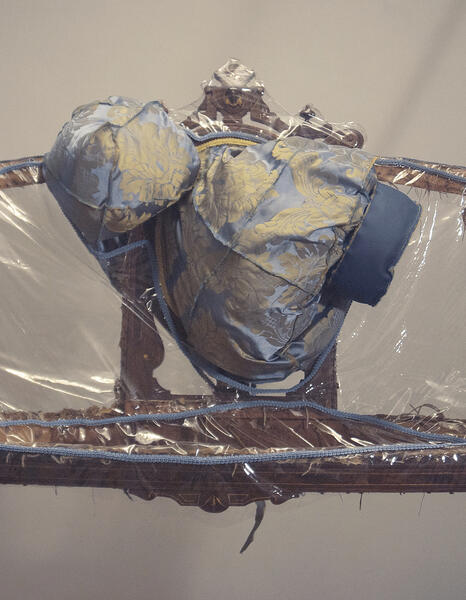 bergere (detail)
bergere (detail) -
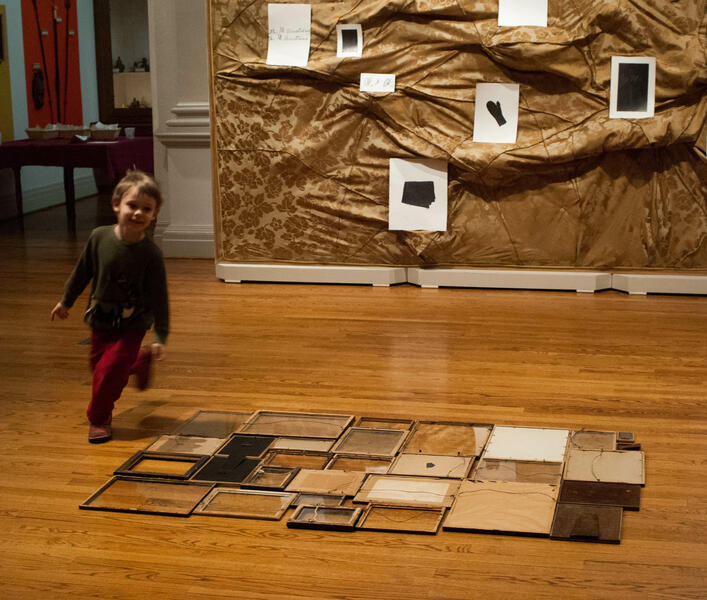 Bebus and floor sample (rug)upholstered faux wall with graphite drawings derived from signatures and engravings from family possessions and accompanying frames each is the size of (floor) 2013 family frames circa 1890-1940, fabric, paper, graphite, polyfil
Bebus and floor sample (rug)upholstered faux wall with graphite drawings derived from signatures and engravings from family possessions and accompanying frames each is the size of (floor) 2013 family frames circa 1890-1940, fabric, paper, graphite, polyfil -
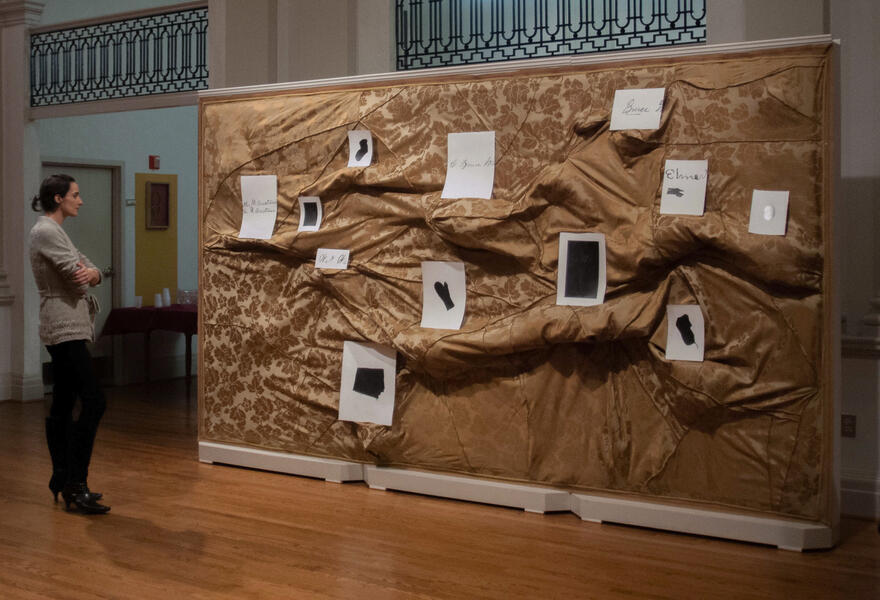 Bebus and drawings 1 through 12Bebus and drawings 1 through 12 2013 fabric, wood wall polyfil, gimp, burlap, thread, pins, paper, graphite 98” x 144” x 17” 1. Burns1883 2. BBW1896 3. teaspoon1852 4. Botany for Young1858 5. MEW1860 6. EMS by GM1894 7. ledger1872 8. Browning1882 9. jamspoon1926 10. EMS1893 11. Lilypad1869 12. saladfork1881
Bebus and drawings 1 through 12Bebus and drawings 1 through 12 2013 fabric, wood wall polyfil, gimp, burlap, thread, pins, paper, graphite 98” x 144” x 17” 1. Burns1883 2. BBW1896 3. teaspoon1852 4. Botany for Young1858 5. MEW1860 6. EMS by GM1894 7. ledger1872 8. Browning1882 9. jamspoon1926 10. EMS1893 11. Lilypad1869 12. saladfork1881 -
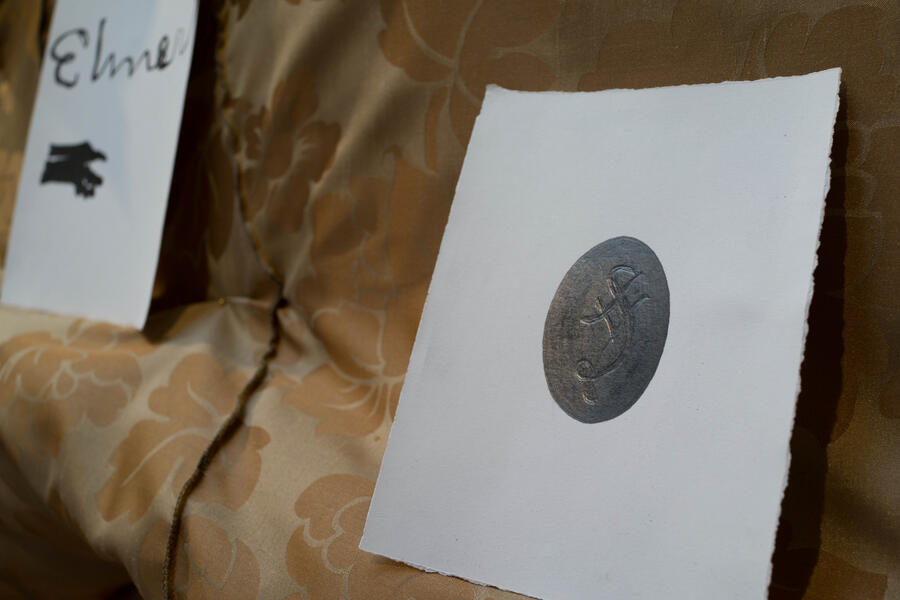 lilypad songsters 1889 and saladfork1881graphite on cotton rag ( these fit vintage family picture frames ) I associate these with little portraits of my ancestors, and have begun to think of them as people I know Bebus and 1 through 12 ( details) fabric, wood wall polyfil, gimp, burlap, thread, pins, paper, graphite 98” x 144” x 17”
lilypad songsters 1889 and saladfork1881graphite on cotton rag ( these fit vintage family picture frames ) I associate these with little portraits of my ancestors, and have begun to think of them as people I know Bebus and 1 through 12 ( details) fabric, wood wall polyfil, gimp, burlap, thread, pins, paper, graphite 98” x 144” x 17” -
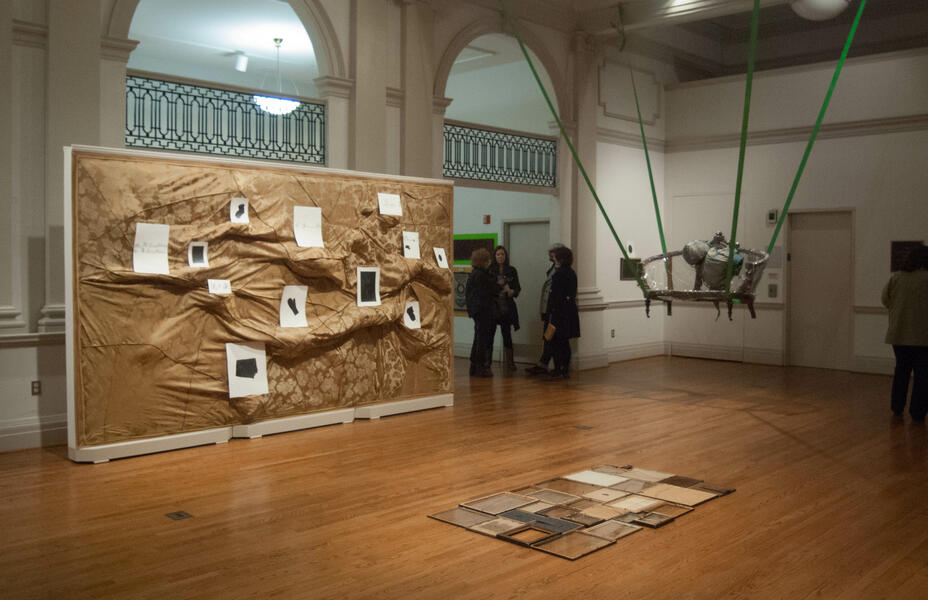 Bebus and drawings 1 through 12upholstered faux wall with graphite drawings derived from signatures and engravings from family possessions
Bebus and drawings 1 through 12upholstered faux wall with graphite drawings derived from signatures and engravings from family possessions -
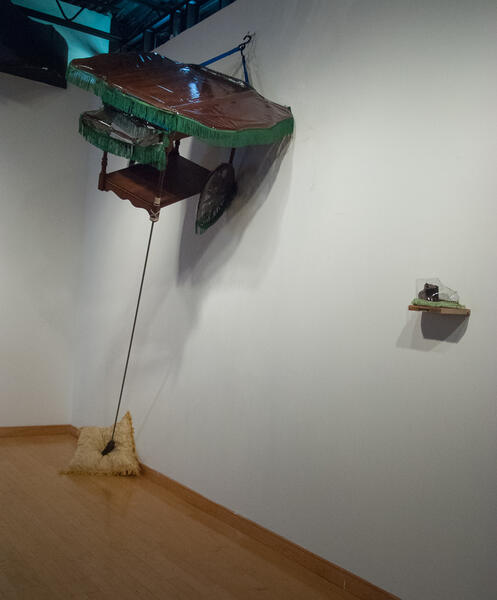 stationary ambitude and shoeMy Mother's Walnut Tea Cart circa 1930, vinyl, fringe, aluminum, cotton string, fabric, thread, glue, hardware, polyfil, ratcheting strap, pin 2013 leather shoe belonging to SMN 1870, fabric, vinyl, wood from dresser belonging to PSS 1920 2013
stationary ambitude and shoeMy Mother's Walnut Tea Cart circa 1930, vinyl, fringe, aluminum, cotton string, fabric, thread, glue, hardware, polyfil, ratcheting strap, pin 2013 leather shoe belonging to SMN 1870, fabric, vinyl, wood from dresser belonging to PSS 1920 2013 -
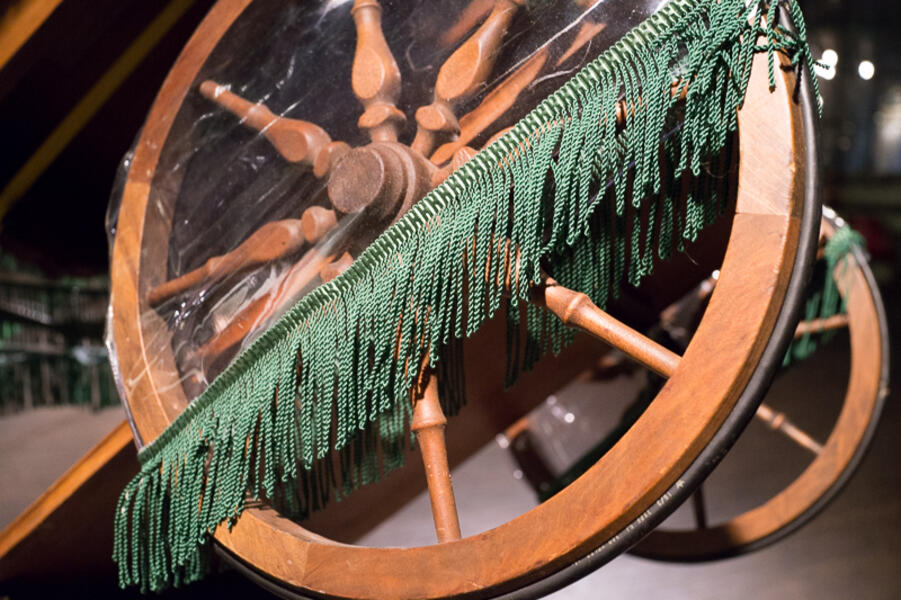 stationary abmitude (detail)My Mother's Walnut Tea Cart circa 1930, vinyl, fringe, aluminum, cotton string, fabric, thread, glue, hardware, polyfil, ratcheting strap, pin 2013 installed at Area 405 October 2013 for studio visit with Mera Rubell for WPA 36 Studios
stationary abmitude (detail)My Mother's Walnut Tea Cart circa 1930, vinyl, fringe, aluminum, cotton string, fabric, thread, glue, hardware, polyfil, ratcheting strap, pin 2013 installed at Area 405 October 2013 for studio visit with Mera Rubell for WPA 36 Studios -
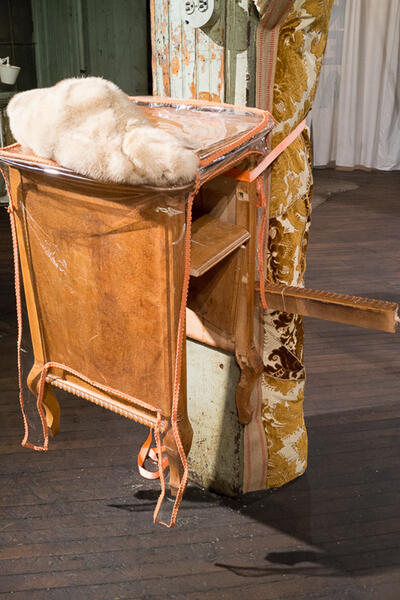 rememberment ( with Melvin)My Grandfather Stewart's Birdseye Maple dresser circa 1920, vinyl, fabric, goose feathers, Great Aunt Ada Smith's blond mink, polyfil, thread, gimp, thread, glue, hardware, ratcheting strap. 2013 36" x 22" x 14" ( variable with column) I strapped this to column after hacking it apart, cutting it down, and reassembling it. I had lived with this dresser growing up at my Grand's, then at my house. It's safely strapped to the column with Melvin's soft and fluffy resting pad for comfort and security.
rememberment ( with Melvin)My Grandfather Stewart's Birdseye Maple dresser circa 1920, vinyl, fabric, goose feathers, Great Aunt Ada Smith's blond mink, polyfil, thread, gimp, thread, glue, hardware, ratcheting strap. 2013 36" x 22" x 14" ( variable with column) I strapped this to column after hacking it apart, cutting it down, and reassembling it. I had lived with this dresser growing up at my Grand's, then at my house. It's safely strapped to the column with Melvin's soft and fluffy resting pad for comfort and security. -
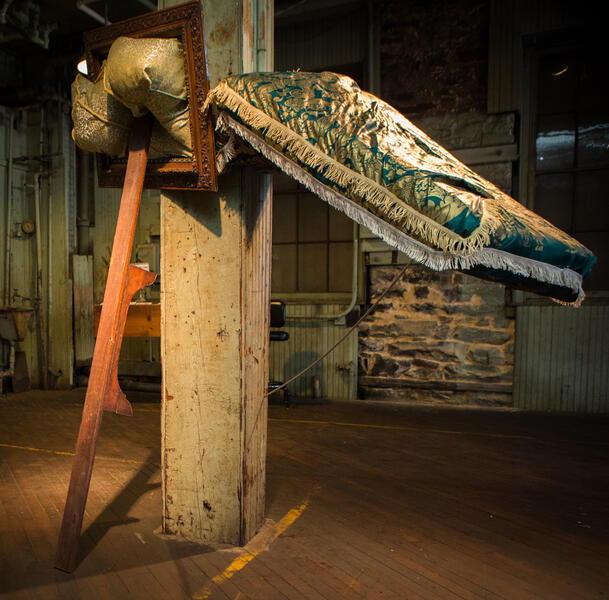 Allegheny Mountains; horseshoe curve, if that river were really all goldGreat Great Grandmother Mierly's picture frame, wood from the library table, fabric, gimp, goose feathers, polyfil, foam, springs, stainless steel, hardware, fringe, glue, pins, copper tacks, thread 77" x 80" x 50" 2013 installed in Oct Area 405 for a studio visit w Mera Rubell for WPA 36 studios
Allegheny Mountains; horseshoe curve, if that river were really all goldGreat Great Grandmother Mierly's picture frame, wood from the library table, fabric, gimp, goose feathers, polyfil, foam, springs, stainless steel, hardware, fringe, glue, pins, copper tacks, thread 77" x 80" x 50" 2013 installed in Oct Area 405 for a studio visit w Mera Rubell for WPA 36 studios
Family rooms, Furnishings and Flourishes
As family or species, so much of what we are is similar that only a tiny bit makes us unique. These slight yet all important differences interest me. Genealogy, genetics and items — from photographs to furnishings — preserved as family artifacts inform me as I uncover generations of ancestors through each new sculptural environment.
There is a tension in the viewer’s perception that comes from my attraction to opposites and from the way materials are manipulates; where balance, prop, drop, decay and remain. Moments of tension, nostalgia, humor and interdependence are revealed in the precariousness of each site specific installation; as though both the physical and metaphorical home are on the verge of going from idyllic to chaotic, pushed to it’s limit by uncertainty, a family row, or of a natural disaster.
The furniture for "Bergere", "Allegheny Mountains", and "If I found it in the photograph" are all family pieces that were passed down to me. Each is researched by family verbal history, photographic information, and actual writing pertaining to lineage on the furniture that identifies where things came from. These furnishings are significant for their age and family ownership, not for their value or usefulness in contemporary settings. At this time, this was a new aspect of the work I was just beginning to figure out by actually using, deconstructing and repurposing the pieces to continue a dialog with and about genealogy and object.
-
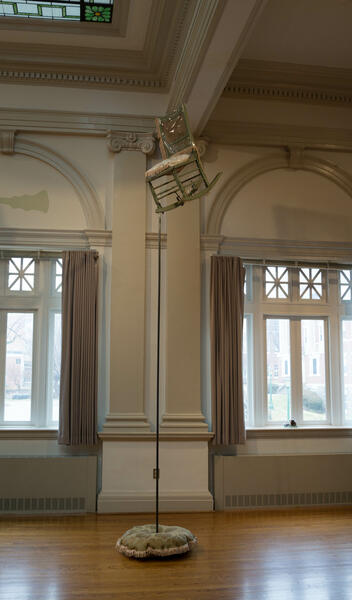 if you will be quiet, and sit down with your book, like a good girlGreat grandmother Smith's favourite rocking chair, my Father's-and possibly his father's clamps, steel, fabric, goose feathers, polyfil, vinyl, tassels, thread. 160” x 30” x 30” 2013
if you will be quiet, and sit down with your book, like a good girlGreat grandmother Smith's favourite rocking chair, my Father's-and possibly his father's clamps, steel, fabric, goose feathers, polyfil, vinyl, tassels, thread. 160” x 30” x 30” 2013 -
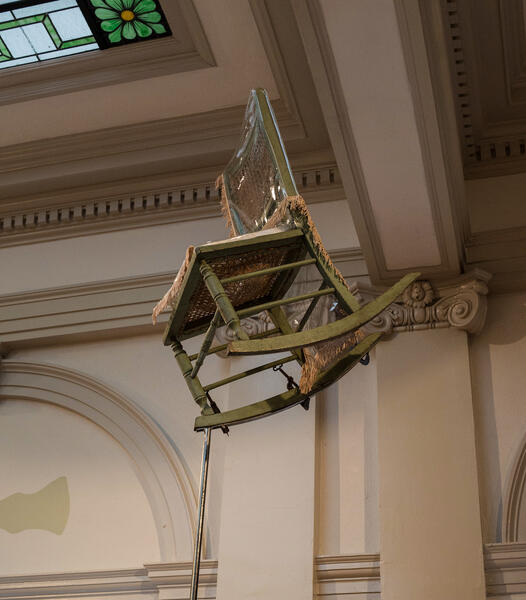 if you will be quiet, and sit down with your book, like a good girl (detail)
if you will be quiet, and sit down with your book, like a good girl (detail) -
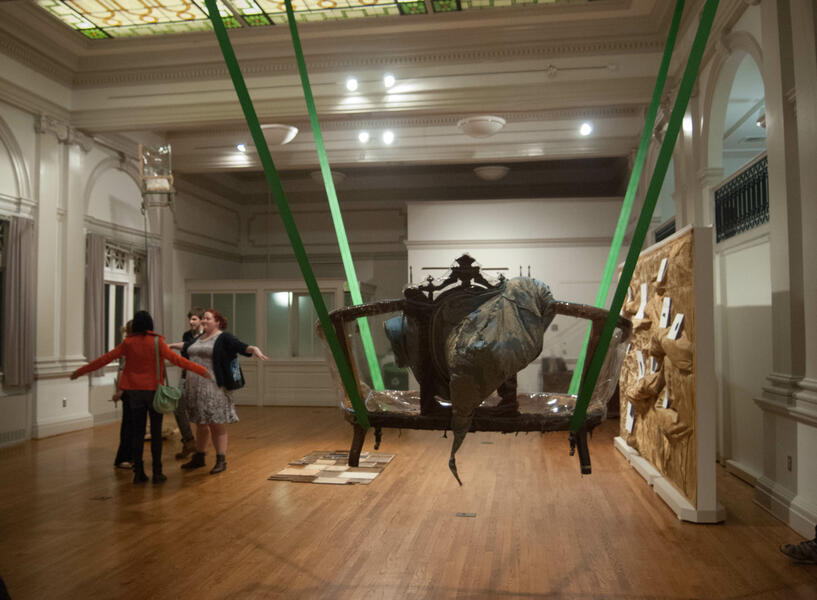 bergerePossessions installation view
bergerePossessions installation view -
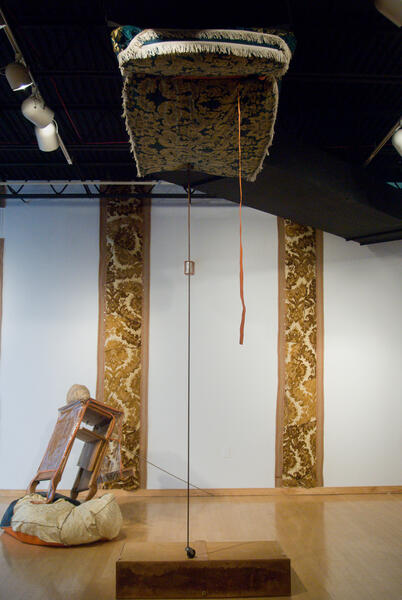 Ah, said Gluck, if that river were all made of gold!air duct, steel, cotton, fabric, foam,drawer from my grandmother's circa 1920 dresser, steel, fringe, caster, ratcheting strap, glue, pins, thread 2013 for Melvin and Melvin fabric, burlap, staples, thread, polyfil, pins 2013 variable wall installation, for leaning
Ah, said Gluck, if that river were all made of gold!air duct, steel, cotton, fabric, foam,drawer from my grandmother's circa 1920 dresser, steel, fringe, caster, ratcheting strap, glue, pins, thread 2013 for Melvin and Melvin fabric, burlap, staples, thread, polyfil, pins 2013 variable wall installation, for leaning -
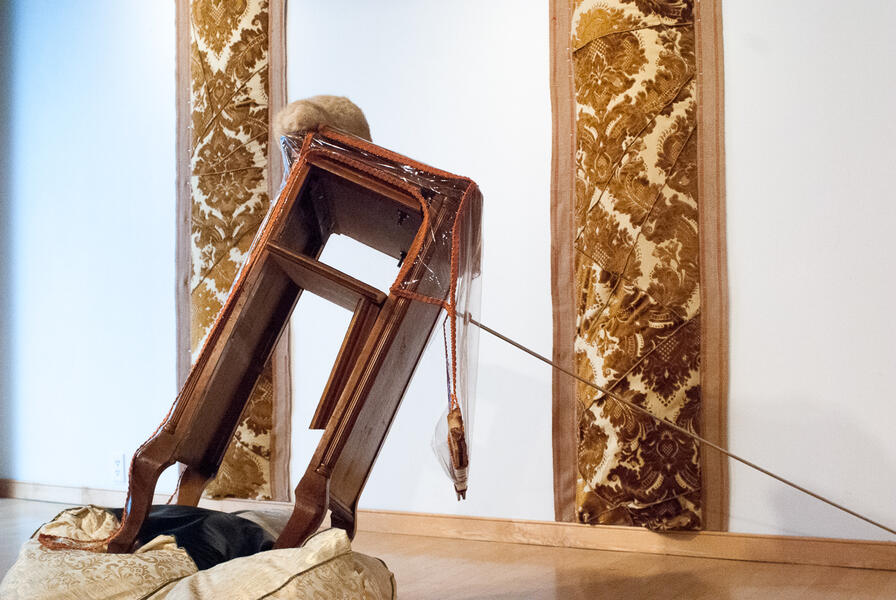 remembermentMy Grandfather Stewart's Birdseye Maple dresser circa 1920, vinyl, fabric, goose feathers, Great Aunt Ada Smith's blond mink, polyfil, thread, gimp, thread, glue, hardware variable - here it is teetering without a column and with Melvin & Melvin and small, vinyl and gimp cover for motion detector. 2013 36" x 22" x 14" I strapped this to the after taking it apart and reassembling it. I had lived with this dresser growing up at my Grand's, then at my house for years. 2013
remembermentMy Grandfather Stewart's Birdseye Maple dresser circa 1920, vinyl, fabric, goose feathers, Great Aunt Ada Smith's blond mink, polyfil, thread, gimp, thread, glue, hardware variable - here it is teetering without a column and with Melvin & Melvin and small, vinyl and gimp cover for motion detector. 2013 36" x 22" x 14" I strapped this to the after taking it apart and reassembling it. I had lived with this dresser growing up at my Grand's, then at my house for years. 2013 -
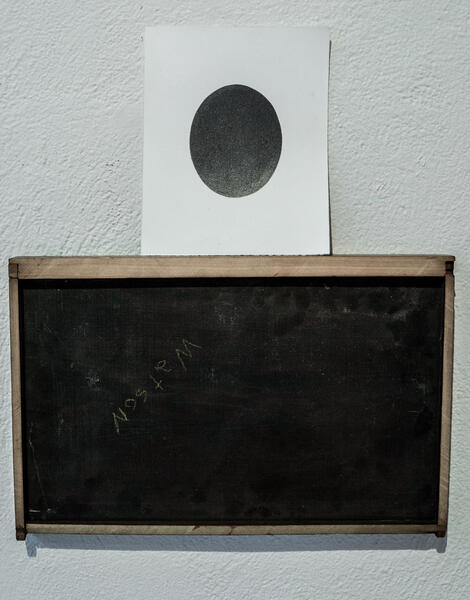 the drawer and the self portraitgraphite on paper 5" x 7", drawer from my grandfather's side table c 1910, with Watson written on it, just so we'd know where it came from, as with all of our furniture, and books 15" x 15" x 2" approx 2012
the drawer and the self portraitgraphite on paper 5" x 7", drawer from my grandfather's side table c 1910, with Watson written on it, just so we'd know where it came from, as with all of our furniture, and books 15" x 15" x 2" approx 2012 -
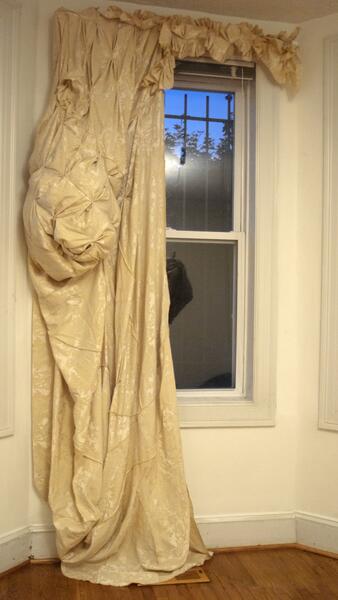 Festoonfabric, thread, curtain rod, goose feathers 105” x 40” x 14” variable installed at Delicious Spectacle, Washington, DC September 2012 for “it was my”
Festoonfabric, thread, curtain rod, goose feathers 105” x 40” x 14” variable installed at Delicious Spectacle, Washington, DC September 2012 for “it was my” -
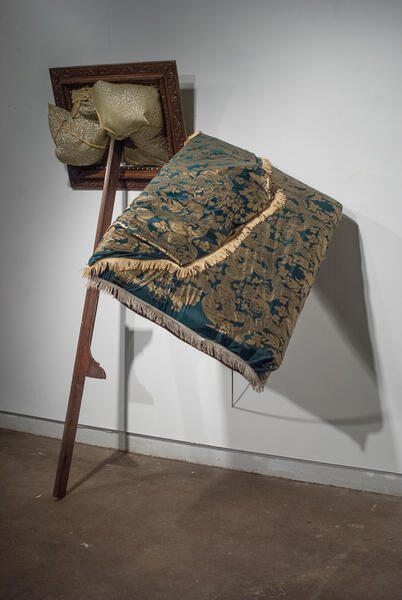 Allegheny Mountains, horseshoe curve, if that river were really all goldGreat Great Grandmother Mierly's picture frame, wood from the library table, fabric, gimp, goose feathers, polyfil, foam, springs, stainless steel, hardware, fringe, glue, pins, copper tacks, thread 77” x 80” x 50”
Allegheny Mountains, horseshoe curve, if that river were really all goldGreat Great Grandmother Mierly's picture frame, wood from the library table, fabric, gimp, goose feathers, polyfil, foam, springs, stainless steel, hardware, fringe, glue, pins, copper tacks, thread 77” x 80” x 50” -
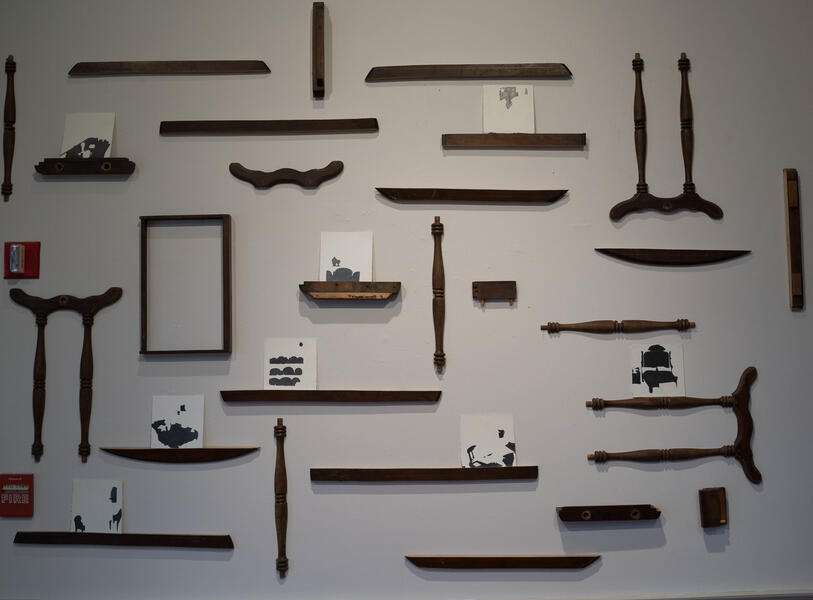 if I found it in the photographgraphite on cotton rag paper, Grandfather Watson's side table circa 1910 ( with Watson written on underside by my obsessive grandmother) paper 7” x 7”, wall installation 100” x 140” x 1” installed at McDaniel College January 2013 for solo exhibition “possessions ” Each drawn image was the product of looking at family photo albums and drawing silhouettes only of "heirloom" items I currently have in my possession, thus creating the compositions.This is an ongoing series.
if I found it in the photographgraphite on cotton rag paper, Grandfather Watson's side table circa 1910 ( with Watson written on underside by my obsessive grandmother) paper 7” x 7”, wall installation 100” x 140” x 1” installed at McDaniel College January 2013 for solo exhibition “possessions ” Each drawn image was the product of looking at family photo albums and drawing silhouettes only of "heirloom" items I currently have in my possession, thus creating the compositions.This is an ongoing series. -
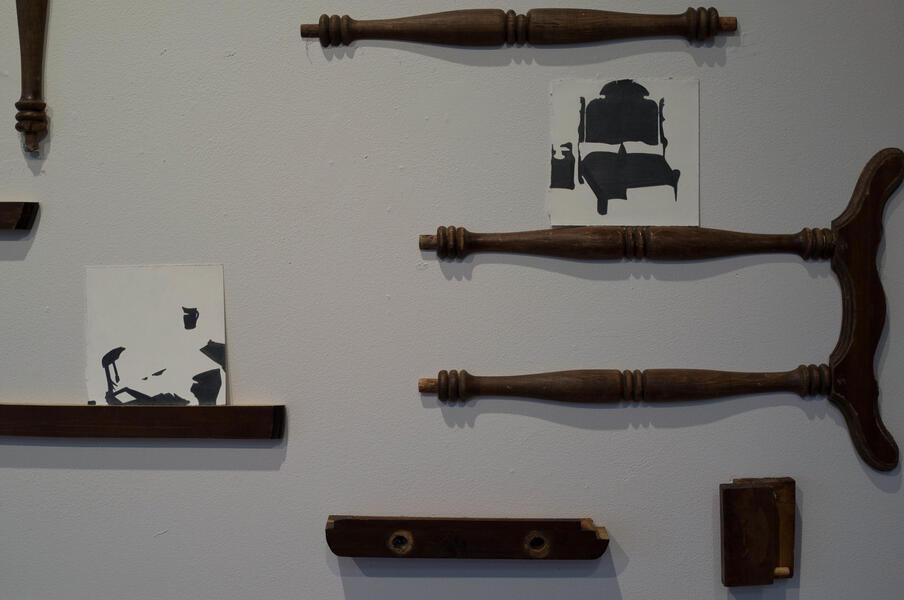 if I found it in the photograph (detail)graphite on cotton rag paper, Grandfather Watson's side table circa 1910 ( with Watson written on underside by my obsessive grandmother) paper 7” x 7”, wall installation 100” x 140” x 1” installed at McDaniel College January 2013 for solo exhibition “possessions ” Each drawn image was the product of looking at family photo albums and drawing silhouettes only of "heirloom" items I currently have in my possession, thus creating the compositions.- This is an ongoing series.
if I found it in the photograph (detail)graphite on cotton rag paper, Grandfather Watson's side table circa 1910 ( with Watson written on underside by my obsessive grandmother) paper 7” x 7”, wall installation 100” x 140” x 1” installed at McDaniel College January 2013 for solo exhibition “possessions ” Each drawn image was the product of looking at family photo albums and drawing silhouettes only of "heirloom" items I currently have in my possession, thus creating the compositions.- This is an ongoing series.
IVF and Balance
Objects are balanced or prodded in ways that accentuate the parlous nature of elements in space. Some seem to defy gravity, while others revel in its existence.
Honesty in presentation and material remains vital to my work. There are no secret hangers keeping the work from toppling over. The precariousness is real as is the potential for a kinetic event.
This work really was about engaging with the public and beginning to draw them into my work in a new way. I began to share my personal narrative more openly, became lighter and more playful in the way I worked with material, while subtlety layering in gravitas content.
-
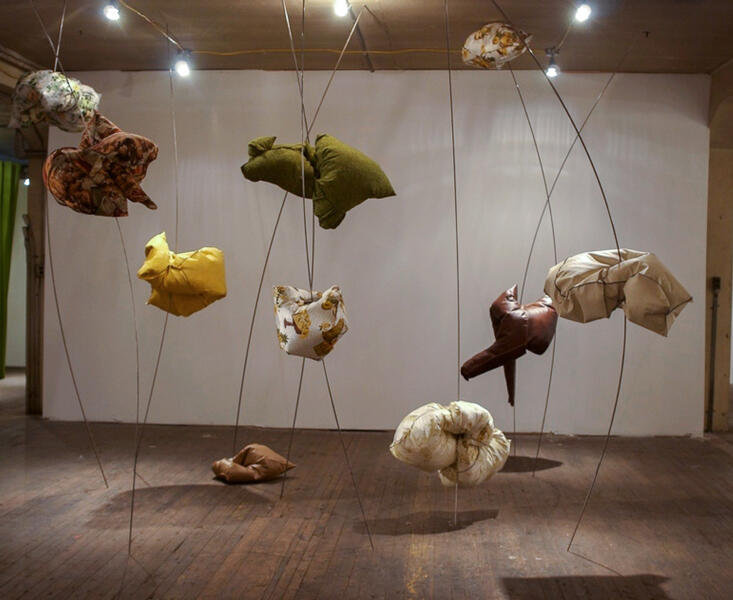 other good looks: c afabric, vinyl, goose feathers, polyfil, steel, caster, thread 118" x 200" x 150" ( variable) each pouf/rod combination is sprung between ceiling and floor only with tension. installed for the WPA Options exhibition Fall 2011
other good looks: c afabric, vinyl, goose feathers, polyfil, steel, caster, thread 118" x 200" x 150" ( variable) each pouf/rod combination is sprung between ceiling and floor only with tension. installed for the WPA Options exhibition Fall 2011 -
 the golden gift: no trifling testimony to the comfortable beliefleopard print fabric, upholstery fabric, vinyl, goose feathers, polyfil, raw wool, steel, gimp, burlap, staples, tassels, thread, pins, ductwork 144" x 60" x 70" variable 2014
the golden gift: no trifling testimony to the comfortable beliefleopard print fabric, upholstery fabric, vinyl, goose feathers, polyfil, raw wool, steel, gimp, burlap, staples, tassels, thread, pins, ductwork 144" x 60" x 70" variable 2014 -
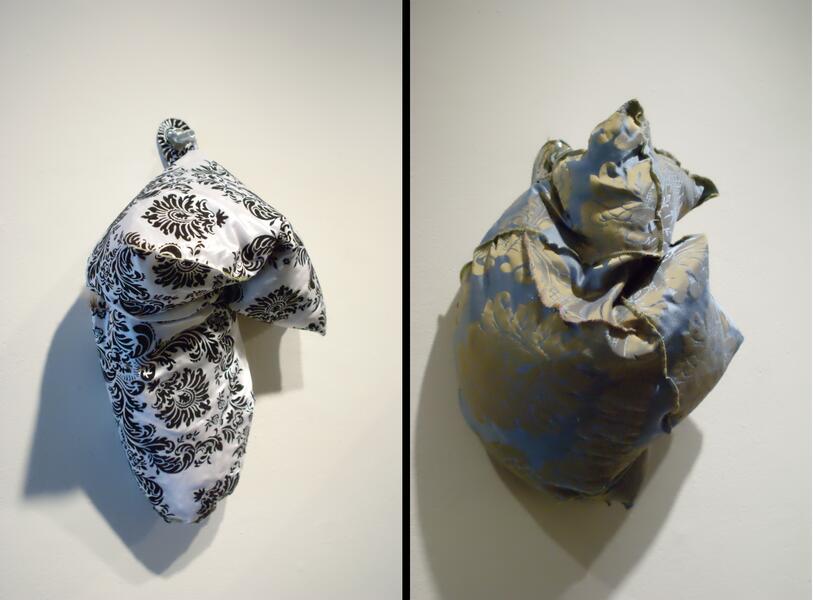 Queue Puffs: for head, neck, shoulder, and hipI installed these puffs to be leaned upon while people were waiting for the theatre queue that came through the gallery, however instead of appreciating the soft spots, they were annoyed that they could no longer lean on the wall of the gallery. two that I particularly liked flocked fabric, damask fabric, goose feathers, thread, hardware these were for neck, head, or shoulder, depending on one's height. 2011, 18" x 11" x 8" (queue puff)
Queue Puffs: for head, neck, shoulder, and hipI installed these puffs to be leaned upon while people were waiting for the theatre queue that came through the gallery, however instead of appreciating the soft spots, they were annoyed that they could no longer lean on the wall of the gallery. two that I particularly liked flocked fabric, damask fabric, goose feathers, thread, hardware these were for neck, head, or shoulder, depending on one's height. 2011, 18" x 11" x 8" (queue puff) -
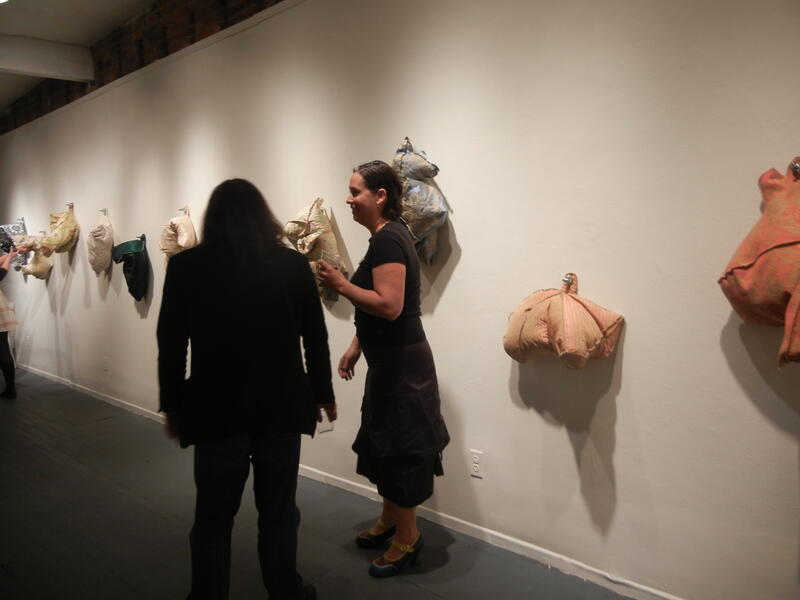 Queue Puffs: for head, neck, shoulder, and hipI installed these puffs to be leaned upon while people were waiting for the theatre queue that came through the gallery, however instead of appreciating the soft spots, they were annoyed that they could no longer lean on the wall of the gallery. Flocked fabric, damask fabric, goose feathers, thread, hardware installed at DCAC, 2011 18" x 11" x 8" (each queue puff, approximate) wall length 60 feet
Queue Puffs: for head, neck, shoulder, and hipI installed these puffs to be leaned upon while people were waiting for the theatre queue that came through the gallery, however instead of appreciating the soft spots, they were annoyed that they could no longer lean on the wall of the gallery. Flocked fabric, damask fabric, goose feathers, thread, hardware installed at DCAC, 2011 18" x 11" x 8" (each queue puff, approximate) wall length 60 feet -
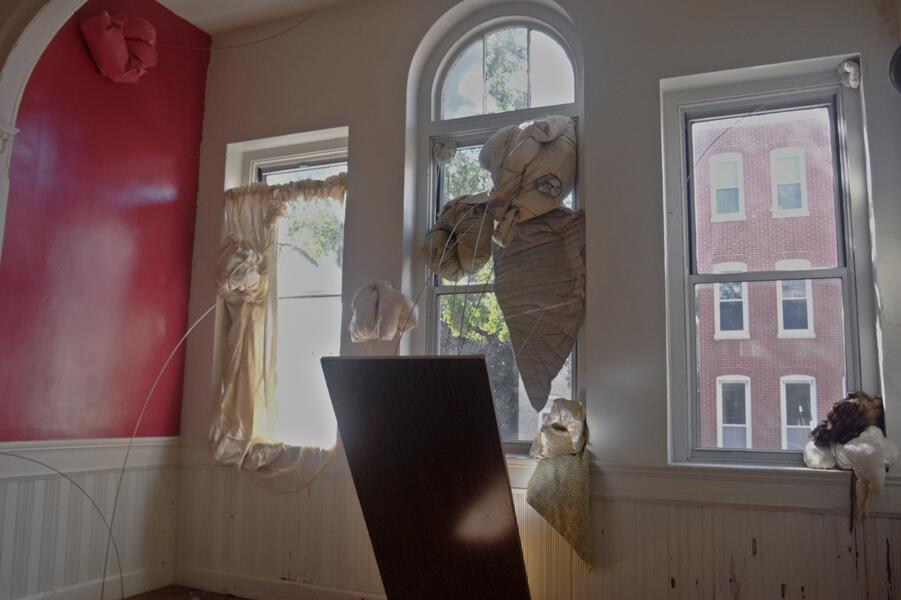 selections for comfort and style: festoon, convolute murphy, puff for petting2011 upholstery fabric, drapery fabric, vinyl, goose feathers, polyfil, steel, hollow core door, mink fur, hardware,paint 192” x 325” x 70” installed at JF Contemporary October- Nov 2011
selections for comfort and style: festoon, convolute murphy, puff for petting2011 upholstery fabric, drapery fabric, vinyl, goose feathers, polyfil, steel, hollow core door, mink fur, hardware,paint 192” x 325” x 70” installed at JF Contemporary October- Nov 2011 -
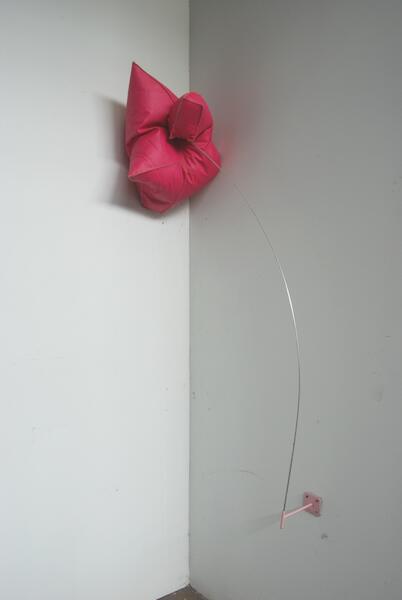 pinky
pinky -
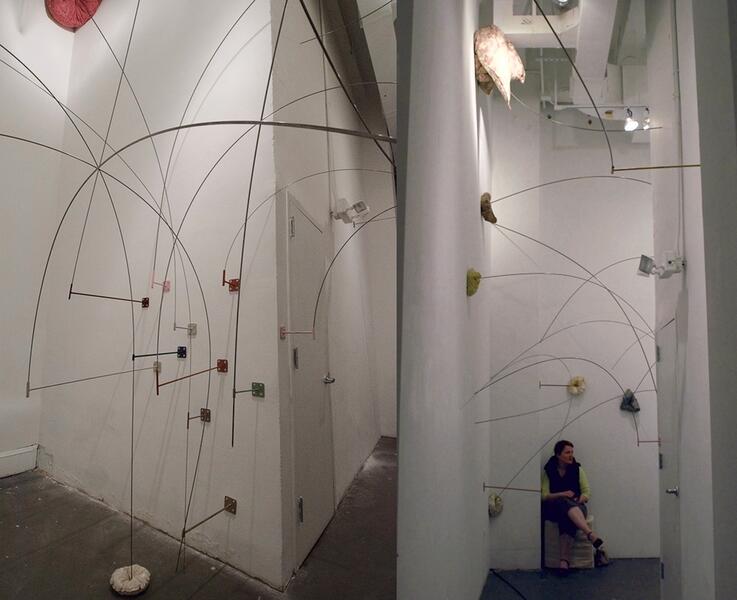 I V FInstalled in an "L" shaped room at the Contemporary Museum Baltimore May 2011 210" x 68" x 157" x 357" variable Having gone through IVF myself, I had been poked and prodded with so many needles it was almost comical thinking of the participants ducking through the rods as they bent around the precarious museum space and sprung to the wall, I wanted them the feel as anxious and exhilarated as we were going through the intensity of the process.
I V FInstalled in an "L" shaped room at the Contemporary Museum Baltimore May 2011 210" x 68" x 157" x 357" variable Having gone through IVF myself, I had been poked and prodded with so many needles it was almost comical thinking of the participants ducking through the rods as they bent around the precarious museum space and sprung to the wall, I wanted them the feel as anxious and exhilarated as we were going through the intensity of the process. -
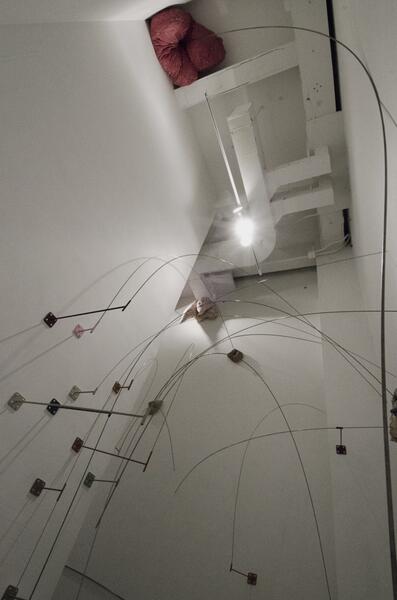 I V Fsteel, upholstery fabric, feathers, raw wool, thread, paint, hardware installed in "L" shaped room at The Contemporary 210" x 68" x 157" x 357" variable
I V Fsteel, upholstery fabric, feathers, raw wool, thread, paint, hardware installed in "L" shaped room at The Contemporary 210" x 68" x 157" x 357" variable -
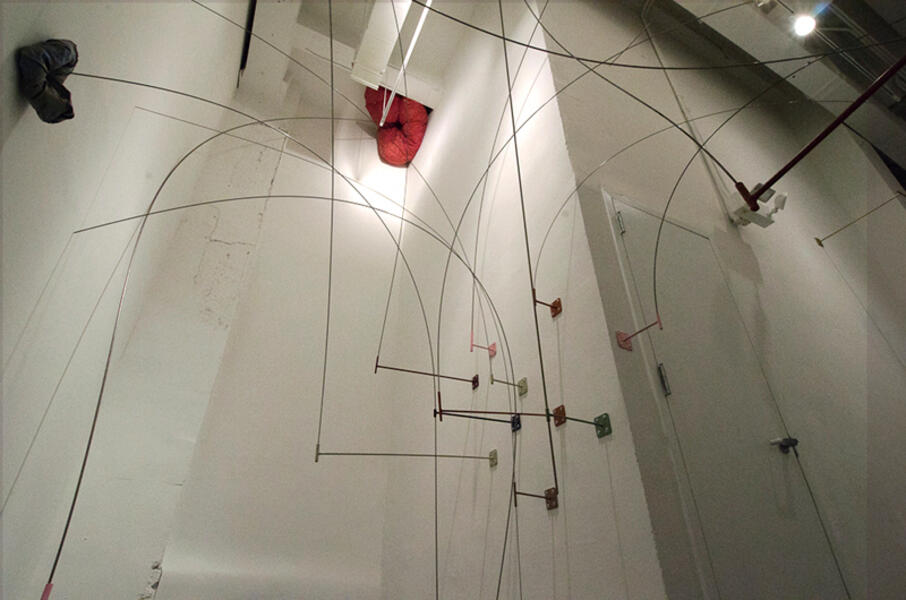 I V Fsteel, upholstery fabric, feathers, raw wool, thread, paint, hardware installed in "L" shaped room at the Contemporary Museum Baltimore May 2011 210" x 68" x 157" x 357" variable IVF, sprung with tension, like awaiting the news of pregnancy, and the space was like a fallopian tube. Only 3 people at a time could be in the space for fear that a tensioned rod might spring loose, but to be in the space was exciting and nerve-wracking.
I V Fsteel, upholstery fabric, feathers, raw wool, thread, paint, hardware installed in "L" shaped room at the Contemporary Museum Baltimore May 2011 210" x 68" x 157" x 357" variable IVF, sprung with tension, like awaiting the news of pregnancy, and the space was like a fallopian tube. Only 3 people at a time could be in the space for fear that a tensioned rod might spring loose, but to be in the space was exciting and nerve-wracking. -
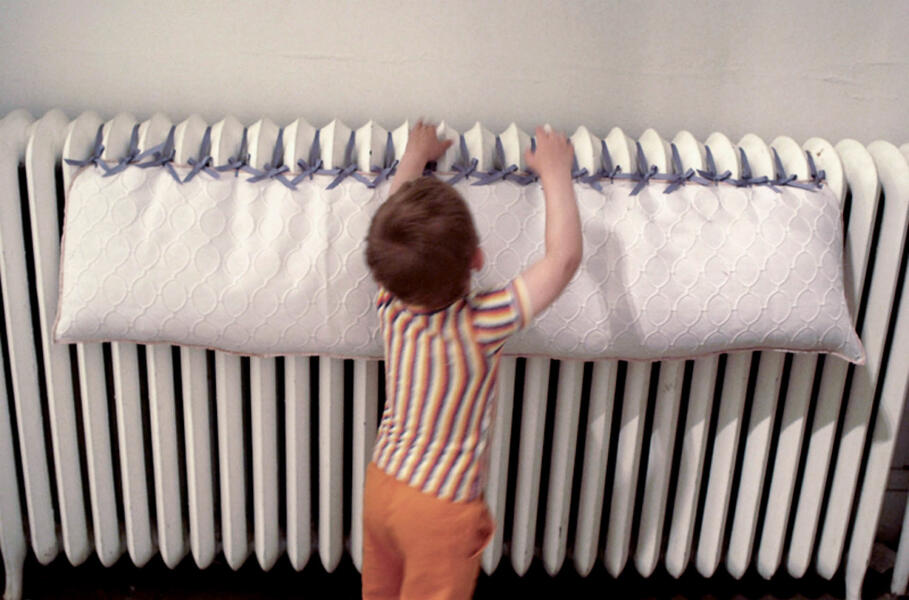 Puff for Waitingfabric, goose down, thread, gross grain ribbon, radiator 2011 installed at the Contemporary Museum Baltimore for my solo exhibition for the this was installed between "I V F" and the restrooms of the museum. It was made to give folks somewhere to wait to as only 3 at a time could go into my installation I V F. It seemed natural to offer a place to take a break - and for anyone who has done IVF, like me, there is a serious amount of waiting involved-and bathrooms.
Puff for Waitingfabric, goose down, thread, gross grain ribbon, radiator 2011 installed at the Contemporary Museum Baltimore for my solo exhibition for the this was installed between "I V F" and the restrooms of the museum. It was made to give folks somewhere to wait to as only 3 at a time could go into my installation I V F. It seemed natural to offer a place to take a break - and for anyone who has done IVF, like me, there is a serious amount of waiting involved-and bathrooms.
Genetic Feathers and the Beginning of Disasters
I was thinking about the relationship of guinea fowls and the scientists who use them in genetics testing. I was noting the distinct patterns of each feather, reflecting on each being unique yet similar enough to others. Combined, the feathers form the whole bird. Each feather maintains it’s difference, it’s uniqueness, yet still part of a singular bird.
The idea of uniqueness, yet being part of a whole became increasingly important as I was going through fertility treatments, actually getting pregnant, and becoming a mother, becoming part of something unique, collective, and bigger than myself.
I also liked how feathers were actually light rather than heavy, making them a convenient antethetical metaphor for what I was going through.
-
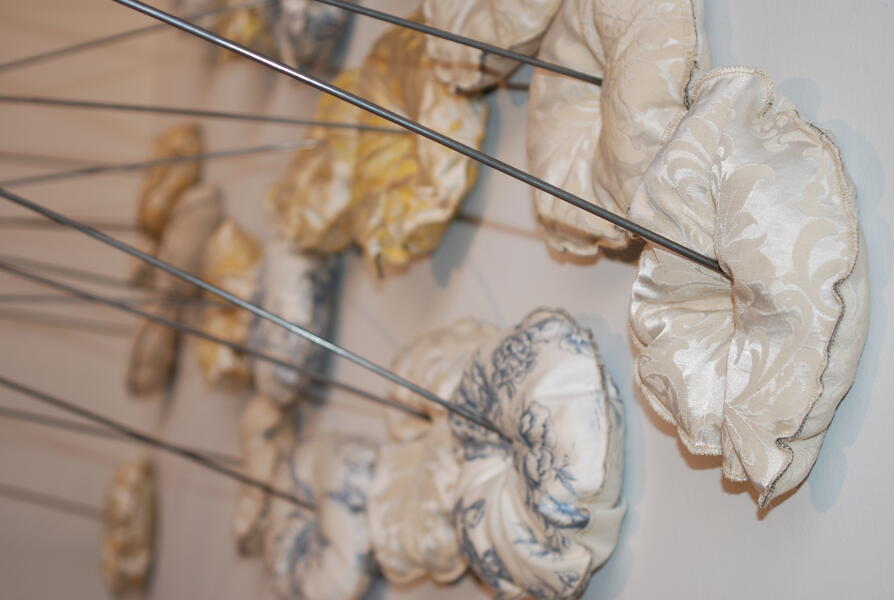 inheritance (detail)steel, upholstery fabric, raw wool, thread, holes 96" x 80" x 80" 2009
inheritance (detail)steel, upholstery fabric, raw wool, thread, holes 96" x 80" x 80" 2009 -
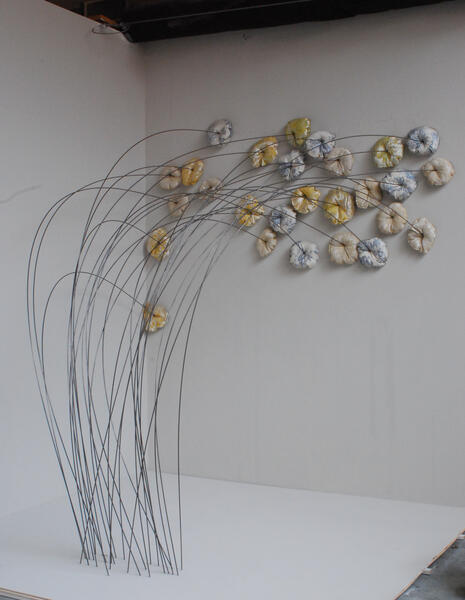 inheritancesteel, upholstery fabric, raw wool, thread, holes 96" x 80" x 80" 2009
inheritancesteel, upholstery fabric, raw wool, thread, holes 96" x 80" x 80" 2009 -
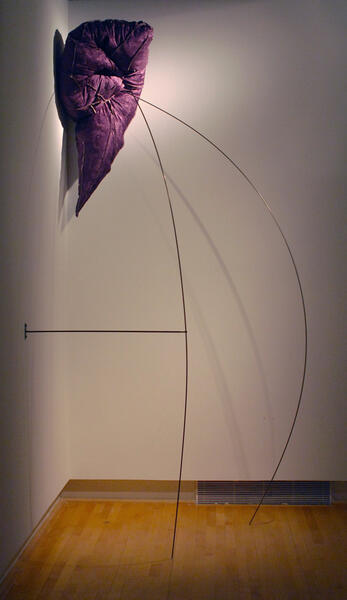 potential disaster: pq2010 Upholstery fabric, goose feathers, steel, thread 130” x 54” x 63” balancing a huge, heavy feather filled poufy thing that just might collapse is actually rather funny.
potential disaster: pq2010 Upholstery fabric, goose feathers, steel, thread 130” x 54” x 63” balancing a huge, heavy feather filled poufy thing that just might collapse is actually rather funny. -
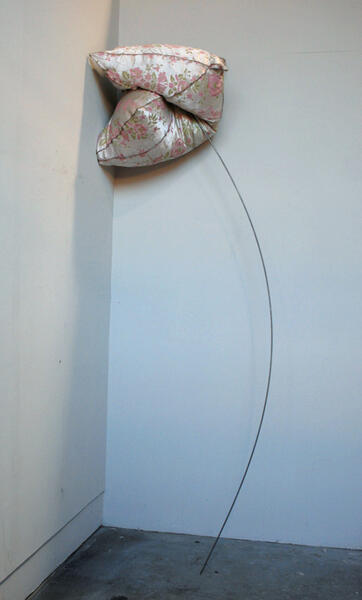 potential disaster :agoose feathers, vintage upholstery fabric, steel propping and balance 2009 100" x 25" x 35" I think the reason I like these so much is that there is nothing so scary about a pillow I also respect that the the soft thing is actually holding up the rod instead of the other way around
potential disaster :agoose feathers, vintage upholstery fabric, steel propping and balance 2009 100" x 25" x 35" I think the reason I like these so much is that there is nothing so scary about a pillow I also respect that the the soft thing is actually holding up the rod instead of the other way around -
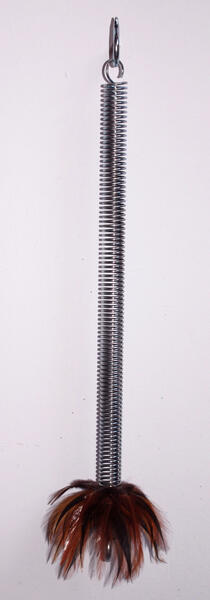 no spring chicken2009 15" x 8" x 5" studio fun spring, pheasant neck feathers, hardware
no spring chicken2009 15" x 8" x 5" studio fun spring, pheasant neck feathers, hardware -
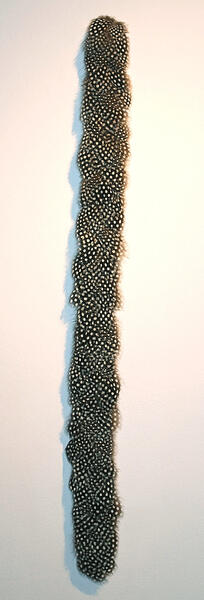 inheritedguinea fowl feathers, drywall, holes 21" x 2" x 1" . I drilled hundreds of holes and placed one feather in each from one particular Guinea Fowl, it was a quiet and meditative response to the need to make while pregnant. 2008 Also thinking about IVF, genetics, random/ not random DNA and giving order to a bag of feathery in-order.
inheritedguinea fowl feathers, drywall, holes 21" x 2" x 1" . I drilled hundreds of holes and placed one feather in each from one particular Guinea Fowl, it was a quiet and meditative response to the need to make while pregnant. 2008 Also thinking about IVF, genetics, random/ not random DNA and giving order to a bag of feathery in-order. -
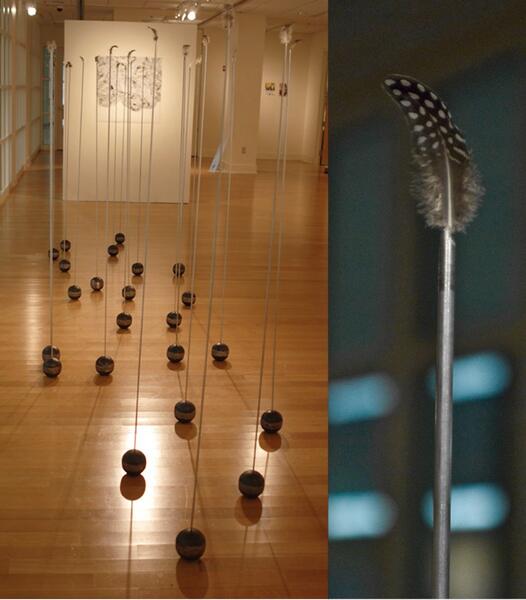 tin types; family portraitsteel, lead, aluminum, guinea fowl feathers from 1 bird, 64" x 55" x 120" each one of these was made to my exact height.
tin types; family portraitsteel, lead, aluminum, guinea fowl feathers from 1 bird, 64" x 55" x 120" each one of these was made to my exact height. -
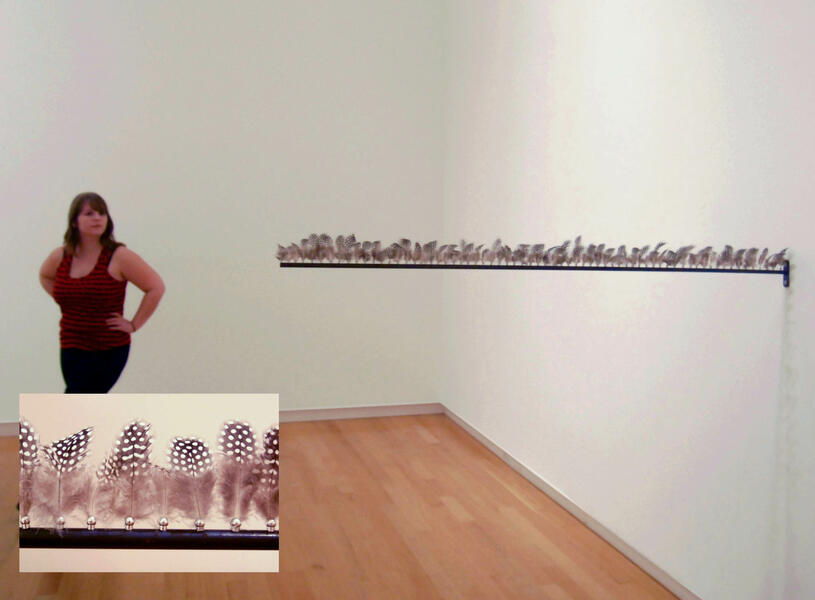 twice removed: Harry Smith2009/2011 steel, tin, guinea fowl feathers balanced on rod 55: x 2: x 50” With a single breath, they flutter to the ground.
twice removed: Harry Smith2009/2011 steel, tin, guinea fowl feathers balanced on rod 55: x 2: x 50” With a single breath, they flutter to the ground. -
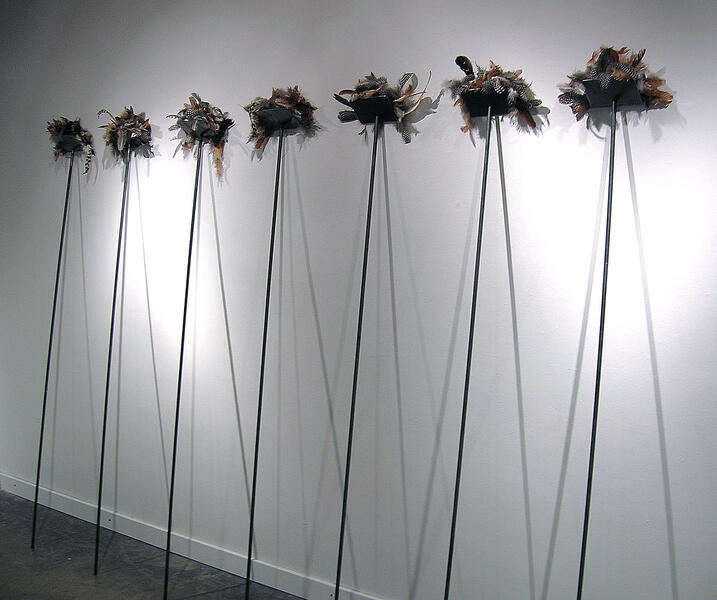 f 2steel, guinea fowl feathers, cochin feathers 75" x 120" x 20". 2009
f 2steel, guinea fowl feathers, cochin feathers 75" x 120" x 20". 2009 -
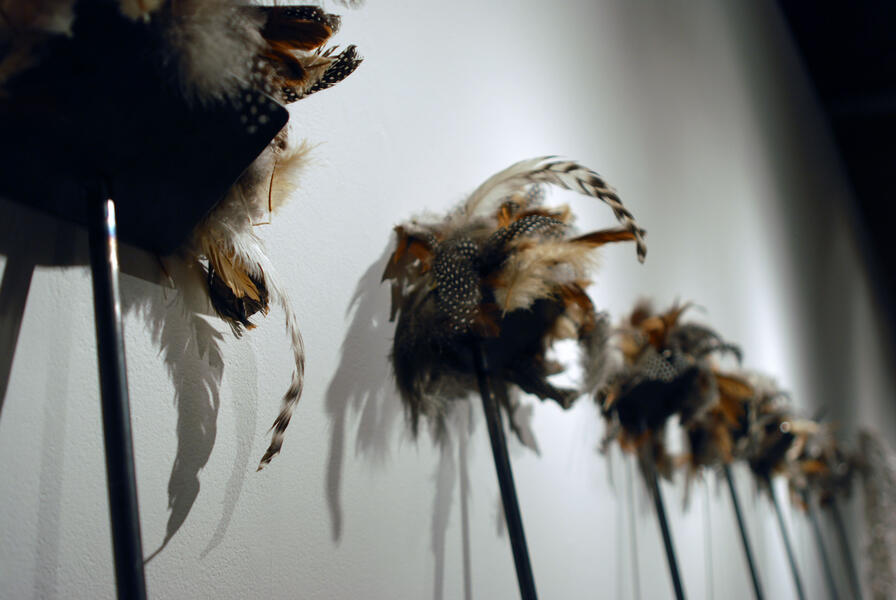 f2 detailsteel, guinea fowl feathers, cochin feathers. Propping these shovel -like implements to the wall. 75" x 120" x 20". 2009
f2 detailsteel, guinea fowl feathers, cochin feathers. Propping these shovel -like implements to the wall. 75" x 120" x 20". 2009
Senseless Oyster
"Alas! how few of us are able to accomplish as much as this apparently senseless oyster, which has actually converted a curse into a blessing, and changed a trial into a treasure!”
2018
custom designed textile, family items including ; 46star American flag (1906), portrait of Bobby (1932 RB Watson), Great Grandfather’s letters to my Grandfather( 1918), Grandfather’s WW1 uniform hats, PRR sink (1920), child’s wash stand (1900), rope bed(1830), spinning wheel (1880), the highchair (1870), a list of my father’s beer tasting notes(1986), book and box of personal items(1860-1931) my ancestral photographs (1890) steel, velvet, vinyl, tassels, gimp, thread, cotter pin, graph tape
this was an opportunity to revisit the carte de visite and cabinet cards for portraiture by creating a selfie station using objects from my family as well as a faux backdrop similar to those in the portraits of my family featured on the nearby wall. I used graph tape to connect each person to a particular matriarch in my family.
Title taken from Ettie's Leaves from Nature Story-Book 1892 Vol III, by Mrs M A B Kelly
#RemarkableSpecimen @stew_artwatson




































































